Introduction
The banking sector is undergoing a profound transformation, driven by the integration of digital technologies and the rise of financial technology (fintech). Traditional banks, which have long been the cornerstone of economic stability, are adapting to a rapidly changing landscape characterized by digital banking, offshore banking, and an increased focus on risk management. As financial institutions navigate these changes, they are leveraging automation, artificial intelligence (AI), and machine learning to enhance efficiency, improve customer experiences, and ensure compliance with evolving regulations.
This article explores the key functions of banking, the core operations that sustain financial institutions, the role of automation in loan processing, the importance of compliance and security measures, and future trends shaping the industry. By understanding these dynamics, banking leaders can better position their organizations for success in an increasingly digital world.
Key Functions of Banking
The banking industry plays a crucial role in the economic ecosystem by changing the way we conduct transactions, manage investments, and access monetary resources. Traditional banks have been the backbone of economic stability, offering essential services such as accepting deposits, providing loans, facilitating payments, and delivering investment opportunities. However, the rise of financial technology, or FinTech, has significantly disrupted these traditional roles, ushering in a new era of innovation.
Digital finance has become a cornerstone of this transformation, compelling established institutions to adapt and innovate. ‘Offshore financial services, for example, now provide advantages such as asset diversification, enhanced privacy, and tax efficiency, which appeal to both individuals and businesses.’. This evolution in banking services has been essential for supporting economic growth and stability, enabling more efficient management of resources.
Recent discussions in the financial sector underscore the importance of understanding the risk profiles, business models, and asset concentrations of financial institutions to assess their stability and viability. This focus on risk management is crucial, given that 30 percent of banks in emerging markets face high financial-sector risks within the next year.
The shift towards fintech and digital solutions in the financial sector is not just a trend but a necessity in an increasingly digital world. As these technologies continue to evolve, they promise to further enhance how individuals and businesses manage their resources, ultimately contributing to a more resilient and dynamic economic ecosystem.
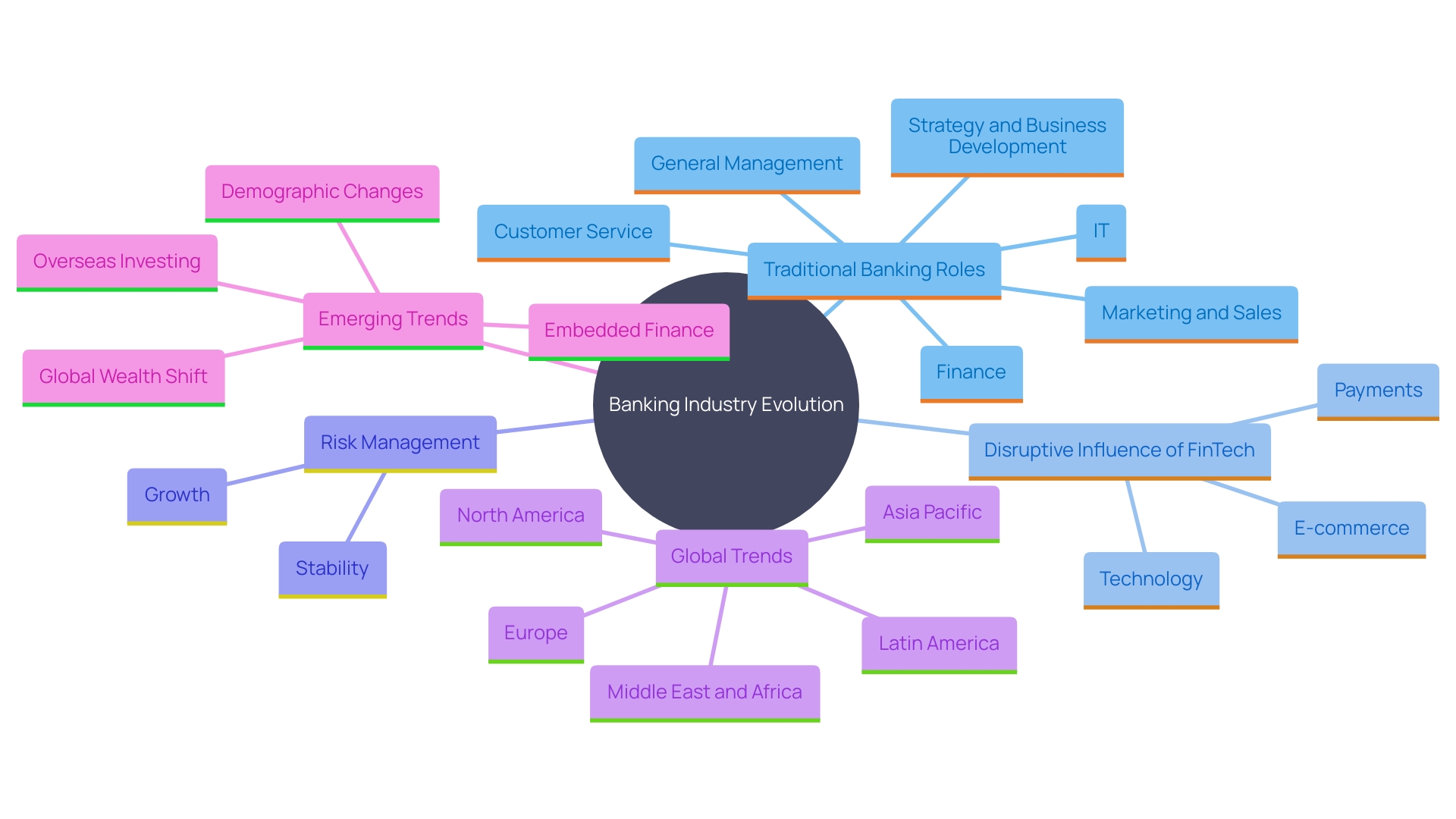
Core Banking Operations
Essential operations, which encompass account management, transaction processing, and customer service, are the heartbeat of any monetary institution. With the advent of modern technology, these activities have become more streamlined and efficient, significantly reducing the time and resources required to complete routine tasks. For instance, TBC Bank, a prominent financial institution in Georgia, has utilized digital advancements to enhance the time-to-market for its products, ensuring an exceptional service experience for both customers and employees.
The shift towards digital banking is not just a trend but a necessity driven by changing consumer habits and competitive pressures. M&T, a leading U.S. commercial institution, has been at the forefront of this transformation, adopting stringent security measures and regulatory compliance to protect sensitive data and transactions. ‘This digital shift has enabled financial institutions to offer a full range of key operations, from seamless user experiences to comprehensive ‘super applications’ that meet diverse customer needs on a single platform.’.
‘The Economist Impact study highlights that financial leaders are focusing on delivering exceptional value to customers while integrating digital tools to enhance the overall experience.’. Digital technologies are transforming every aspect of financial services, from customer interactions to backend operations, ensuring that institutions can function effectively and efficiently in a rapidly evolving economic landscape.

Loan Processing
Loan processing involves evaluating applications, assessing risk, and disbursing funds. Automation has transformed this essential function, allowing financial institutions to analyze data rapidly, make informed lending decisions, and significantly enhance customer experience with faster turnaround times. For instance, the automation of underwriting has streamlined workflows in insurance and financing, boosting productivity and operational efficiency by eliminating time-consuming manual tasks. According to Accenture, early adopters of automation in the financial sector could see a 73% improvement in productivity over the next three years. This technology is reshaping the industry, enabling smarter decision-making and increasing transparency. As Shelli Girard, Vice President of Software Development at Sagent, highlights, AI and automation are revolutionizing the industry, making processes faster and more efficient. By leveraging these advancements, financial institutions can offer better services and maintain a competitive edge in today’s fast-paced financial landscape.
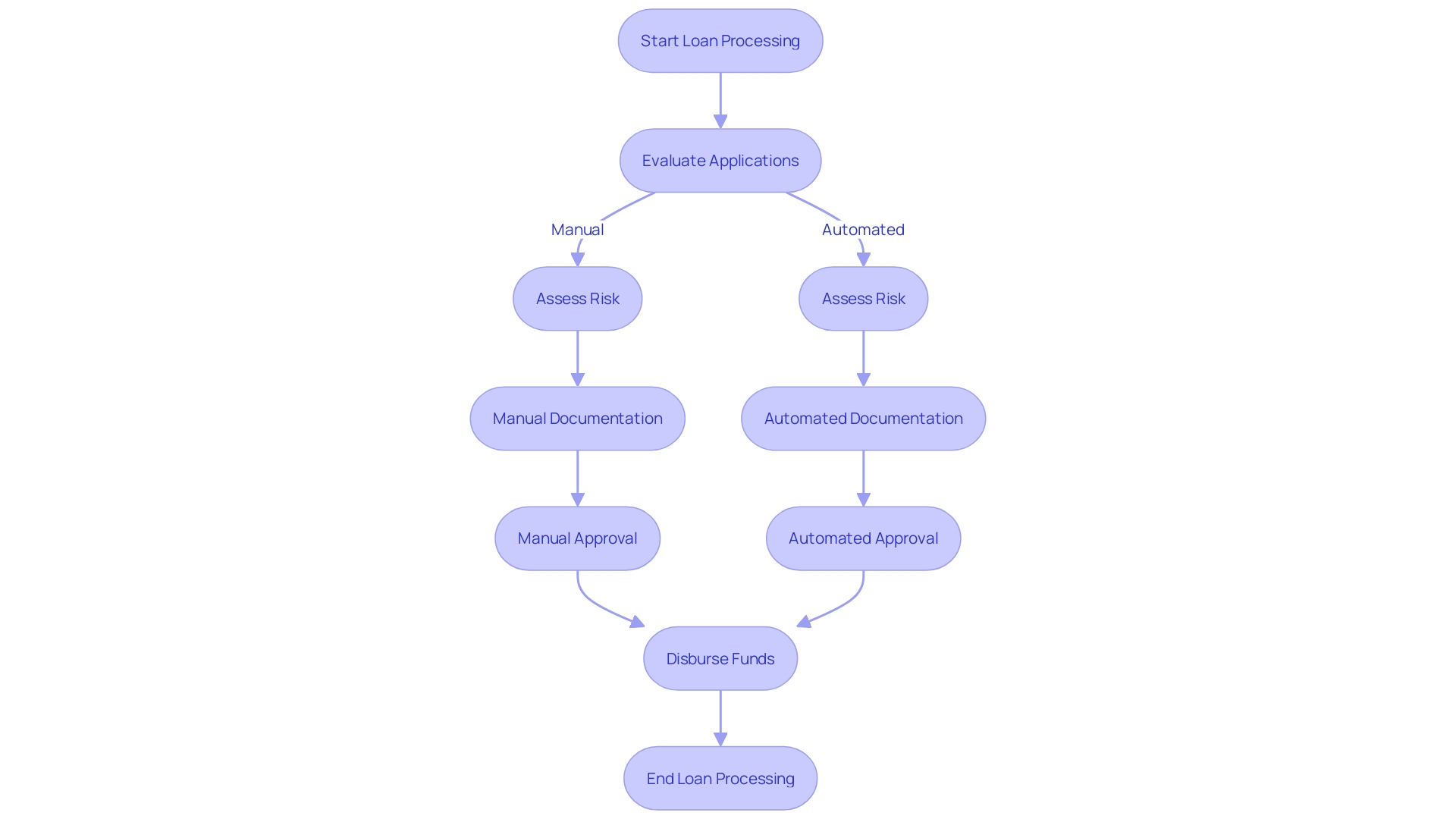
Compliance and Security Measures
Ensuring compliance with regulations is critical in banking. Automation tools, powered by artificial intelligence (AI) and machine learning (ML), enable institutions to monitor transactions, manage risk, and maintain security protocols with unprecedented efficiency. For example, M&T Bank, with its 165-year history, has adopted Clean Code standards to maintain software quality and compliance, ensuring smooth operations and protecting against potential threats.
AI systems can track changes in legislation in real-time, assisting financial institutions in adjusting their compliance strategies promptly. This ability is essential as the monetary sector often undergoes regulatory shifts. According to Adrian Crockett from Microsoft Cloud, hybrid intelligence improves efficiency in tasks such as end-of-day reporting to regulatory authorities, which previously required significant human capital.
The importance of robust fraud prevention cannot be overstated, especially with 74% of organizations falling victim to payment scams last year. Losses are expected to reach $206 billion over the next four years, underscoring the need for advanced fraud detection mechanisms. Traditional rule-based systems are often inadequate for tackling sophisticated fraud schemes. By leveraging AI and ML, financial institutions can detect complex fraud patterns and enhance their fraud prevention strategies, thus maintaining customer trust and organizational integrity.
Banks like Arab National Bank have embraced digital transformation to stay ahead of the curve. With ambitious strategies, they aim to deliver top-notch monetary services while ensuring compliance and security. This forward-looking approach not only safeguards sensitive customer information but also strengthens the institution against the constantly changing environment of financial threats.
The Role of Automation in Banking Operations
Automation significantly enhances efficiency and accuracy in banking operations. By minimizing manual tasks, financial institutions can drastically reduce errors, lower operational costs, and redirect resources toward strategic initiatives. For instance, Capital One’s transition to a cloud-based infrastructure has driven innovation and digital transformation, allowing over 50,000 employees to collaborate and automate work seamlessly. Furthermore, institutions such as M&T emphasize upholding high software quality standards to guarantee seamless operations and compliance, avoiding expensive security breaches and financial losses.
The benefits of automation extend across various sectors within banking. According to a report by Accenture, 73% of the time spent by US bank employees could be impacted by automation, affecting nearly every role from the C-suite to the front lines. This potential for productivity improvement is substantial, with early adopters expected to see significant gains in the next three years. ‘The application of machine learning and AI further drives this transformation, as seen in the adoption of technologies like pandas and TensorFlow for data examination and modeling.’.
Furthermore, the swift acceptance of generative AI in boardrooms highlights its significance in the economic sector. A survey revealed that 98% of respondents from financial services organizations consider generative AI a top agenda item, highlighting its potential to enhance profitability and operational efficiency. Automation is not just a trend but a transformative shift, reshaping the way banks operate and interact with technology.
Future Trends in Banking Operations
The future of banking operations is rapidly advancing towards digital transformation, driven by the integration of cutting-edge technologies. Trends such as artificial intelligence (AI), machine learning, and blockchain are set to greatly transform the industry, encouraging innovation and creating new opportunities for financial sectors. According to Accenture’s analysis, 73% of the time spent by US bank employees could be impacted by generative AI, with 39% attributed to automation and 34% to augmentation. This potential spans across the entire banking spectrum, from the C-suite to frontline services.
The rise of monetary technology, or FinTech, is central to this transformation. Traditional financial institutions face mounting pressure to adapt and innovate in response to these disruptive developments. AI, especially, is becoming essential in the Banking, Financial Services, and Insurance (BFSI) sector, altering the way products and offerings are provided. AI-powered systems enhance cybersecurity by analyzing vast amounts of data in real-time, detecting anomalies, and identifying potential threats, thereby safeguarding sensitive customer information.
Furthermore, as AI continues to integrate into daily operations, companies must stay competitive in an AI-driven world. Generative AI is already being adopted widely, with the highest usage in marketing and sales (34%) and product or service development (23%). This shift not only promises a transformative journey but also highlights the critical balance between innovation and responsibility, setting the stage for a future where finance is more efficient, customer-centric, ethical, and inclusive.
Conclusion
The banking sector stands at a crossroads, driven by the integration of digital technologies and the rise of fintech. Traditional banks are redefining their roles and operations to meet the demands of an increasingly digital landscape. Key functions such as transaction processing, risk management, and customer service are evolving, with automation and artificial intelligence playing pivotal roles in enhancing efficiency and customer experiences.
This transformation is essential not only for maintaining economic stability but also for fostering innovation and resilience within the financial ecosystem.
Core banking operations have become more streamlined, allowing institutions to respond swiftly to changing consumer needs while ensuring compliance and security. Automation in loan processing has revolutionized decision-making, enabling banks to provide faster services and improve operational efficiency. The focus on compliance and security measures has intensified, as advanced technologies help institutions navigate the complexities of regulatory requirements and protect against fraud.
Looking ahead, the future of banking operations is being shaped by emerging trends in AI, machine learning, and blockchain technology. These innovations promise to enhance service delivery and operational capabilities, creating a more customer-centric and efficient financial environment. As the industry adapts to these changes, banking leaders are empowered to embrace a proactive approach, leveraging technology to not only meet challenges but also seize new opportunities for growth and success.
Introduction
In today’s fast-paced business environment, staying ahead of the competition requires more than just traditional methods. The integration of artificial intelligence (AI) has become a cornerstone for driving business success, offering transformative benefits that span across decision-making, operational efficiency, and customer experience enhancement. This article delves into the pivotal role of AI in modern business, exploring how AI strategy consulting can provide tailored solutions that align with organizational goals.
It also highlights the importance of effective implementation and training, underscoring how these elements contribute to a seamless AI adoption process. Furthermore, the article examines the critical metrics for measuring AI’s impact on business performance, ensuring that companies can continuously optimize their strategies and harness the full potential of AI-driven innovations.
The Importance of AI in Business Success
In an increasingly competitive landscape, businesses must leverage the power of artificial intelligence (AI) to stay relevant and drive growth. AI enables organizations to enhance decision-making, streamline operations, and improve customer experiences. For example, automating identity verification and simple order inquiries can significantly reduce manual, repetitive tasks, providing quick wins in terms of efficiency and cost reduction. According to a recent report, 42% of companies with 10 or fewer employees are now using AI tools, underscoring its accessibility and impact.
Furthermore, the acquisition of MarketMuse by Siteimprove emphasizes Ai’s role in enhancing content development and planning, showcasing its worth beyond conventional uses. Organizations can access new sources of income, lower expenses, and innovate more rapidly by incorporating AI into fundamental operational plans. Experts like Dr. Rachel J.C. Fu emphasize that Ai’s transformative power can supercharge productivity, offering a competitive edge in today’s market.
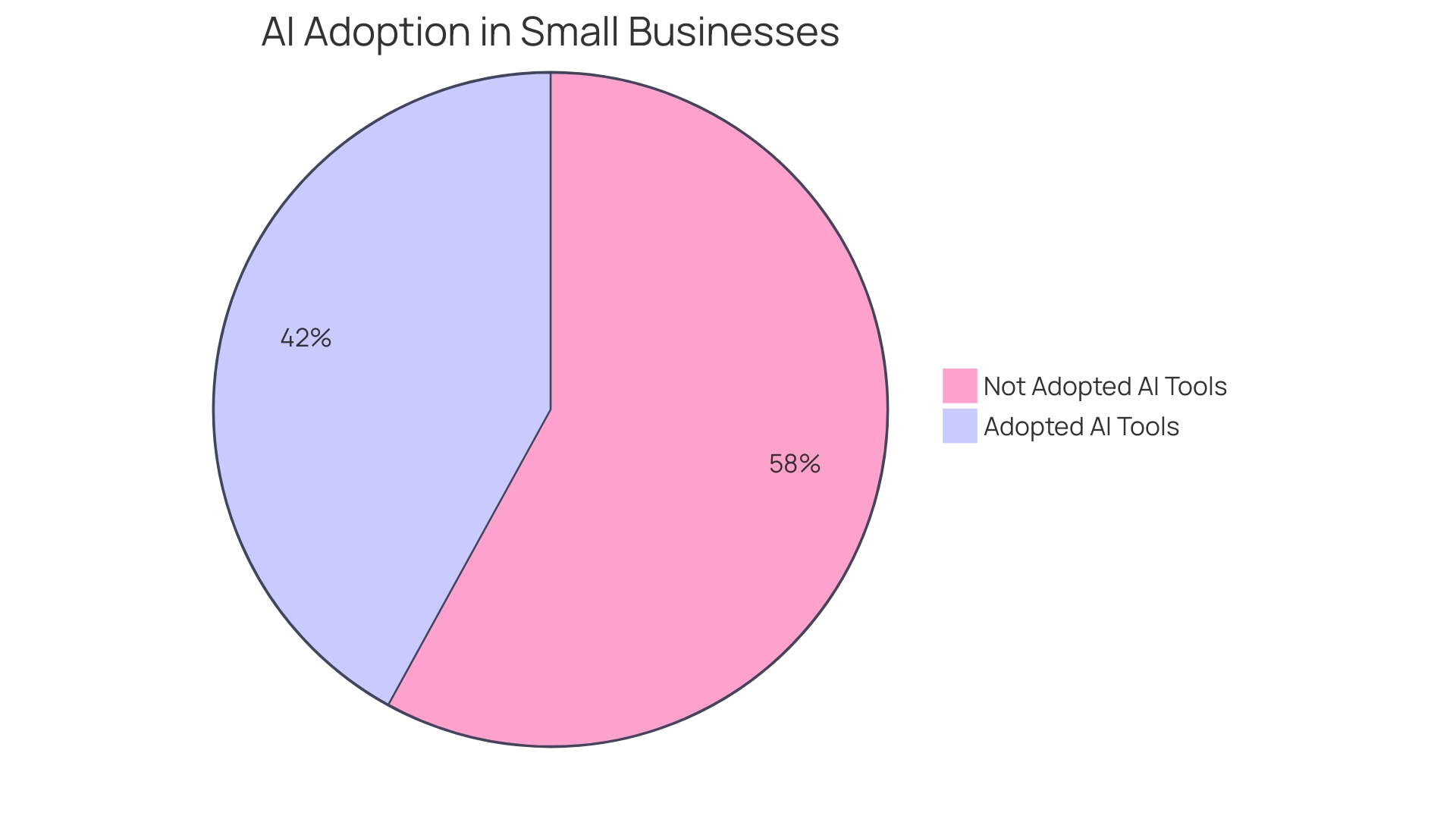
Key Benefits of AI Strategy Consulting
AI consulting provides a multitude of advantages for organizations aiming to implement AI solutions effectively. These benefits encompass tailored strategies that align seamlessly with organizational objectives, thereby ensuring that AI initiatives are not only innovative but also relevant to the company’s goals. By leveraging automation, AI consultants can significantly enhance operational efficiency, which is crucial for businesses striving to stay competitive.
A critical aspect of AI consulting is the improvement of data-driven decision-making processes. This is achieved through advanced data analytics and machine learning models that provide deep insights and predictive capabilities. AI consultants provide extensive expertise in best practices, which assists entities in reducing risks linked to AI adoption. This is particularly important given the rapid evolution of AI technologies and the continuous emergence of new enterprise solutions, models, and use cases.
Moreover, AI consultants play a pivotal role in navigating the complexities of AI adoption. They provide training and knowledge transfer to internal teams, ensuring that the entity is equipped not just with a strategy but also with the understanding and tools needed for effective implementation. This holistic approach is essential for fostering an AI-ready culture within the entity.
The impact of AI consulting is further validated by real-world success stories. For example, Creative Dock, the largest independent corporate venture builder in Europe and MENA, reported a 70% year-to-year revenue increase following strategic AI-driven acquisitions. Such examples highlight the potential of AI to drive significant growth and transformation in enterprises.
In summary, AI strategy consulting is a multifaceted service that not only provides customized strategies and operational enhancements but ensures that organizations are well-prepared to harness the full potential of AI. By integrating AI consulting services, businesses can streamline operations, enhance decision-making, and create new avenues for growth and innovation.
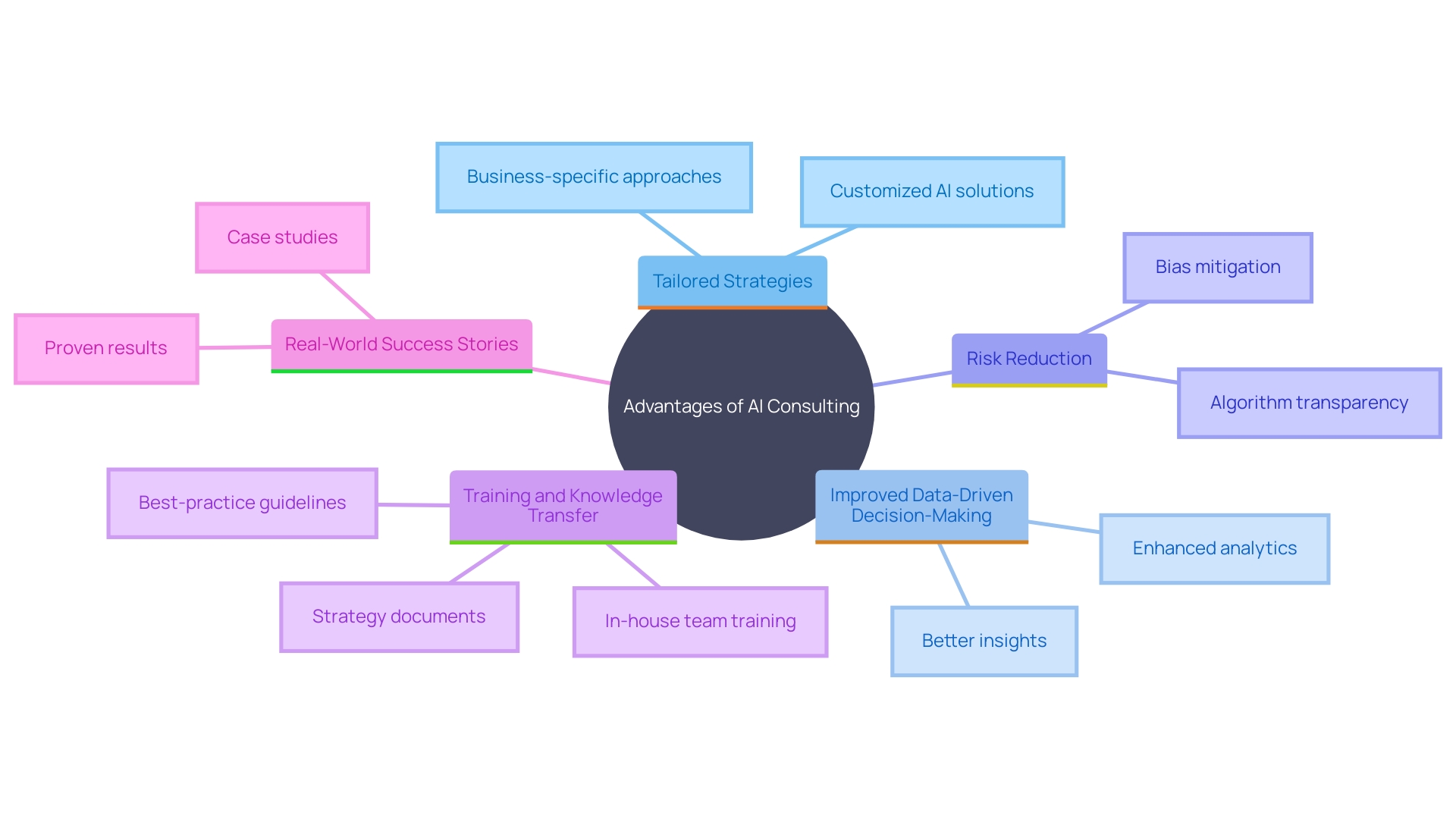
Implementing AI Solutions: Integration and Training
Successful AI implementation hinges on seamless integration with existing systems and processes. Organizations must prioritize developing comprehensive training programs to empower employees with the skills needed to effectively utilize AI tools. This involves tackling change management obstacles and promoting a culture of collaboration, ensuring teams not only adopt new technologies but recognize their value.
The journey to AI integration often begins with a critical evaluation phase. For instance, many companies initially restrict the use of AI technologies like Large Language Models (LLMs) until legal and security implications are thoroughly assessed. During this period, engineers frequently experiment with AI in personal projects, building a strong interest that can be leveraged once organizational adoption begins.
A robust training program plays a pivotal role in bridging the knowledge gap. Despite the rapid adoption of AI, there remains a significant divide between those proficient in its use and those who are not. Higher-income workers and executives are more likely to adopt AI, while employees across all levels express a desire for organizational training programs. Providing training can democratize AI use, ensuring that all employees can contribute to and benefit from AI-driven initiatives.
Moreover, creating a culture that embraces AI requires transparent communication about its benefits and potential. According to Ipsos research, the most successful AI initiatives prioritize strategic planning and clear communication. By concentrating on these areas, entities can tackle opposition to change, motivating employees to view AI as a resource that improves rather than endangers their positions.
In summary, the roadmap to successful AI implementation involves not only the technical integration of AI systems but also the cultivation of a supportive organizational culture. Through comprehensive training and strategic planning, entities can overcome the challenges of AI adoption and unlock its full potential for enhanced productivity and innovation.
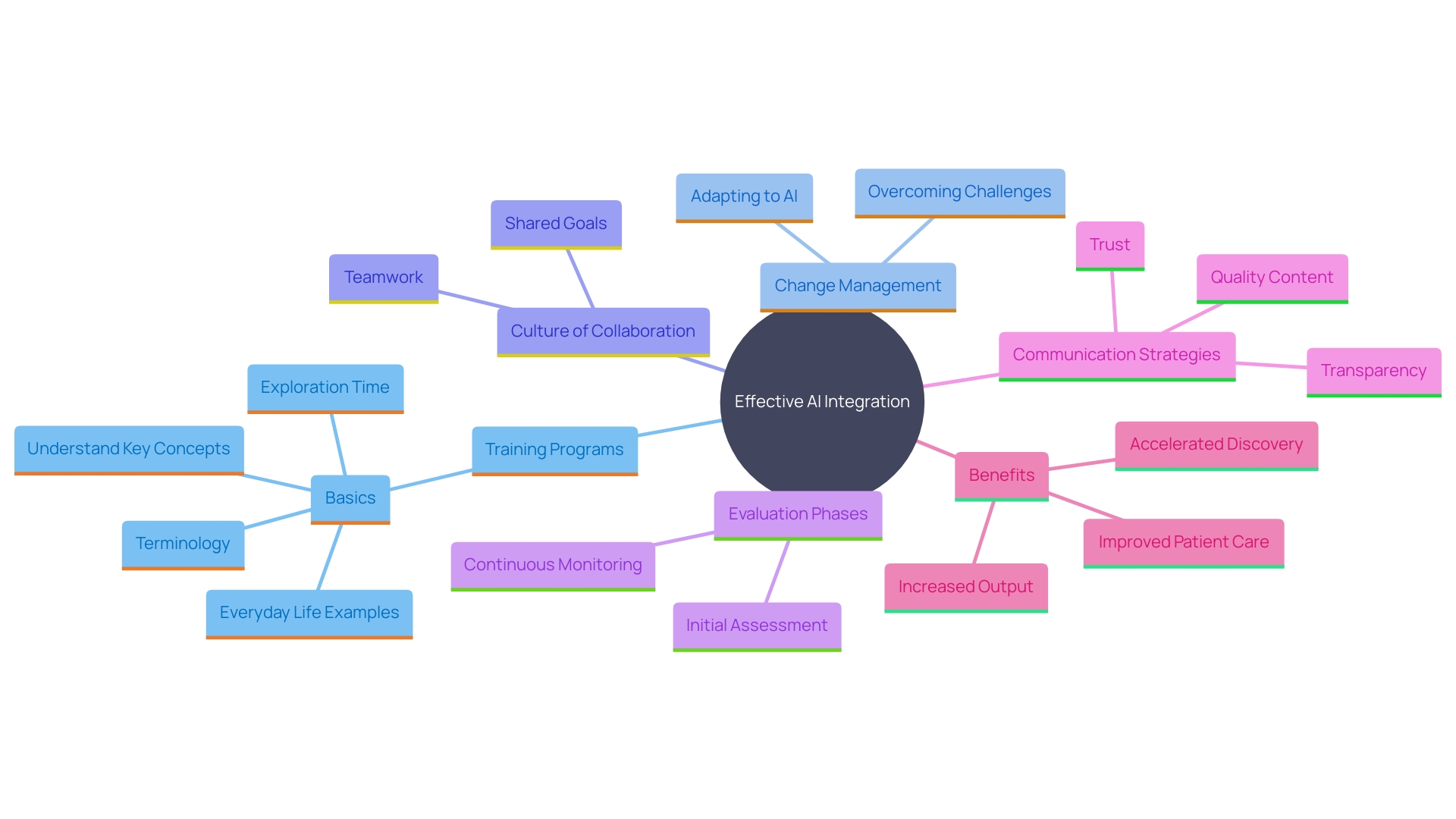
Measuring the Impact of AI on Business Performance
To genuinely utilize the benefits of AI investments, entities need to establish key performance indicators (KPIs) that accurately evaluate the effect of AI initiatives on operational results. The Artificial Intelligence and Business Strategy initiative reveals how AI influences strategic development and execution within organizations. By continuously tracking these metrics, organizations can accurately identify areas for enhancement, confirm the success of their AI approaches, and make knowledgeable choices to improve performance. This approach mitigates the risk of relying on outdated metrics, which can lead to misguided performance measures, as seen in the 2008 financial crisis. Additionally, the continuous surge in AI research, doubling every 23 months, underscores the necessity for adaptable KPIs that evolve alongside technological advancements. According to David Kiron, the editorial director of MIT Sloan Management Review, and Michael Schrage, a research fellow at MIT Sloan School of Management, understanding and leveraging behavioral economics and metrics as strategic resources are crucial for managing innovation opportunities and risks. This perspective is also supported by Francois Candelon of the Boston Consulting Group, who emphasizes the transformative impact of technology on business strategy.
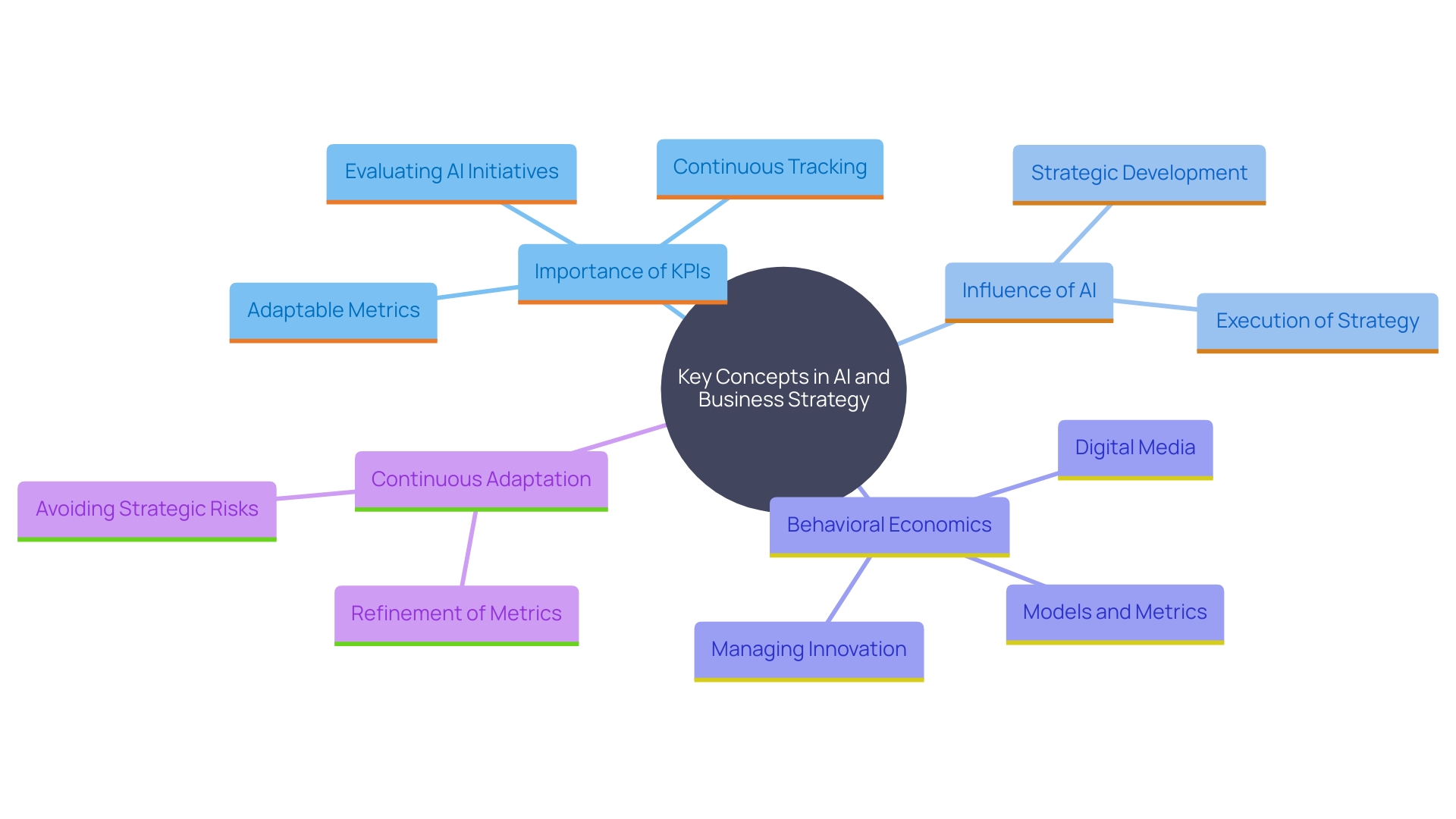
Conclusion
The integration of artificial intelligence (AI) is vital for businesses seeking growth and operational efficiency. By enhancing decision-making, streamlining operations, and improving customer experiences, AI has become a transformative force across various sectors.
AI strategy consulting is crucial for effective implementation. Tailored strategies ensure that AI initiatives align with business objectives, while insights from data analytics empower informed decision-making. Consultants also facilitate training and knowledge transfer, fostering a culture that embraces AI technologies.
Successful AI implementation involves both technical integration and a supportive organizational culture. Comprehensive training programs address knowledge gaps and change management challenges, enabling employees to view AI as an asset rather than a threat.
Measuring AI’s impact through defined key performance indicators (KPIs) is essential for optimizing performance. Continuous monitoring allows organizations to validate their AI strategies and adapt to evolving technology. Ultimately, embracing AI is about transforming mindsets and unlocking its full potential for business success.
Introduction
In the rapidly evolving world of manufacturing, the integration of artificial intelligence (AI) and automation technologies is no longer just an option; it has become a necessity for organizations aiming to thrive. As industries strive for greater efficiency and adaptability, AI-driven solutions are leading a transformative wave that promises to redefine operational processes. The recent resurgence in the U.S. manufacturing sector, marked by a remarkable increase in shareholder returns, underscores how embracing these innovations can unlock unprecedented levels of productivity and resilience.
From predictive maintenance to the rise of smart factories powered by the Internet of Things (IoT), the landscape is rich with opportunities for businesses ready to innovate. This article delves into the latest trends shaping industrial automation, highlighting practical strategies that can empower organizations to navigate challenges, enhance sustainability, and secure a competitive edge in the Fourth Industrial Revolution.
AI-Driven Automation in Manufacturing
The integration of artificial intelligence (AI) into manufacturing processes is not merely a trend; it is a transformative force shaping the future of the industry. By harnessing advanced machine learning algorithms, manufacturers are achieving unprecedented levels of optimization in their operations. This includes refining production schedules, predicting equipment failures before they occur, and elevating quality control measures to new heights.
Recent developments show that the US manufacturing sector, which had seen sluggish growth of just 1.4 percent over two decades, is now experiencing a renaissance. During the past five years, industrial firms have produced shareholder gains that are roughly 400 basis points greater than those of the preceding 15 years, primarily because of the adoption of AI and digital advancements. This resurgence illustrates how AI-driven mechanization not only reduces downtime but also improves efficiency, enabling manufacturers to quickly adjust to changing market demands.
One notable advancement in AI innovation comes from the Korea Institute of Machinery and Materials, where a research team has successfully developed AI solutions for robotic applications in manufacturing. This new innovation enables the automation of tasks based on user instructions, significantly enhancing productivity and functional flexibility.
As Daniel D. Gutierrez, a prominent data scientist and technology journalist, highlights, AI is leading the charge into what is known as Industry 4.0, transforming the entire value chain from supply chain management to quality assurance. The ongoing Fourth Industrial Revolution is fostering greater workforce inclusivity and sustainability, thereby opening up new avenues for both innovation and growth in the manufacturing sector.
In this dynamic landscape, predictive maintenance stands out as one of Ai’s most significant contributions, further solidifying its role in enhancing production efficiency. As manufacturers continue to integrate AI into their processes, they are not just enhancing their performance metrics but are also setting the stage for a more resilient and responsive industrial ecosystem.
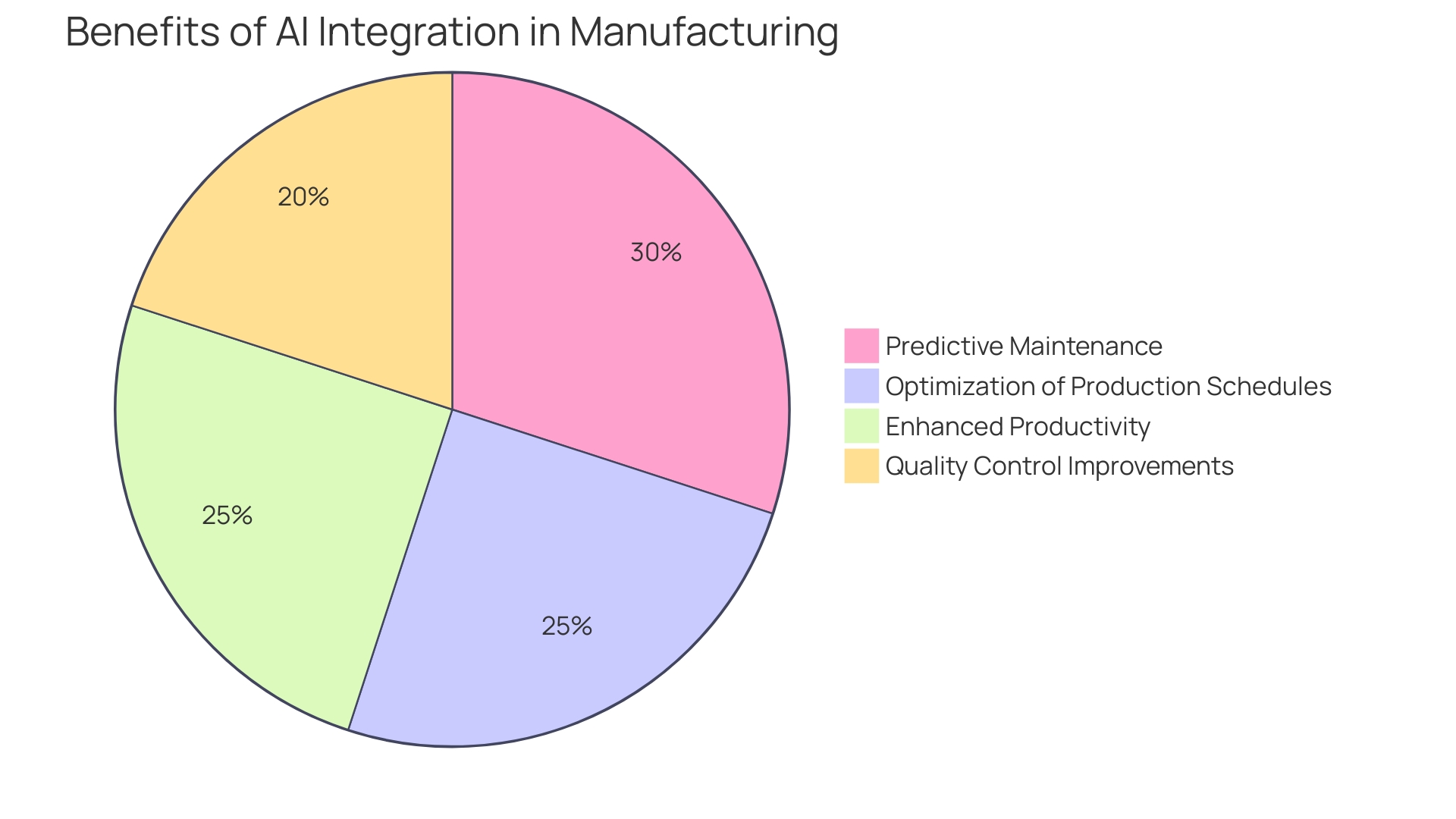
Emerging Trends in Industrial Automation
As industries advance, several prominent trends are redefining the landscape of automation. The rise of smart factories, driven by the Internet of Things (IoT) and real-time data analytics, is transforming efficiency in operations. These connected environments enable seamless communication between machines and systems, leading to enhanced productivity and reduced downtime. For example, in the US manufacturing industry, a resurgence driven by AI and digital advancements has led to total shareholder returns that are 400 basis points greater than those of the past 15 years, illustrating the substantial effect of these innovations.
Moreover, the transition towards customizable automation solutions empowers businesses to tailor their processes according to unique operational requirements. This adaptability not only supports innovation but also bolsters competitiveness in a rapidly evolving market. Companies are increasingly focusing on problem-solving and lean foundations, identifying core challenges and optimizing existing processes before integrating new technologies.
Events like SPS 2023 highlight the global interest and commitment to these trends, showcasing intelligent concepts for control and visualization. Attendees from various sectors engage in expert discussions, gaining insights into the latest advancements and sharing best practices. Such collaborative environments are essential for fostering continuous improvement and learning among industry players, ultimately driving the Fourth Industrial Revolution forward.
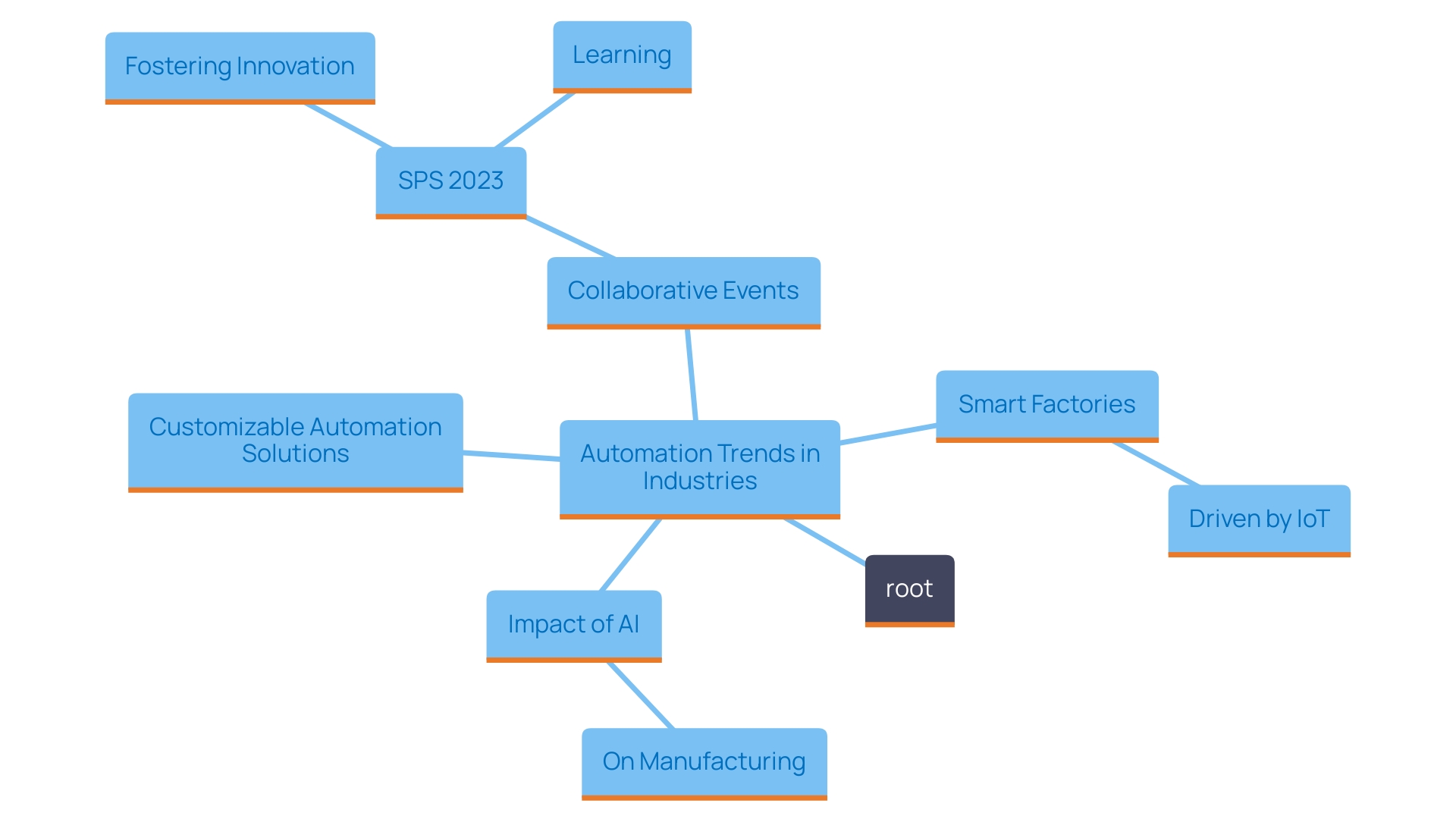
Trend 1: Increased Adoption of AI and Machine Learning
Organizations are increasingly leveraging the capabilities of artificial intelligence (AI) and machine learning to transform their automation processes. ‘These advancements empower businesses with predictive analytics, enabling them to make informed, data-driven decisions.’. By automating routine tasks, companies can redirect their focus towards complex problem-solving, thus unlocking new efficiencies.
The manufacturing sector has particularly benefited from this trend. For instance, the US manufacturing industry, which had seen a stagnant growth rate of merely 1.4% over the past two decades, has recently experienced a resurgence. The integration of AI, digital technologies, and sustainable practices has led to a remarkable increase in total shareholder returns—approximately 400 basis points higher than in the previous fifteen years. This resurgence exemplifies how the Fourth Industrial Revolution (4IR) is not only enhancing efficiency but also fostering workforce inclusivity and sustainability.
As industries navigate an increasingly volatile environment marked by disruptions such as geopolitical tensions and climate change, the expectation of interruptions in operations is projected to rise by 15 to 25% over the next five years. This emphasizes the critical significance of adopting strong mechanization strategies.
AI is being recognized as a key driver in this evolution, with over 30% of organizations indicating that sustainability initiatives influence their AI adoption. However, it is essential to note that while sustainability is a consideration, the primary drivers remain cost savings and improved operational efficiencies.
The application of AI and mechanization methods adheres to an S-curve model. Initially, organizations experience a learning phase characterized by trial and error. Once essential systems are established, companies transition into a deployment phase, culminating in an optimization stage where standardized practices are integrated, leading to stabilized costs. ‘This pattern reflects historical trends noted in previous industrial revolutions, illustrating the transformative potential of AI and mechanization across various sectors.’.
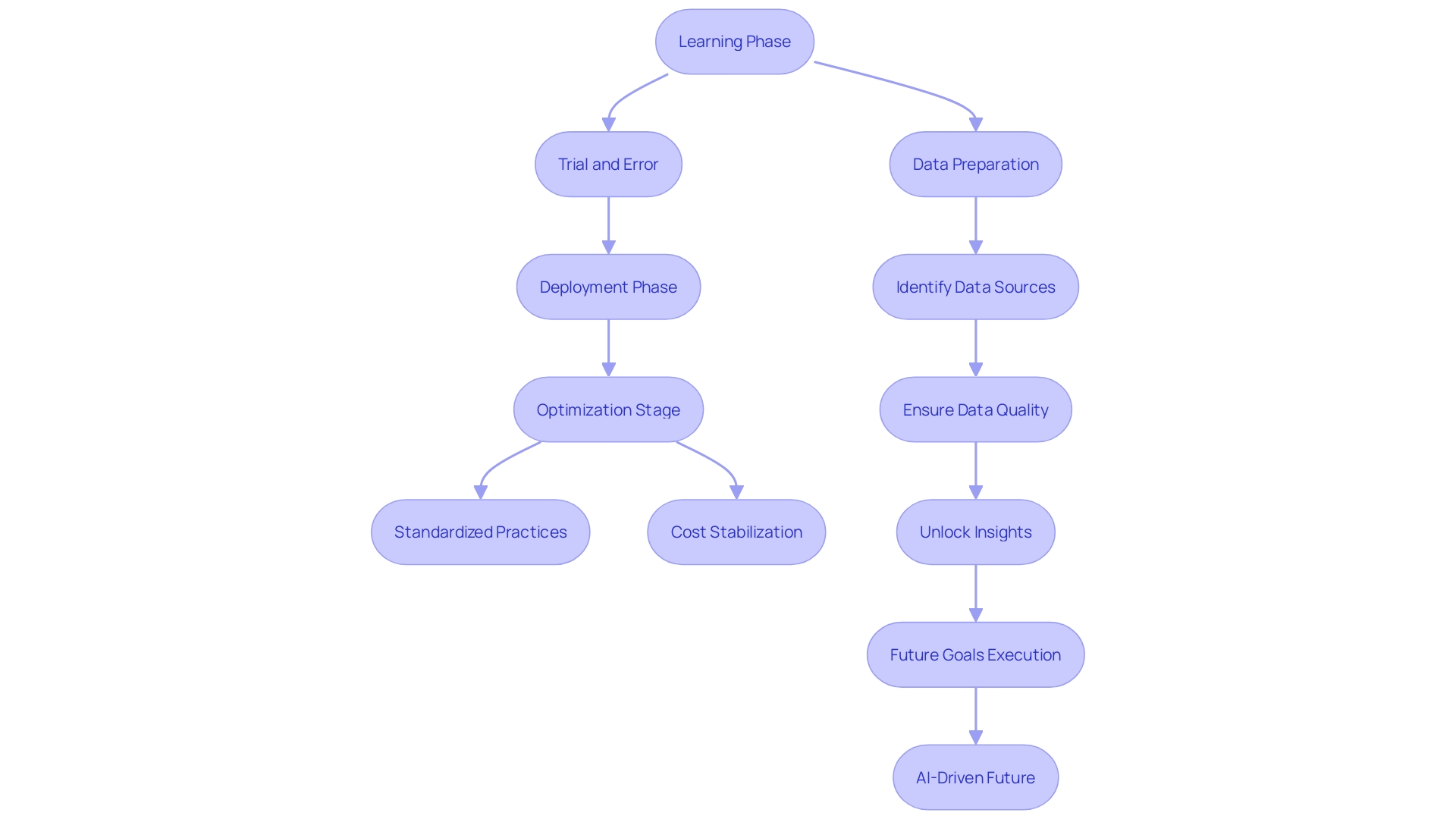
Trend 3: Integration of 5G in Industrial Automation
The advent of 5G technology promises to significantly transform industrial automation by enabling rapid, high-speed connectivity and near-instantaneous communication between devices. This enhanced connectivity is particularly beneficial for Internet of Things (IoT) applications, allowing for seamless real-time data exchange. With 5G, manufacturers can process data more quickly and accurately, which leads to improved decision-making and operational responsiveness.
Research indicates that industries such as manufacturing and transportation, which account for a substantial portion of global energy consumption—54% and significant greenhouse gas (GHG) emissions—stand to gain immensely from 5G integration. For instance, a typical internal combustion engine produces approximately 66 tons of GHG emissions throughout its lifetime, emphasizing the critical need for more sustainable approaches in these sectors.
Notably, the 5G landscape has seen remarkable growth, employing approximately 1.3 million individuals and adding over 79,000 jobs in the past year alone. This surge not only reflects the expanding influence of 5G but also underscores its pivotal role in driving skill development and job creation within the economy.
Moreover, as organizations implement 5G solutions, they encounter challenges that require strategic problem-solving and innovative approaches. The ongoing digital transformation initiatives provide valuable insights into overcoming these obstacles, with lessons learned that can guide other manufacturers in their process improvements. By leveraging 5G, companies can optimize their operations, enhance sustainability efforts, and ultimately align with consumer and regulatory demands for energy efficiency and reduced carbon footprints.
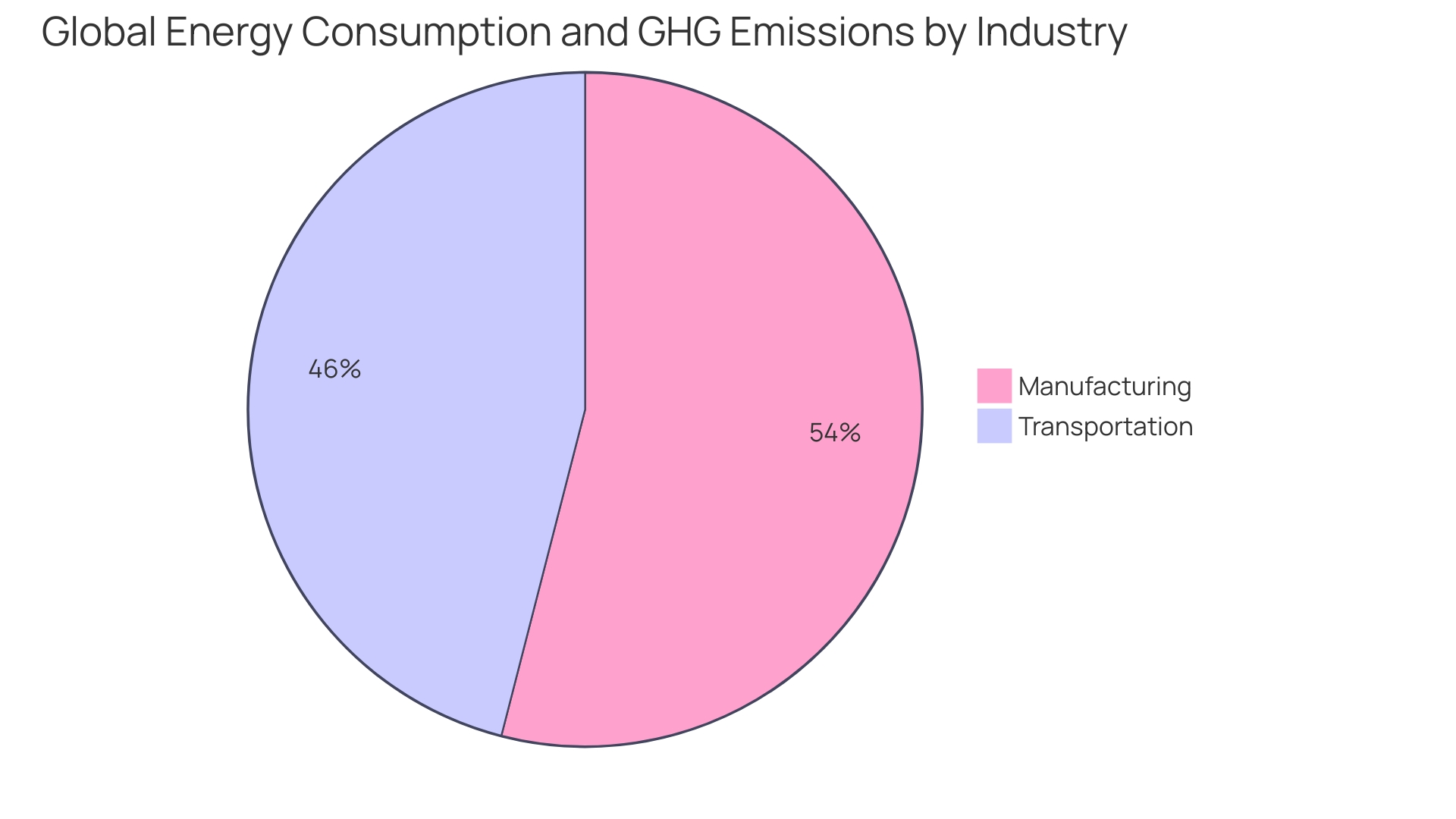
Sustainable Automation Practices
As organizations increase their commitment to sustainability, the incorporation of eco-friendly practices within operational strategies has become essential. Sustainable automation not only refers to energy-efficient processes and waste reduction but also involves the utilization of renewable resources. This shift is exemplified by industry leaders like Bosch, which has focused on making energy production more efficient and increasing access to green energy since its inception in 1886. Their innovative approaches highlight how technology can play a pivotal role in addressing climate challenges while meeting the growing electricity demand.
Rivian, an electric vehicle manufacturer, has set ambitious goals for achieving net-zero emissions by 2040. This commitment underlines the importance of sustainable raw material sourcing and waste minimization throughout their supply chain, showcasing how a focus on sustainability can drive operational efficiencies and foster innovation.
Furthermore, as highlighted in recent trends, the convergence of mechanization and sustainability is becoming increasingly pronounced. For instance, the introduction of EcoStruxure Automation Expert marks a significant evolution in automation techniques by promoting a more open and flexible approach, diverging from traditional methods. This flexibility allows companies to adapt their operations to be more sustainable while optimizing performance.
Consumer preferences are also changing, with a growing emphasis on sustainable methods influencing buying choices. According to recent surveys, the top five environmentally sustainable approaches that consumers prioritize include sustainable packaging, waste reduction in manufacturing, ethical working methods, respect for human rights, and biodiversity protection. These factors not only resonate with environmentally-conscious consumers but also enhance brand reputation, making sustainability a competitive advantage in today’s market.
In conclusion, the integration of sustainable practices into automation is not just a regulatory compliance measure, but a strategic move that can enhance brand loyalty, improve operational efficiency, and position organizations favorably in a rapidly changing marketplace.
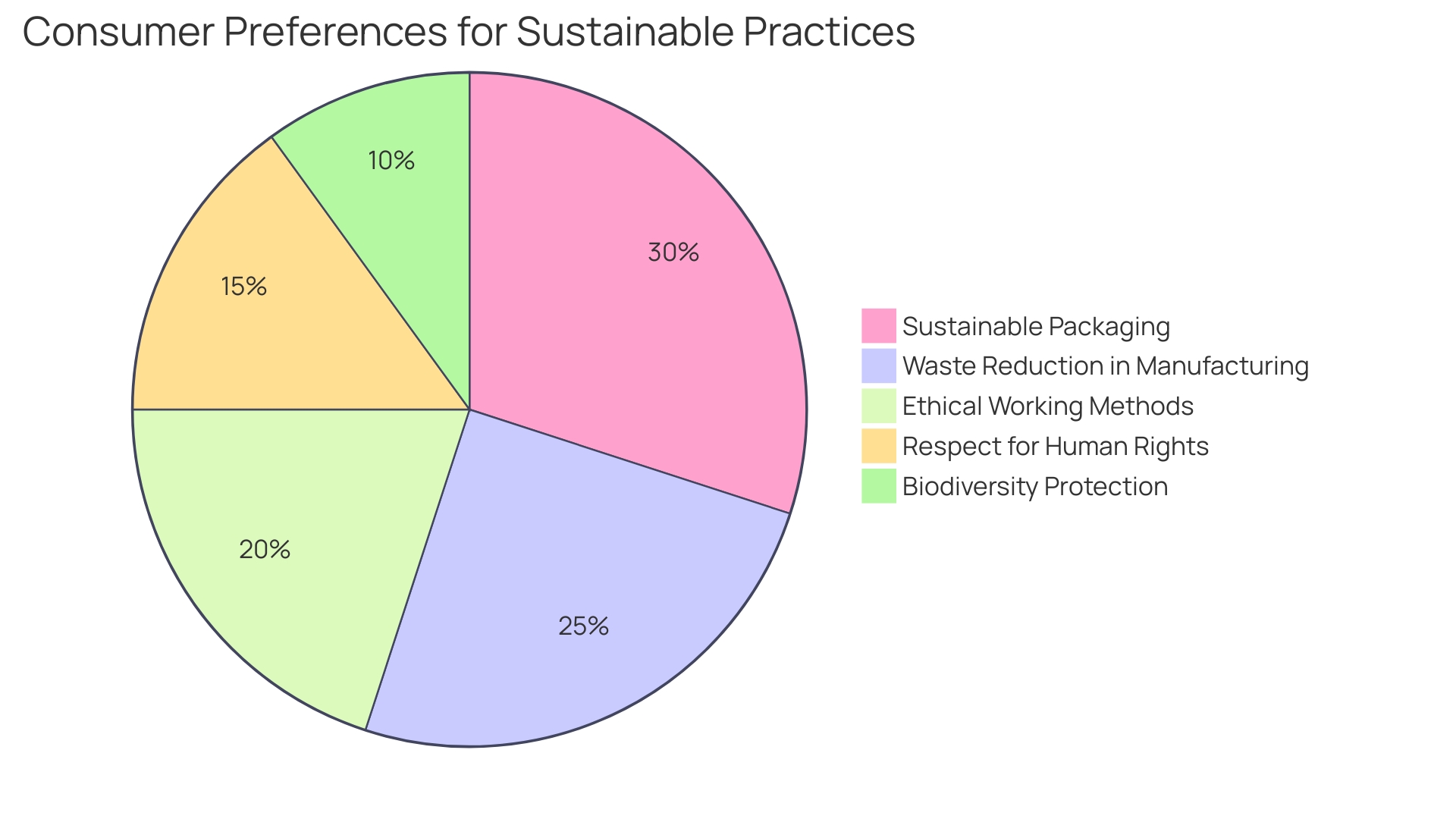
Conclusion
The integration of artificial intelligence and automation technologies is revolutionizing the manufacturing landscape, driving unprecedented levels of optimization and operational efficiency. As organizations harness these innovations, they are experiencing significant improvements in predictive maintenance, production schedules, and quality control. The resurgence of the U.S. manufacturing sector, with shareholder returns soaring due to AI and digital advancements, exemplifies the transformative potential of these technologies.
Emerging trends such as the rise of smart factories and the adoption of customizable automation solutions further underline the importance of adaptability in today’s fast-paced environment. The ability to tailor automation processes to meet specific operational needs not only fosters innovation but also strengthens competitiveness. Industry events, like SPS 2023, demonstrate the collective commitment to sharing knowledge and best practices, driving continuous improvement within the sector.
As AI and machine learning become integral to operational strategies, organizations are positioned to navigate future disruptions effectively. The adoption of 5G technology enhances connectivity, enabling real-time data exchange and improved decision-making. This shift towards a more connected and responsive industrial ecosystem aligns with the growing emphasis on sustainability, as companies increasingly integrate eco-friendly practices into their automation strategies.
Ultimately, the convergence of AI, automation, and sustainability is not just about regulatory compliance; it represents a strategic approach that enhances brand loyalty, boosts operational efficiency, and secures a robust competitive advantage. Embracing these innovations will empower organizations to thrive in the evolving landscape of the Fourth Industrial Revolution, ensuring resilience and adaptability in the face of future challenges.
Introduction
The convergence of Artificial Intelligence (AI) and the Internet of Things (IoT) is reshaping the operational landscape across various industries, giving rise to a powerful framework known as AIoT. By merging the extensive data-gathering capabilities of IoT devices with the analytical prowess of AI algorithms, organizations are unlocking new levels of efficiency and innovation. This integration not only empowers businesses to make informed decisions but also streamlines automation processes, ultimately enhancing performance metrics and reducing costs.
From revolutionizing supply chains, as seen in Renault’s data-driven approach, to transforming healthcare with remote patient monitoring, the applications of AIoT are vast and impactful. As industries continue to embrace this technological synergy, understanding the core components, benefits, and challenges of AIoT integration becomes essential for those aiming to maintain a competitive edge in a rapidly evolving market.
What is AIoT: The Convergence of AI and IoT
The convergence of Artificial Intelligence (AI) and the Internet of Things (IoT) has given rise to a transformative framework known as AIoT, which significantly enhances operational capabilities across various industries. This integration utilizes the extensive information-gathering abilities of IoT devices, which monitor and collect insights from their environments, and couples it with the analytical power of AI algorithms. By examining this information, organizations can uncover actionable insights that drive smarter decision-making and streamline automation processes.
For instance, Renault’s supply chain exemplifies the effectiveness of AIoT. ‘Since the establishment of a repository in 2017, which consolidated 100% of the supply chain’s information by 2021, Renault has harnessed this structured information to create a control tower in collaboration with partners like Shippeo.’. This control tower allows for precise management of factory supply logistics, ensuring that the status of incoming shipments is always monitored and optimized. As Ludovic Doudard, General Manager of Process Engineering Supply Chain at Renault, stated, “While we have digitized and structured our processes well, our information relies on information systems, it is thus naturally structured.”
Moreover, the oil and gas sector is undergoing a significant transformation as it increasingly adopts artificial intelligence and Internet of Things technologies for leak detection. The industry’s push for continuous measurement systems to monitor fugitive emissions has highlighted the necessity of integrating AI with IoT capabilities. Methane, for example, is recognized as having a global warming potential 84% more potent than CO2, emphasizing the urgency for real-time monitoring solutions.
With intelligent interconnected devices, organizations are not merely gathering information; they are deriving value from it. This strategic approach enables them to enhance efficiency, reduce costs, and improve key performance indicators (KPIs) relevant to their operations. Research has shown that successful implementations of AIoT can lead to improved overall equipment effectiveness (OEE) and significant cost savings, illustrating the importance of integrating modern technological solutions into existing business processes.
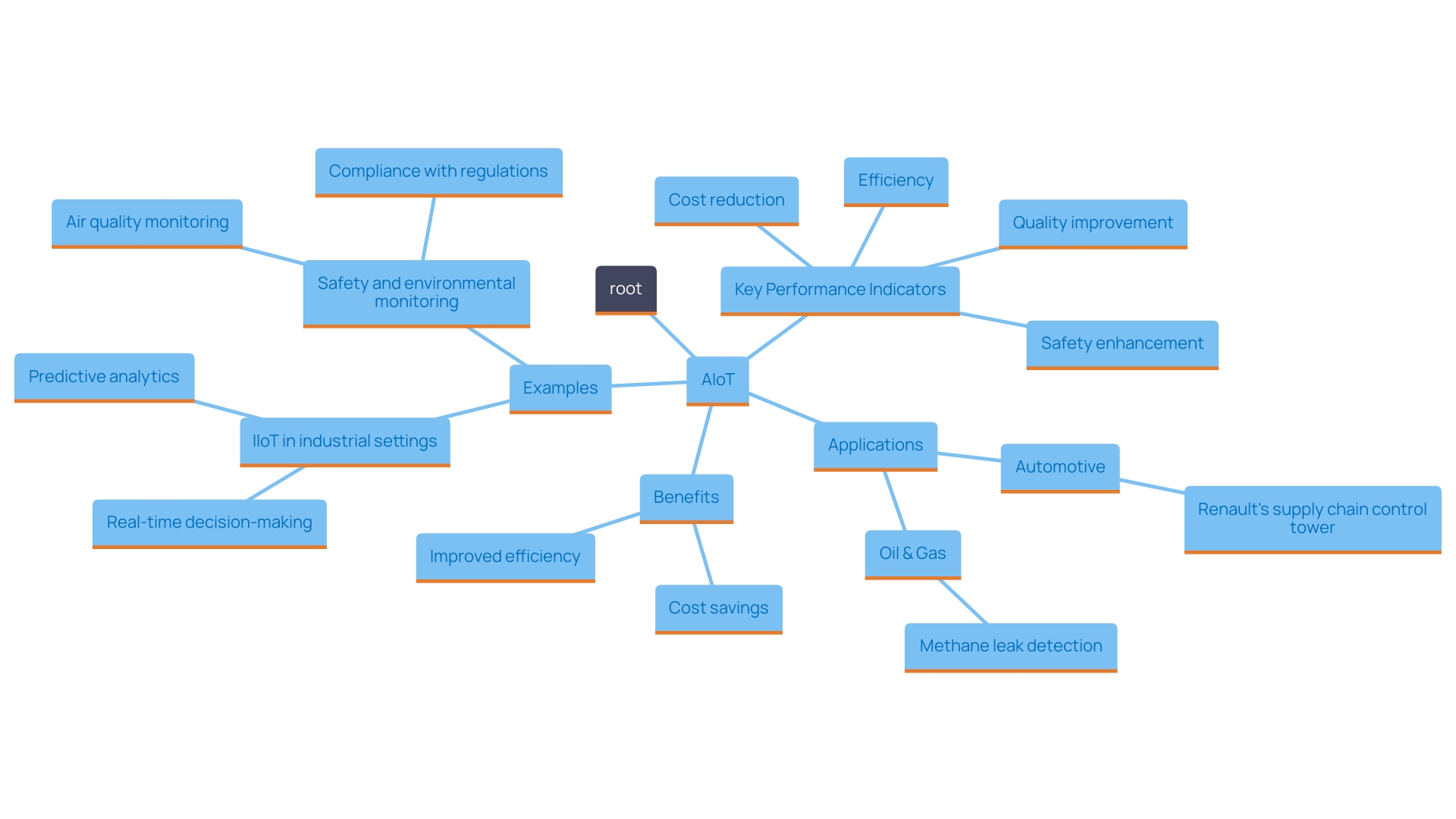
Benefits of AIoT Synergy
The integration of Artificial Intelligence (AI) and the Internet of Things (IoT) revolutionizes business operations by significantly enhancing efficiency and productivity. With the capability to automate processes and enable real-time information analysis, organizations can respond swiftly to changing market dynamics. ‘For instance, a recent study analyzed 22 implementations of IoT technologies and documented various outcomes, including improved Overall Equipment Effectiveness (OEE) and reduced expenses. This integration not only streamlines workflows but also drives innovation, enabling companies to maintain a competitive edge in a fast-paced environment.
In practical terms, the IoT serves as a network of interconnected devices equipped with sensors that gather and exchange data, ranging from simple household items to complex industrial machinery. This connectivity allows for the monitoring of critical parameters such as machine performance and energy consumption, enabling organizations to identify patterns and anomalies in real time. Furthermore, as emphasized by industry specialists, concentrating on automating low-complexity, repetitive tasks frequently results in the most substantial quick wins in efficiency.
The challenges encountered during these implementations often revolve around aligning technology with existing processes. Companies have found success by narrowing their focus to areas that are manual and costly, effectively mapping out the necessary stakeholders and systems involved. This strategic approach not only enhances efficiency in operations but also fosters a culture of continuous improvement and innovation, paving the way for organizations to thrive amid evolving industry standards and consumer expectations. As the industrial connectivity market is expected to expand considerably—from $89 billion in 2023 to $104 billion by 2028—companies adopting this technological landscape stand to gain substantial advantages in their frameworks.
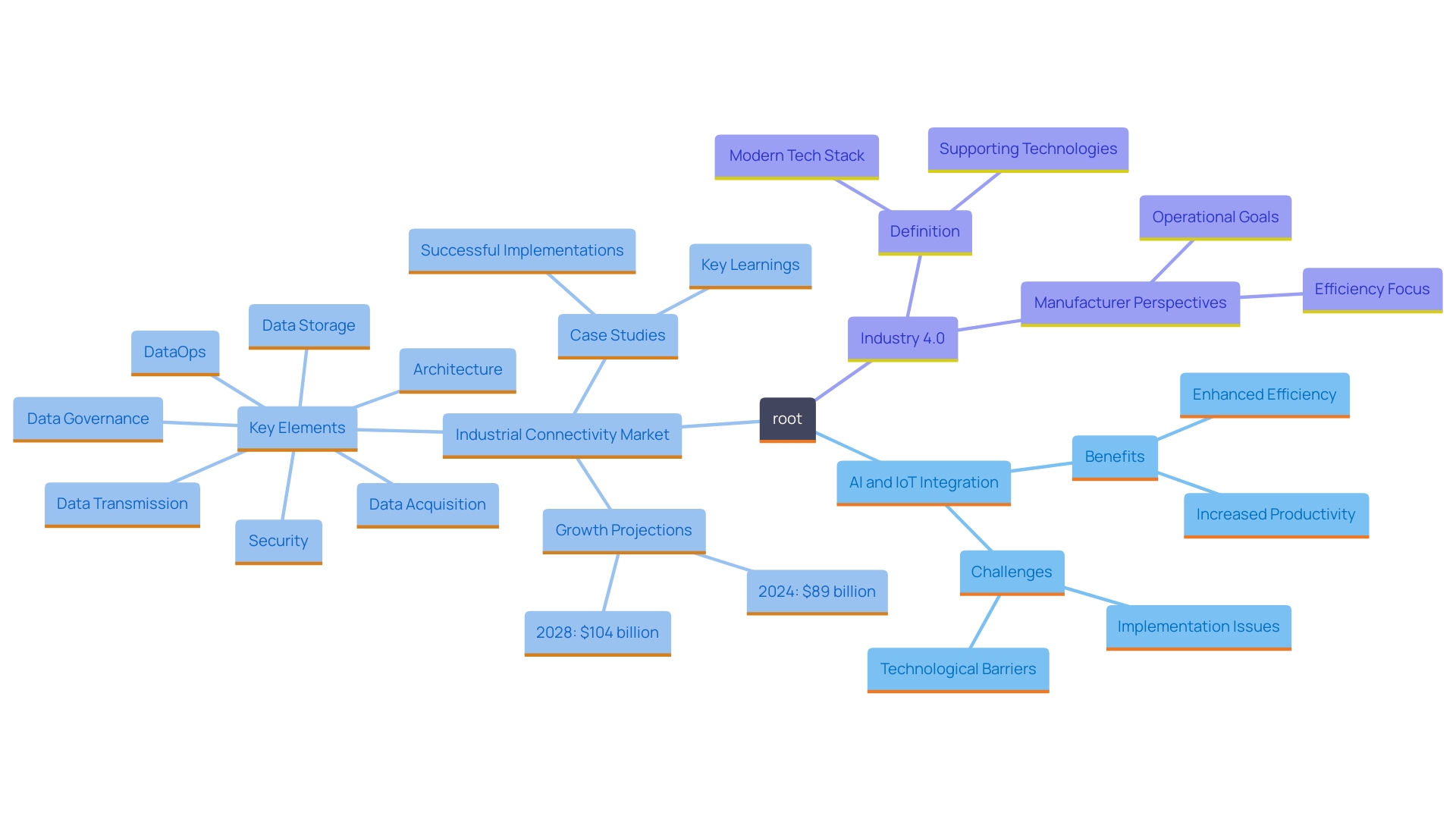
Applications of AIoT in Various Industries
The combination of Artificial Intelligence and the Internet of Things is transforming sectors like manufacturing, healthcare, and transportation, offering substantial improvements in efficiency and service delivery.
In the manufacturing sector, intelligent solutions are transforming production processes through advanced information analysis and predictive upkeep. By embedding IoT devices across the production line, manufacturers can gather real-time data on machine performance and operational metrics. This allows them to achieve higher Overall Equipment Effectiveness (OEE), reduce downtime, and cut costs. For instance, a recent study highlighted that companies utilizing artificial intelligence and the Internet of Things achieved a reduction in maintenance costs by up to 30%, demonstrating a clear return on investment. Moreover, organizations that adopt a structured approach—starting with pilot projects to prove technology value—set themselves up for scalable success in the long run.
In healthcare, artificial intelligence and Internet of Things applications are enabling remote patient monitoring, which is crucial for delivering personalized care. With connected devices, healthcare providers can track vital signs in real-time, leading to timely interventions and improved patient outcomes. A notable example is the use of artificial intelligence in managing chronic diseases, where patients’ data is continuously monitored, allowing for data-driven treatment adjustments. Such proactive healthcare solutions not only enhance patient care but also help healthcare systems reduce costs associated with hospital readmissions and emergency visits.
Transportation is another area where intelligent connected devices are making strides, particularly in fleet management and traffic monitoring. By utilizing AI algorithms alongside IoT sensors, companies can optimize routes, monitor vehicle health, and manage fuel efficiency. This not only results in safer logistics but also minimizes environmental impact. Fleet operators utilizing intelligent connected technologies have reported a 20% decrease in fuel usage, highlighting the potential for cost savings and enhancements in sustainability.
Overall, the successful application of artificial intelligence and the Internet of Things across these sectors illustrates the importance of having a clear vision and setting specific goals, whether that be enhancing efficiency, improving safety, or reducing costs. As the industry progresses, adopting artificial intelligence in the Internet of Things will be essential for remaining competitive and addressing the needs of a swiftly changing market.
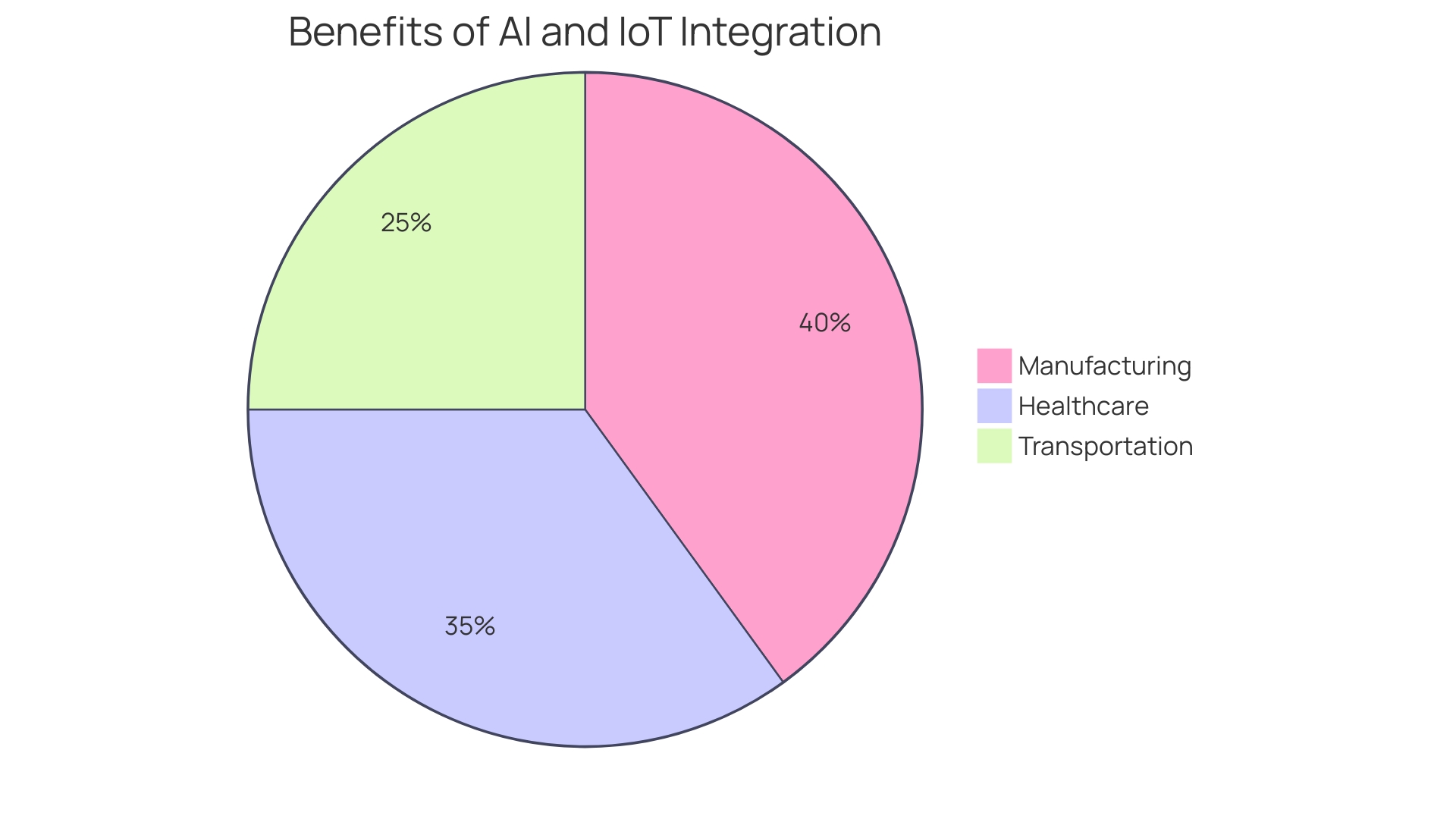
Key Components of AIoT Integration
Successful integration of Artificial Intelligence and the Internet of Things (AIoT) hinges on several critical components that form the backbone of this transformative technology. At the core is robust connectivity, which facilitates seamless communication among diverse devices, ensuring that information flows effortlessly across the network. This connectivity not only improves effectiveness but also establishes the foundation for real-time information sharing and collaboration.
Data management systems play a pivotal role in this ecosystem, enabling the effective storage, processing, and analysis of vast amounts of information generated by connected devices. ‘The significance of time series information management cannot be overstated; it allows organizations to harness trends over time, leading to more informed decision-making and strategic insights.’. Companies that have adopted such systems are increasingly reporting improved operational efficiency and reduced costs.
AI algorithms are equally essential, as they are tasked with interpreting the data collected from various sources. By utilizing advanced machine learning techniques, these algorithms can identify patterns, predict outcomes, and drive automation in a myriad of applications, ranging from predictive maintenance to supply chain optimization. For example, producers utilizing these advancements have effectively attained greater Overall Equipment Effectiveness (OEE) and enhanced key performance indicators (KPIs) related to their production setups.
As Industry 4.0 continues to evolve, organizations are recognizing the importance of integrating these elements to stay competitive. The ongoing digital transformation initiatives highlight the critical nature of these components, as they work synergistically to push the boundaries of what is possible in modern manufacturing and operations.
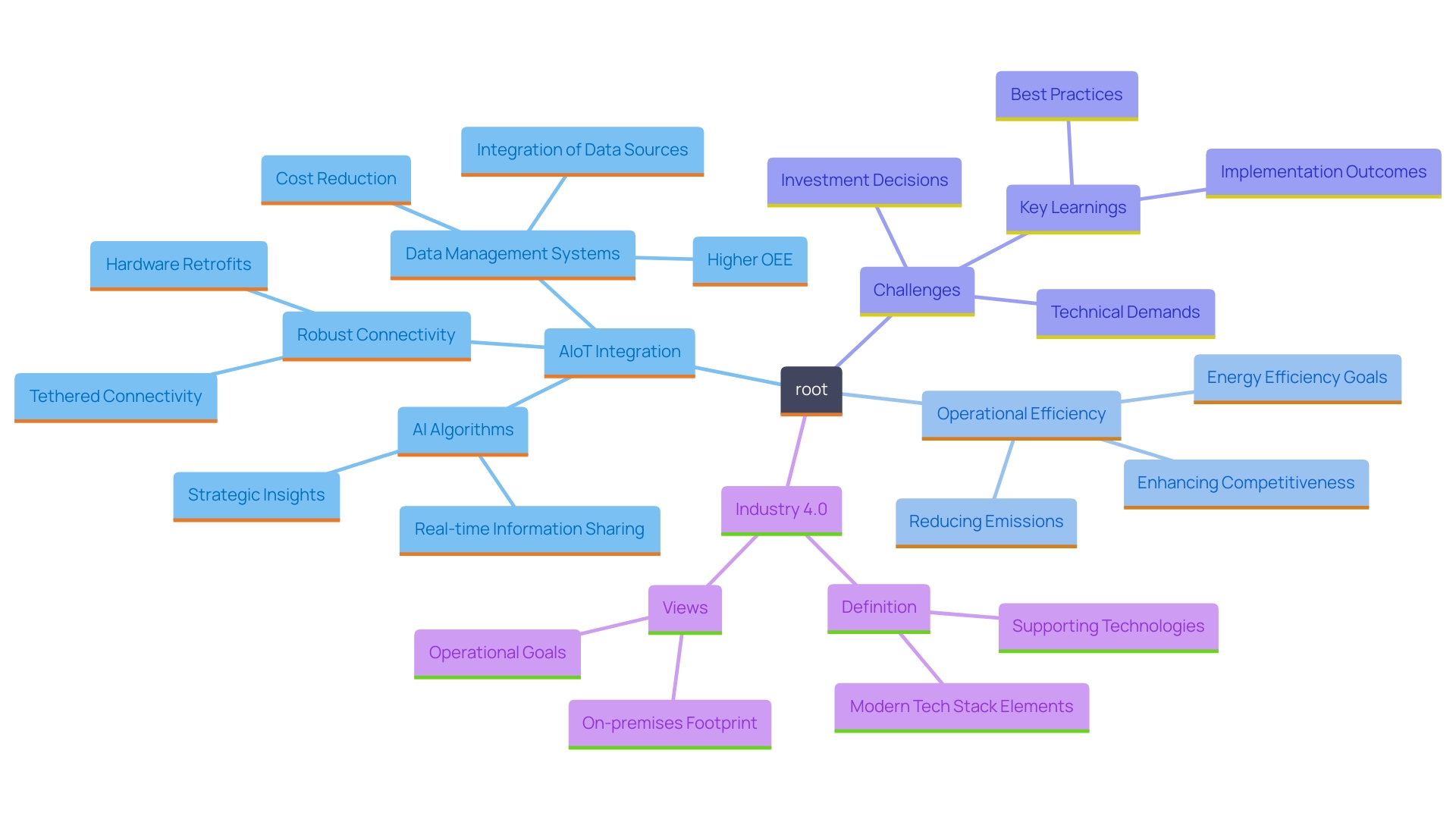
Challenges and Future Prospects in AIoT Integration
Integrating Artificial Intelligence of Things (AIoT) into business processes presents significant opportunities, yet it is not without its hurdles. Key challenges include ensuring information privacy, achieving seamless interoperability among diverse systems, and addressing the growing need for skilled personnel adept in both IoT and AI technologies. As urban environments evolve into smart cities and industries embrace the Industrial Internet of Things (IIoT), the need for strong security measures, real-time information capabilities, and intelligent systems becomes increasingly vital.
To maximize the benefits of AIoT, organizations must navigate these challenges with strategic foresight. For instance, maintaining information integrity is paramount; accurate and properly calibrated sensors are essential at the inception level where information is generated. At the aggregation and control levels, different security needs arise, necessitating a multifaceted approach to data security throughout the smart city infrastructure.
Looking ahead, the prospects for AIoT are bright. Advances in machine learning and edge computing are paving the way for more sophisticated applications that can enhance operational efficiency. As Dimitris Paraskevopoulos, a Senior Analyst, advises, organizations should approach AI as a tool that requires thoughtful implementation—considering the why, who, and how before deployment. ‘This strategic mindset, combined with the advancement of interconnected devices, positions companies to utilize state-of-the-art solutions effectively, ultimately driving innovation and enhancing key performance indicators.’.

Real-World Examples of AIoT in Action
Organizations across various sectors are reaping the benefits of Artificial Intelligence of Things solutions, demonstrating its transformative capabilities. Smart factories, for instance, utilize advanced technologies to oversee machinery and tools in real-time, facilitating predictive maintenance that can detect potential failures before they develop into expensive downtime. According to recent findings, these advancements have led to higher Overall Equipment Effectiveness (OEE) and significant cost reductions, which are crucial metrics for operational success in manufacturing.
In the realm of smart cities, artificial intelligence and the Internet of Things are transforming traffic management systems. By utilizing real-time data to adapt traffic signals and flow, these systems have proven effective in minimizing congestion and enhancing public safety. ‘The incorporation of artificial intelligence and the Internet of Things in urban settings is not merely hypothetical; concrete results include a decrease in traffic holdups and enhanced emergency response durations.’.
However, the journey to successful artificial intelligence and Internet of Things implementation is not without its challenges. Companies have encountered issues such as data integration complexities and resistance to change from employees. For instance, in one case study, a manufacturing firm faced significant hurdles in aligning their legacy systems with new artificial intelligence of things solutions. By nurturing an organizational culture that emphasized teamwork and ongoing education, they managed to surmount these obstacles, resulting in a more seamless transition and more efficient utilization of resources.
The insights gathered from these implementations highlight key learnings that can be beneficial for other organizations embarking on similar digital transformation initiatives. As experts indicate, grasping the particular architectural requirements and functional objectives pertinent to artificial intelligence and the Internet of Things can significantly improve the deployment strategies. For instance, manufacturers are encouraged to focus on leveraging modern technology stacks that facilitate data integration and drive efficiency.
Overall, these case studies underscore how AIoT can be a powerful catalyst for operational improvement, paving the way for organizations to adapt and thrive in an increasingly connected world.
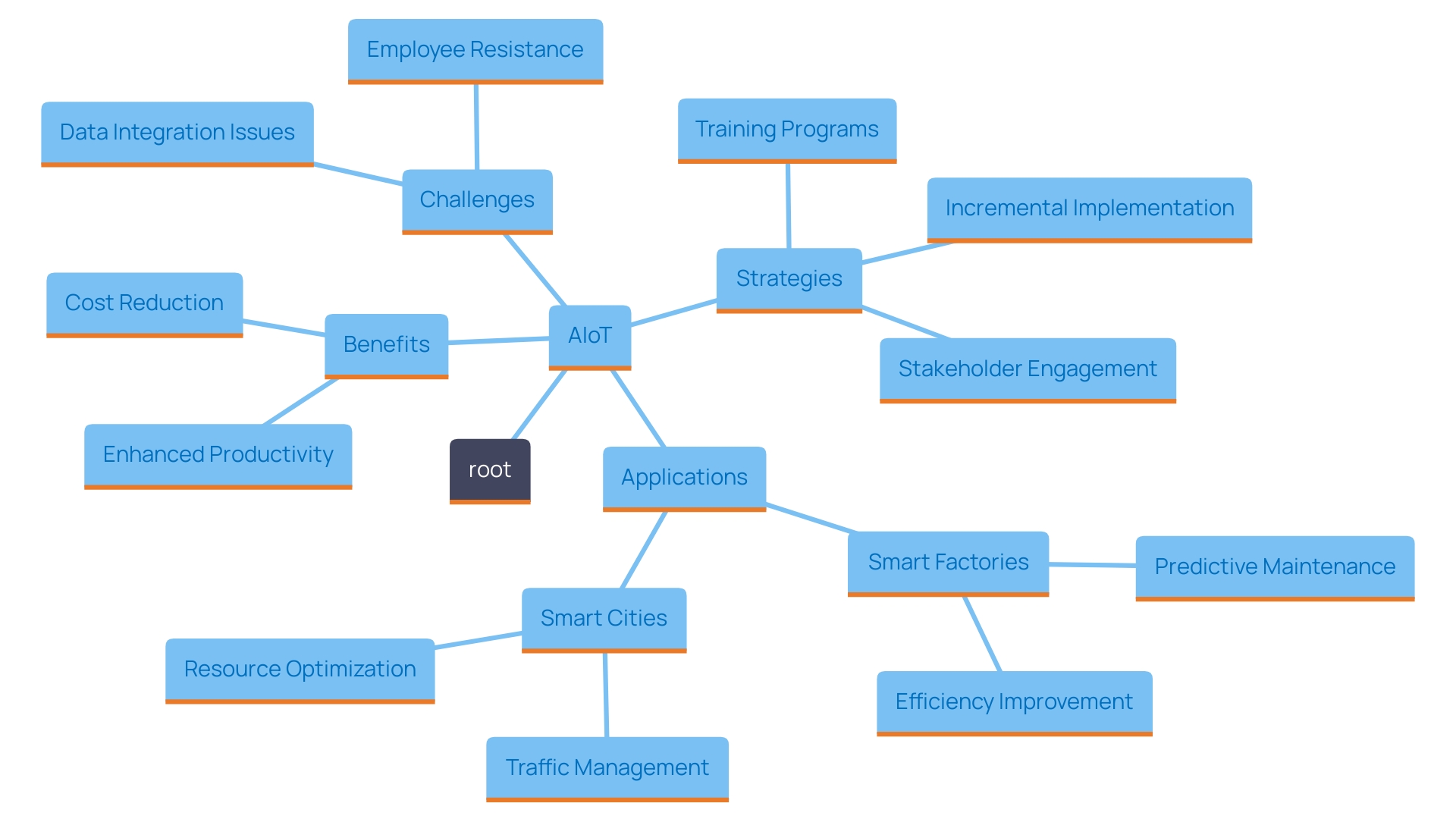
Conclusion
The integration of Artificial Intelligence (AI) and the Internet of Things (IoT) into the AIoT framework is transforming business operations across various sectors. By merging IoT’s data-gathering capabilities with AI’s analytical power, organizations enhance efficiency and unlock new innovation opportunities. Examples like Renault’s optimized supply chain and advancements in remote patient monitoring highlight significant benefits, including improved performance metrics and cost reductions.
AIoT enables automation and rapid responses to market changes, with studies indicating notable improvements in Overall Equipment Effectiveness (OEE) and operational savings. However, successful implementation requires strategic alignment of technology with existing processes to foster continuous improvement.
Despite its potential, AIoT integration faces challenges such as data privacy, interoperability, and the need for skilled personnel. Organizations must prioritize data integrity and security to fully realize AIoT’s benefits. Future advancements in machine learning and edge computing will further enhance AIoT capabilities, empowering businesses to achieve operational excellence.
In summary, the convergence of AI and IoT through AIoT presents a powerful opportunity for organizations to enhance efficiency, drive innovation, and maintain competitiveness. By addressing challenges and embracing AIoT’s potential, companies can position themselves for future success.
Introduction
The Internet of Things (IoT) is not just a buzzword; it represents a paradigm shift that is reshaping industries and redefining operational excellence. With a vast network of interconnected devices equipped with advanced sensors and software, IoT enables seamless data collection and real-time communication, driving unprecedented levels of efficiency and innovation. As organizations navigate the complexities of this digital revolution, the benefits of effective IoT implementation become increasingly clear: enhanced productivity, optimized resource management, and improved customer engagement.
However, the journey is not without its challenges, including security concerns and integration hurdles. This article delves into the intricacies of IoT, exploring its key components, real-world applications, and the vital role of automation in unlocking its full potential. By understanding the current landscape and future directions of IoT, organizations can better position themselves to harness this transformative technology and propel their operations toward greater success.
What is IoT and How Does it Work?
The Internet of Things (IoT) represents a transformative network of interconnected devices equipped with sensors, software, and advanced technologies that enable seamless information collection and exchange over the internet. This integration allows devices, ranging from household appliances to complex industrial machinery, to communicate effectively by leveraging cloud connectivity. By harnessing time series information management, organizations can significantly enhance their operational processes and decision-making capabilities.
As industries continue to embrace the advancements of Industry 4.0, the significance of information management becomes increasingly evident. In fact, a modern industrial facility can produce over a terabyte of information daily, which can be overwhelming without the right tools to analyze it. Effective use of IoT not only facilitates real-time monitoring but also drives automation, leading to enhanced productivity and adaptability in response to changing market demands.
The growing trend of smart systems highlights the potential of IoT in creating intelligent environments. These systems analyze data to optimize energy usage and improve overall efficiency. For instance, smart grids utilize IoT technologies to enable two-way communication between devices, ensuring better energy management and reliability.
As quoted in recent analyses, “Digitalization has allowed ‘smart’ to become the epicenter of the current technological developments,” emphasizing the central role of IoT in modern enterprise. Through connected devices, businesses can lower expenses, streamline workflows, and create new revenue opportunities. The execution of IoT solutions not only boosts efficiency but also improves the customer experience, showcasing its worth across different sectors.
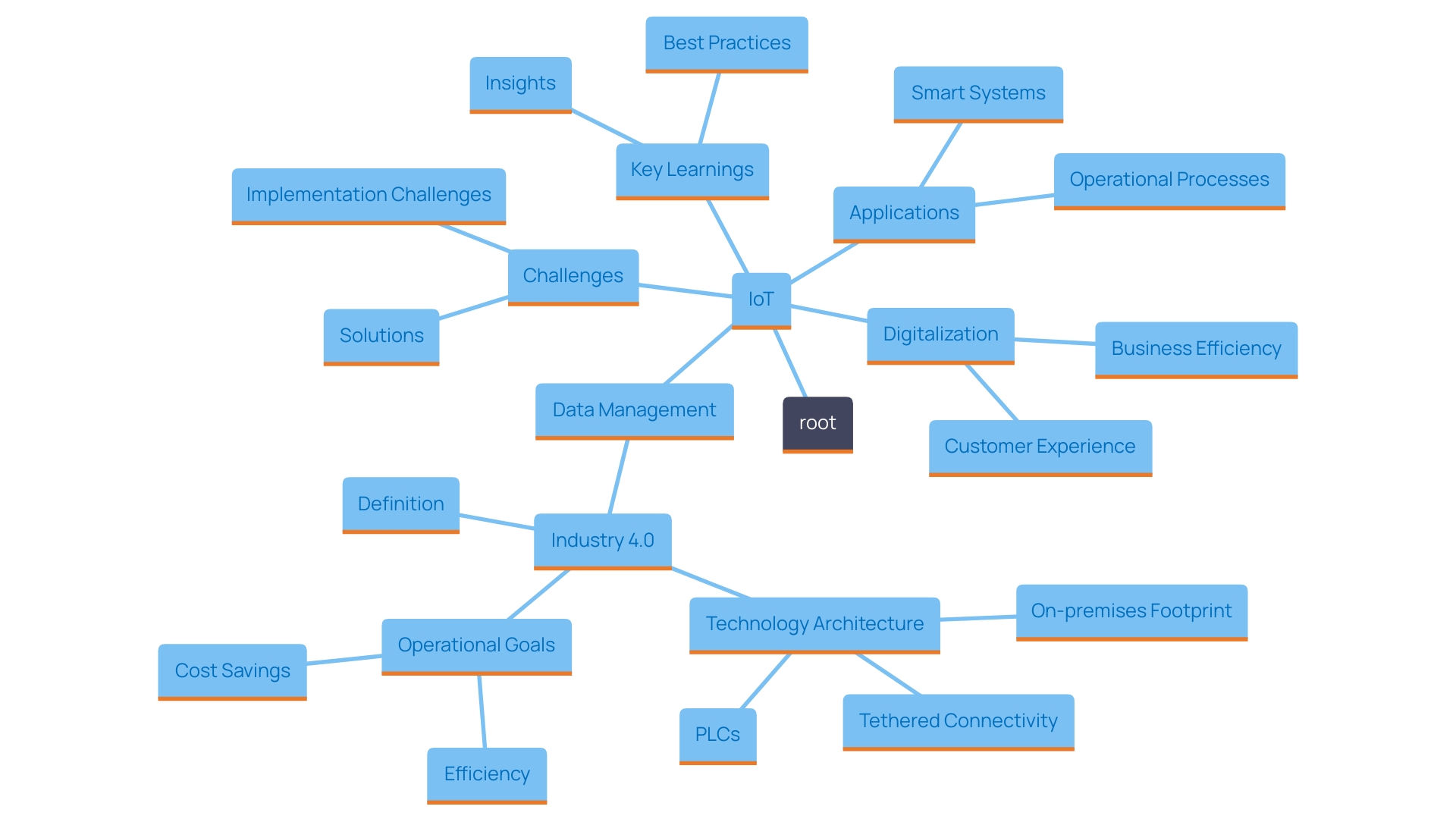
Key Components of IoT
The Internet of Things (IoT) is transforming sectors by integrating various elements that improve efficiency in operations and data-driven decision-making. Central to this transformation are sensors and devices that collect real-time information from their surroundings. These sensors can be found in various applications, from healthcare monitoring systems to industrial machinery, collecting critical information that informs operational strategies.
Connectivity plays a pivotal role in the IoT ecosystem. Technologies like WI-Fi, Bluetooth, and cellular networks facilitate effortless information transfer to cloud infrastructures. This connectivity is crucial for real-time information accessibility, allowing organizations to respond swiftly to changing conditions. For instance, the integration of these technologies supports the ever-growing demands of Industry 4.0, where digital transformation is key to remaining competitive.
Once the information arrives in the cloud, sophisticated processing and analysis take place. This transformation of raw information into actionable insights allows businesses to optimize their operations, enhance productivity, and drive innovation. As emphasized in recent trends, many organizations are utilizing time series information management to monitor and analyze their operational metrics effectively. This capability is essential for identifying inefficiencies and improving overall equipment effectiveness (OEE).
User interfaces, such as intuitive dashboards and mobile applications, empower users to engage with the processed information. These interfaces not only facilitate decision-making but also enhance user engagement by providing real-time feedback on system performance. The evolution of these tools marks a significant step forward in making complex data comprehensible and actionable for decision-makers across industries.
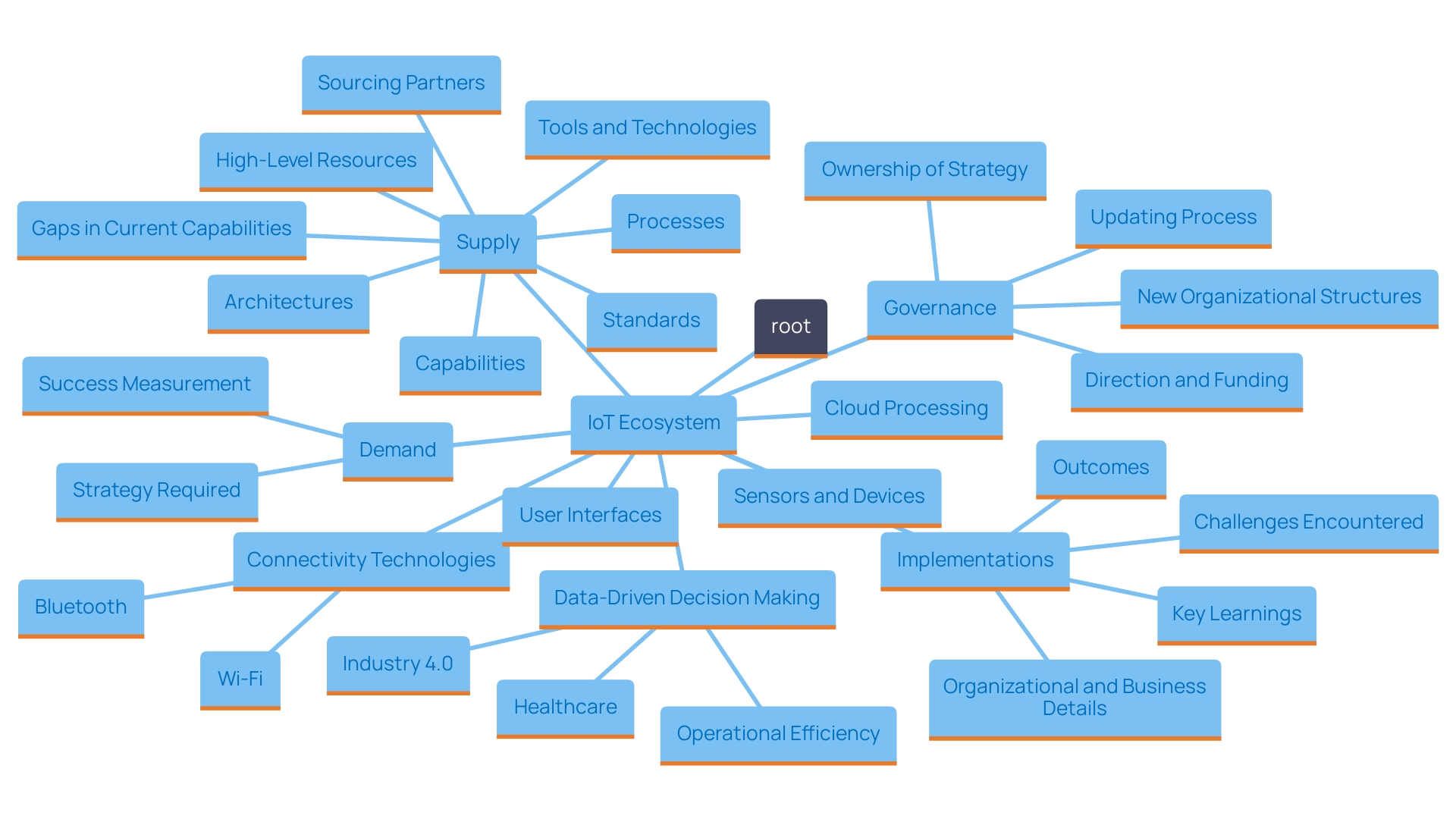
Benefits of IoT in Modern Industries
The Internet of Things (IoT) is catalyzing a transformative wave across various sectors, heralding the onset of Industry 4.0. ‘This digital revolution is characterized by the integration of advanced technologies into manufacturing processes, aiming to enhance efficiency, resource management, and customer engagement.’. As highlighted by an analyst at Gartner, IoT is projected to expand at a remarkable rate of thirty percent in the coming years, underlining its pivotal role in reshaping industries.
IoT enables real-time monitoring and automation, allowing entities to streamline their operations and significantly reduce costs. This capability also empowers decision-makers to adopt data-driven strategies that swiftly respond to market dynamics and evolving customer needs. For example, by utilizing time series data management, entities can leverage extensive volumes of information created by interconnected devices, resulting in better predictive analytics and enhanced management control.
Moreover, the IIoT (Industrial Internet of Things) specifically focuses on industrial applications, enhancing processes in sectors like manufacturing, energy, and transportation. It encompasses complex systems that require stringent security measures and essential management controls. This targeted approach not only boosts productivity but also enhances safety measures across various industrial landscapes.
The significance of IoT extends beyond mere efficiency; it paves the way for smarter energy management systems that align consumption with generation, contributing to sustainability efforts. As entities worldwide adopt this technological change, they are not only updating their processes but also reshaping the benchmarks of customer interaction and performance excellence.
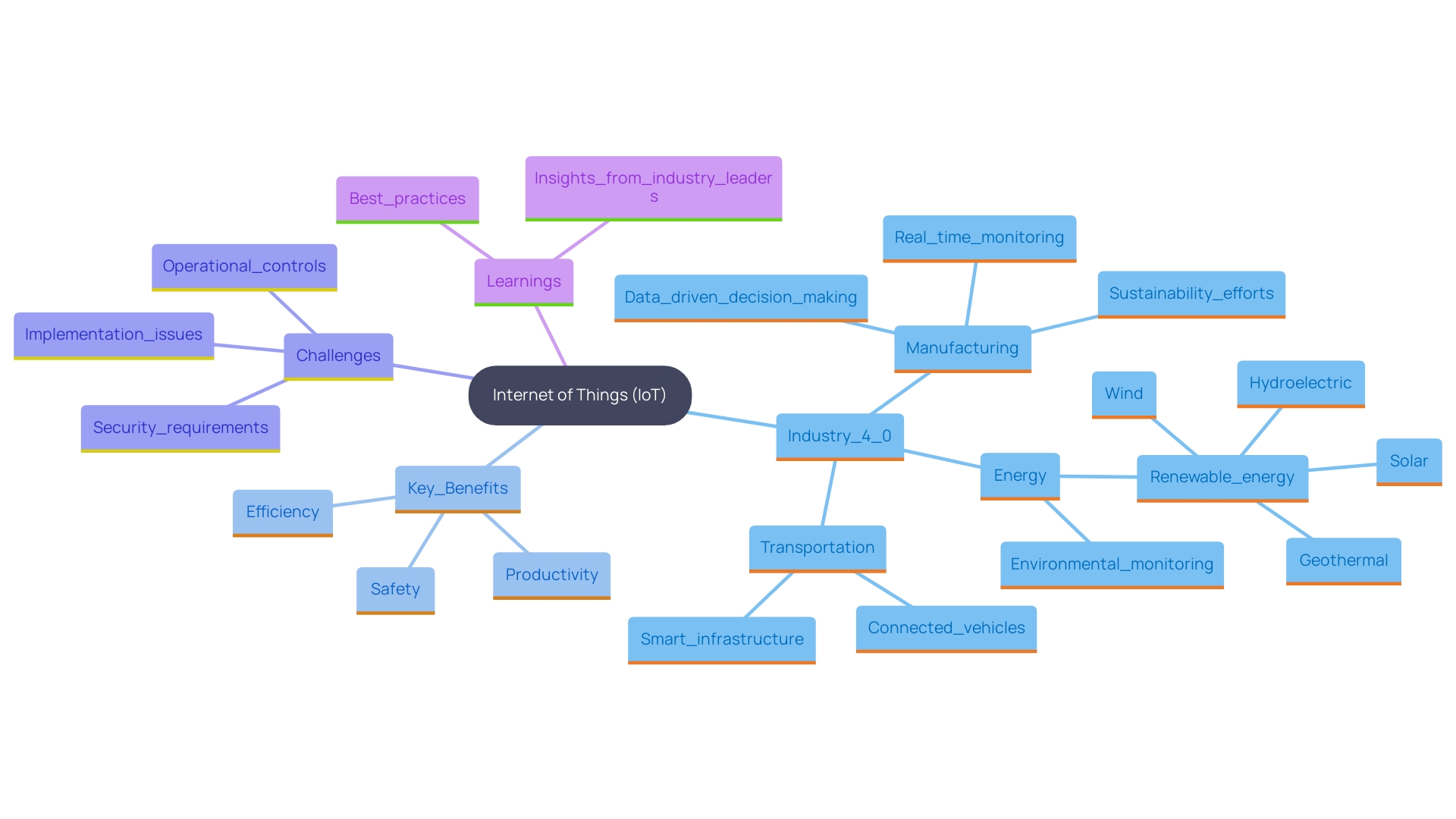
Role of Automation in IoT
Automation is vital for unlocking the full potential of the Internet of Things (IoT). By harnessing automation technologies in conjunction with IoT, organizations can streamline operations, significantly reducing manual interventions and the associated risks of human error. This integration not only enhances operational speed but also bolsters accuracy across various processes. For instance, automated systems can promptly respond to data inputs from IoT sensors, facilitating real-time actions such as recalibrating machinery, optimizing inventory levels, or alerting staff to upcoming maintenance needs.
A recent report on Industry 4.0 highlights how 22 companies successfully integrated automation with IoT technologies. These implementations yielded remarkable outcomes, including increased Overall Equipment Effectiveness (OEE) and substantial cost reductions. However, the journey was not without challenges. Many organizations faced resistance to change and initial technical hurdles, which they overcame by engaging employees through training programs and demonstrating the tangible benefits of automation.
Moreover, as companies increasingly adopt generative AI, sectors like marketing and product development are seeing significant transformations—34% of businesses report using AI in marketing, while 23% apply it in product innovation. Such statistics underscore the importance of embracing automation to stay competitive in a fast-evolving market.
Furthermore, intelligent automation can be categorized into several levels, including AI-augmented, autonomous, autonomic, and cognitive systems. Each category reflects varying degrees of sophistication in how these systems interact with human workflows and the environment. Grasping these differences can assist producers in choosing the appropriate automation options to improve productivity and efficiency in operations.
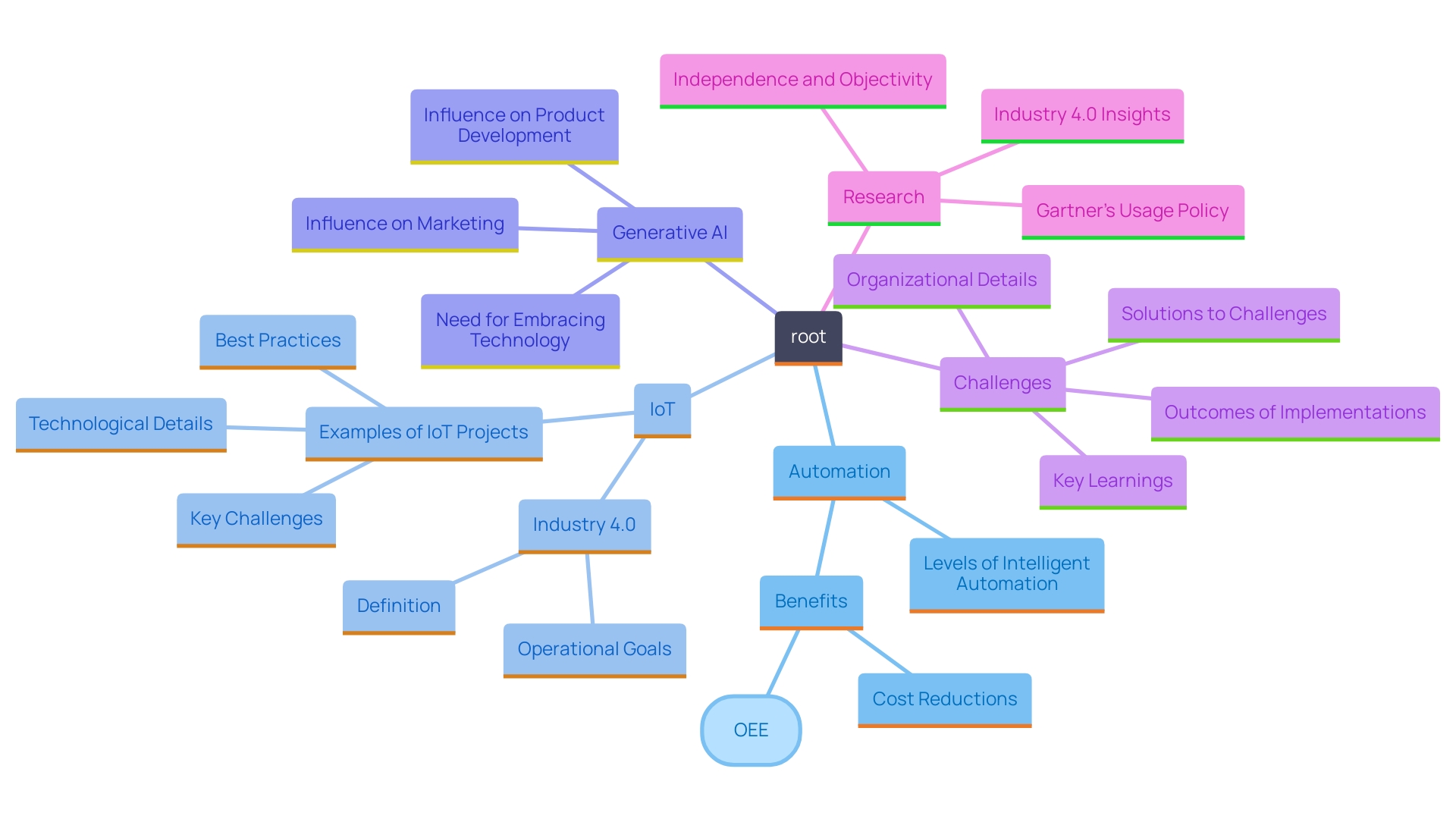
Real-world Applications of IoT
The Internet of Things (IoT) is revolutionizing various sectors, showcasing its versatility in applications such as smart manufacturing, healthcare, agriculture, and logistics. In smart manufacturing, IoT devices enable real-time monitoring of equipment performance, facilitating predictive maintenance that can substantially reduce downtime. For example, producers adopting Industry 4.0 initiatives have noted considerable enhancements in overall equipment effectiveness (OEE) and lowered expenses through improved information integration and process automation.
In the healthcare sector, wearable IoT devices are transforming patient care. These devices continuously track vital signs, allowing healthcare providers to monitor patients in real-time and respond swiftly to any anomalies. Outcomes from recent implementations have shown that hospitals utilizing these technologies can enhance patient outcomes while also optimizing resource allocation and staff efficiency.
Agriculture is experiencing a similar transformation through precision farming techniques powered by IoT. By utilizing data-driven insights, farmers can optimize resource usage—such as water, fertilizers, and pesticides—resulting in improved crop yields and reduced environmental impact. The adoption of IoT in agriculture has led to documented increases in productivity, as farmers are now able to make informed decisions based on real-time data.
Logistics companies are also leveraging IoT to streamline operations, using connected devices to monitor supply chain activities. This integration allows for better tracking of shipments, inventory management, and predictive analytics related to demand forecasting. Businesses that have adopted IoT solutions report enhanced operational efficiency and reduced costs, highlighting the critical role of technology in modern logistics.
The challenges encountered during these implementations often center on merging new technologies with current systems and overcoming resistance to change within enterprises. However, companies that prioritize training and communication with their teams tend to navigate these hurdles more effectively, leading to successful outcomes and valuable lessons for others in the field. By understanding these dynamics, entities can better position themselves to harness the power of IoT across their operations.
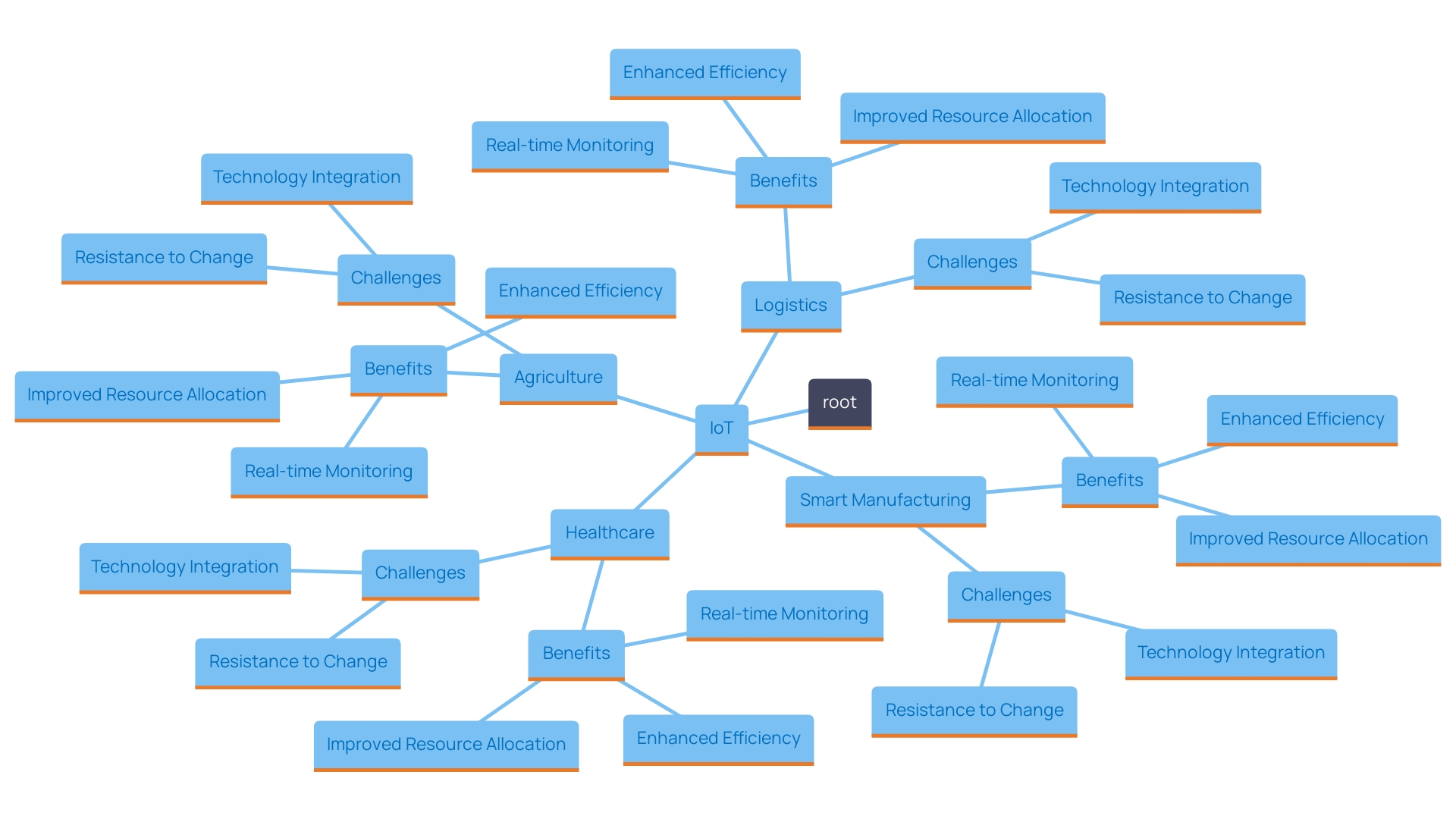
Challenges and Future of IoT Adoption
The Internet of Things (IoT) stands at the forefront of technological innovation, enabling everyday objects to connect, collect, and share information over the internet. This transformative capability offers numerous advantages, yet the path to widespread IoT adoption is fraught with challenges. Key hurdles include significant security concerns and data privacy issues, which have led to growing apprehension among companies. ‘According to a recent report, a staggering 97% of entities face difficulties in securing IoT and connected devices, highlighting the critical need for robust digital trust as the backbone of these integrations.’.
Moreover, the complexity of integrating IoT solutions with existing systems complicates the situation. Many manufacturers are struggling to merge new technologies with legacy systems, which often leads to inefficiencies and operational bottlenecks. Successful implementations have shown that organizations can overcome these obstacles by creating a unified information architecture that serves as a single source of truth. This architecture not only organizes information from diverse sources but also enhances decision-making processes through structured and contextualized insights.
As the IoT landscape evolves, advancements in connectivity, data analytics, and machine learning are paving the way for innovative solutions that can significantly enhance operational efficiency and productivity. Companies that embrace these technological trends can expect to achieve higher Overall Equipment Effectiveness (OEE) and improved key performance indicators (KPIs), ultimately driving business growth. The potential for future growth in IoT is immense, provided that organizations prioritize addressing security and integration challenges while leveraging the latest technological advancements.
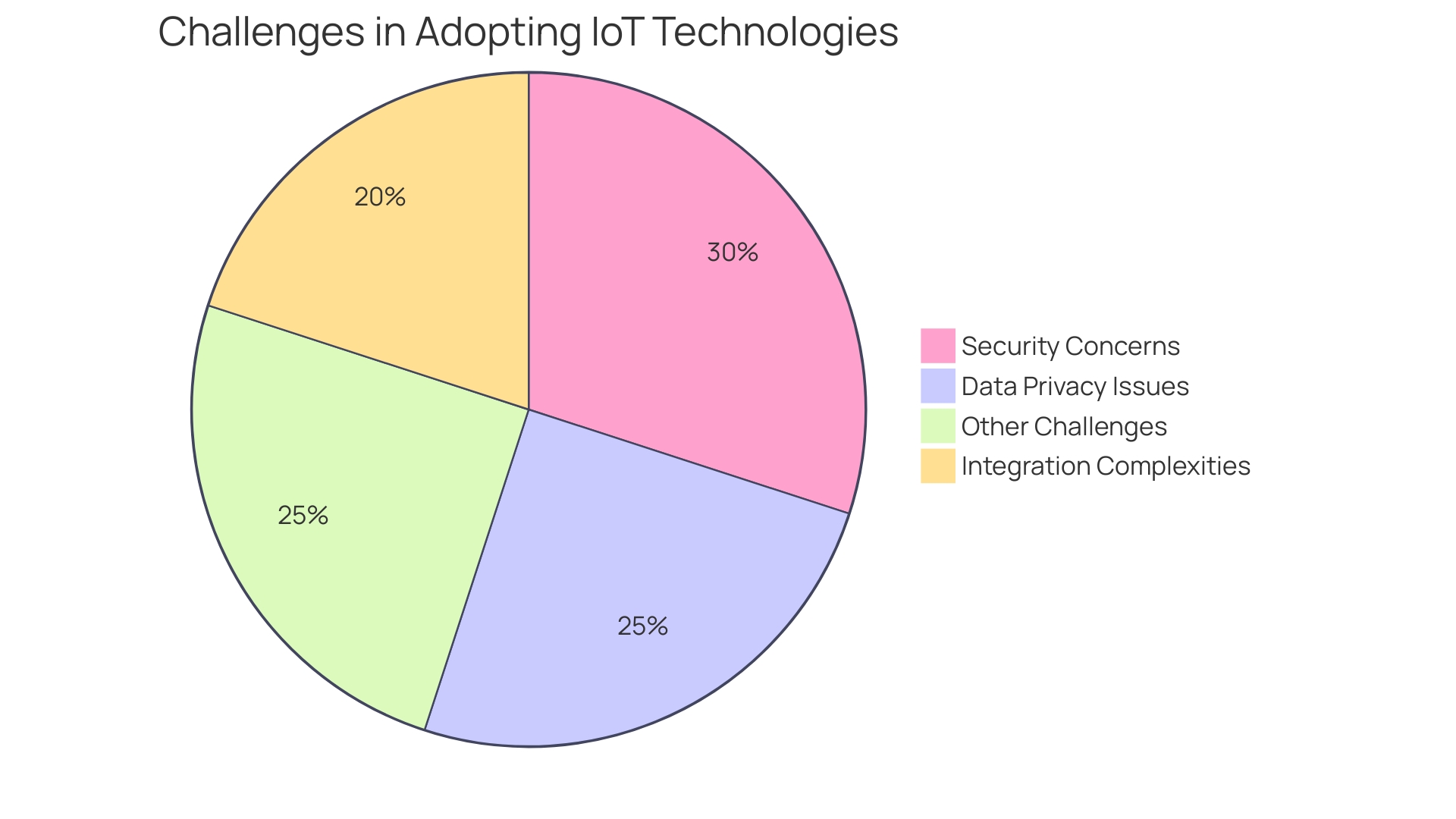
Conclusion
The Internet of Things (IoT) is fundamentally transforming industries by creating a network of interconnected devices that streamline operations and enhance decision-making capabilities. Key components, such as sensors and connectivity technologies, enable real-time data collection and analysis, which are crucial for organizations seeking to improve efficiency and responsiveness in an increasingly competitive landscape. As industries embrace this digital revolution, the benefits of IoT, including cost reduction, optimized resource management, and improved customer engagement, become increasingly apparent.
Automation plays a critical role in maximizing the potential of IoT by reducing manual intervention and enhancing accuracy across various processes. Successful integration of automation and IoT has led to significant improvements in operational metrics such as Overall Equipment Effectiveness (OEE), demonstrating the tangible benefits of this synergy. Real-world applications in sectors such as manufacturing, healthcare, agriculture, and logistics underscore the versatility of IoT technologies in driving operational excellence and improving outcomes.
Despite the numerous advantages, challenges such as security concerns and integration complexities remain significant hurdles. Organizations must prioritize robust security measures and develop unified data architectures to navigate these challenges effectively. By doing so, they can harness the full potential of IoT, paving the way for innovative solutions that drive growth and enhance operational efficiency.
The future of IoT adoption is bright for those willing to address these challenges head-on and leverage the latest technological advancements to stay ahead in a rapidly evolving market.
Introduction
In today’s fast-paced business landscape, the importance of a seamless employee onboarding experience cannot be overstated. Organizations are increasingly recognizing that automating this process is not merely a convenience, but a strategic imperative that can enhance operational efficiency and foster employee satisfaction. By integrating technology into onboarding, companies can significantly reduce the time spent on administrative tasks, allowing new hires to feel welcomed and engaged from day one.
This article delves into the transformative benefits of onboarding automation, outlining practical steps to implement it effectively, and addressing common challenges that organizations face. Additionally, by measuring the success of these initiatives, businesses can ensure they are creating an environment that not only attracts talent but also retains it, ultimately driving long-term success.
Benefits of Employee Onboarding Automation
Automating the staff orientation procedure transforms how companies incorporate new recruits, greatly decreasing the time and effort usually required. By leveraging technology to manage administrative tasks, companies can create a more engaging and welcoming experience for new staff right from their first day. This approach not only fosters a sense of belonging but also enhances overall job satisfaction, which is critical for retention.
For instance, companies in the financial sector often face stringent regulations requiring effective training for new staff. By automating their orientation processes, organizations can ensure compliance with these regulations while also providing an engaging introduction to their corporate culture. As noted by Karmela Peček, an instructional designer at eWyse Agency, transforming complex technical data into user-friendly formats encourages new team members to explore and understand their roles more effectively.
The advantages of improved orientation experiences are evident in retention statistics; workers are more inclined to remain with organizations that emphasize effective introduction processes. As stated in the 2024 Experience Trends Report from Qualtrics, as worker expectations continue to increase, those who feel appreciated during the initial orientation are more likely to contribute positively to the workplace. As Nir Leibovich, co-founder and CEO of GoCo, emphasizes, concentrating on staff rather than time-consuming HR tasks enables companies to foster a supportive environment that promotes long-term loyalty.
In summary, automating the orientation procedure not only simplifies administrative tasks but also fosters a welcoming environment that aligns with the changing demands of today’s workforce.
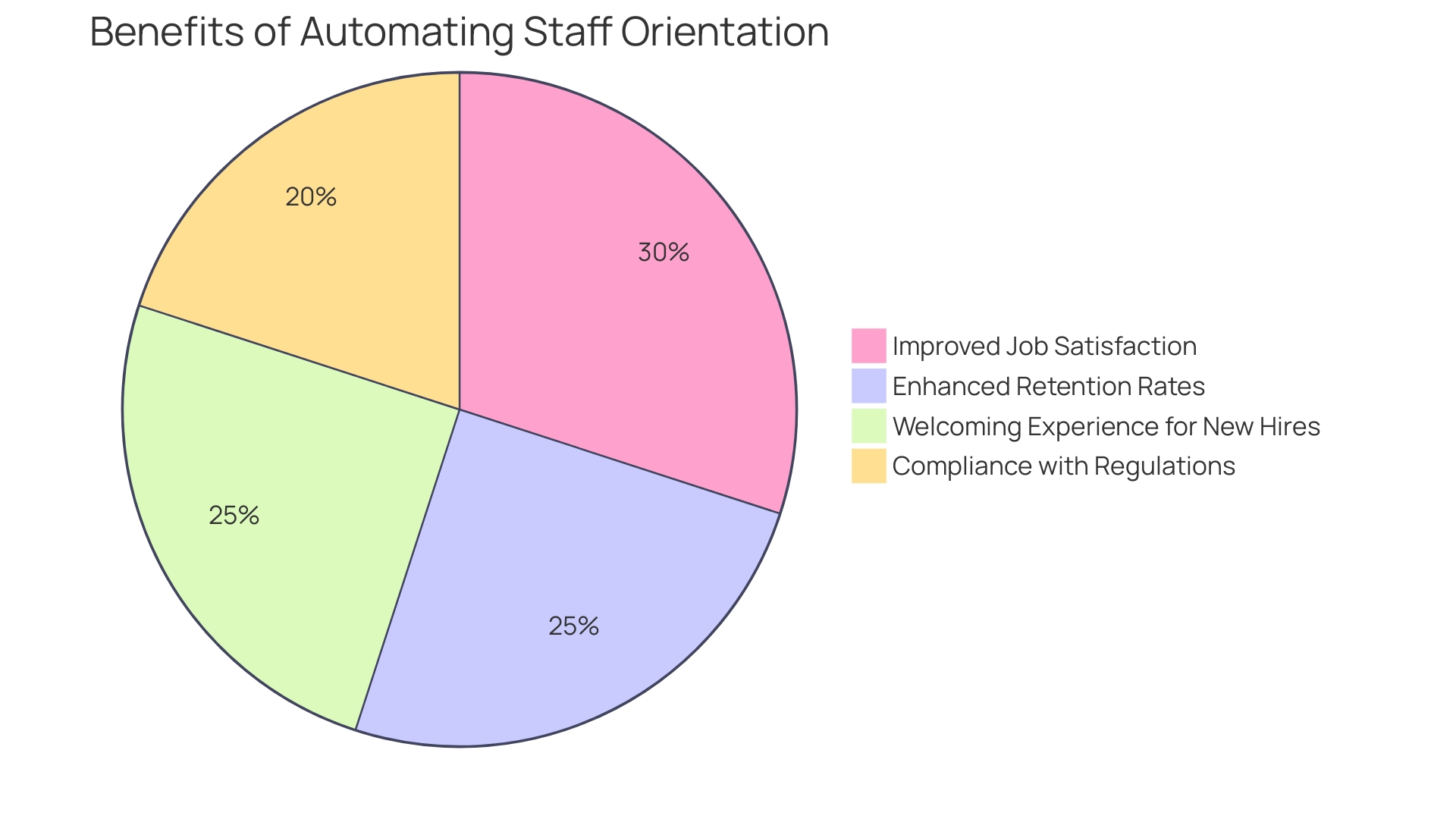
What Tasks Can Be Automated in Employee Onboarding
The mechanization of different activities during the employee integration system demonstrates a significant transformation for companies aiming for operational excellence. Key tasks such as document collection, training schedule creation, benefits enrollment, and compliance training can be seamlessly automated. This change not only speeds up the integration timeline but also greatly decreases the likelihood of human mistakes that frequently come with manual tasks. For example, a fast-growing startup recently leveraged automation to streamline its onboarding, enhancing alignment on necessary tasks and improving overall efficiency.
By automating these steps, organizations can ensure that no critical detail is overlooked. This is particularly crucial for compliance training, where missed steps can lead to significant consequences. In reality, automating tasks has demonstrated the ability to save an average of 35 minutes per request, as illustrated by Delivery Hero, which encountered difficulties with staff being locked out of their accounts. By refining their processes, they managed to reclaim valuable time for employees, allowing them to focus on their core responsibilities rather than getting bogged down in administrative hurdles.
The integration of intelligent document processing is a vital consideration when executing mechanization. Organizations should first evaluate their data processing requirements—identifying whether their data is structured or unstructured—and the amount of information that needs mechanization. Targeting documents that traditionally consume a lot of manual processing time, such as invoices and contracts, can yield substantial efficiency gains. This targeted approach can lead to notable cost savings and enhanced productivity, allowing HR professionals to redirect their efforts toward more strategic, people-centered initiatives. By embracing automation, businesses can not only enhance their employee integration processes but also cultivate a more dynamic and efficient workforce.
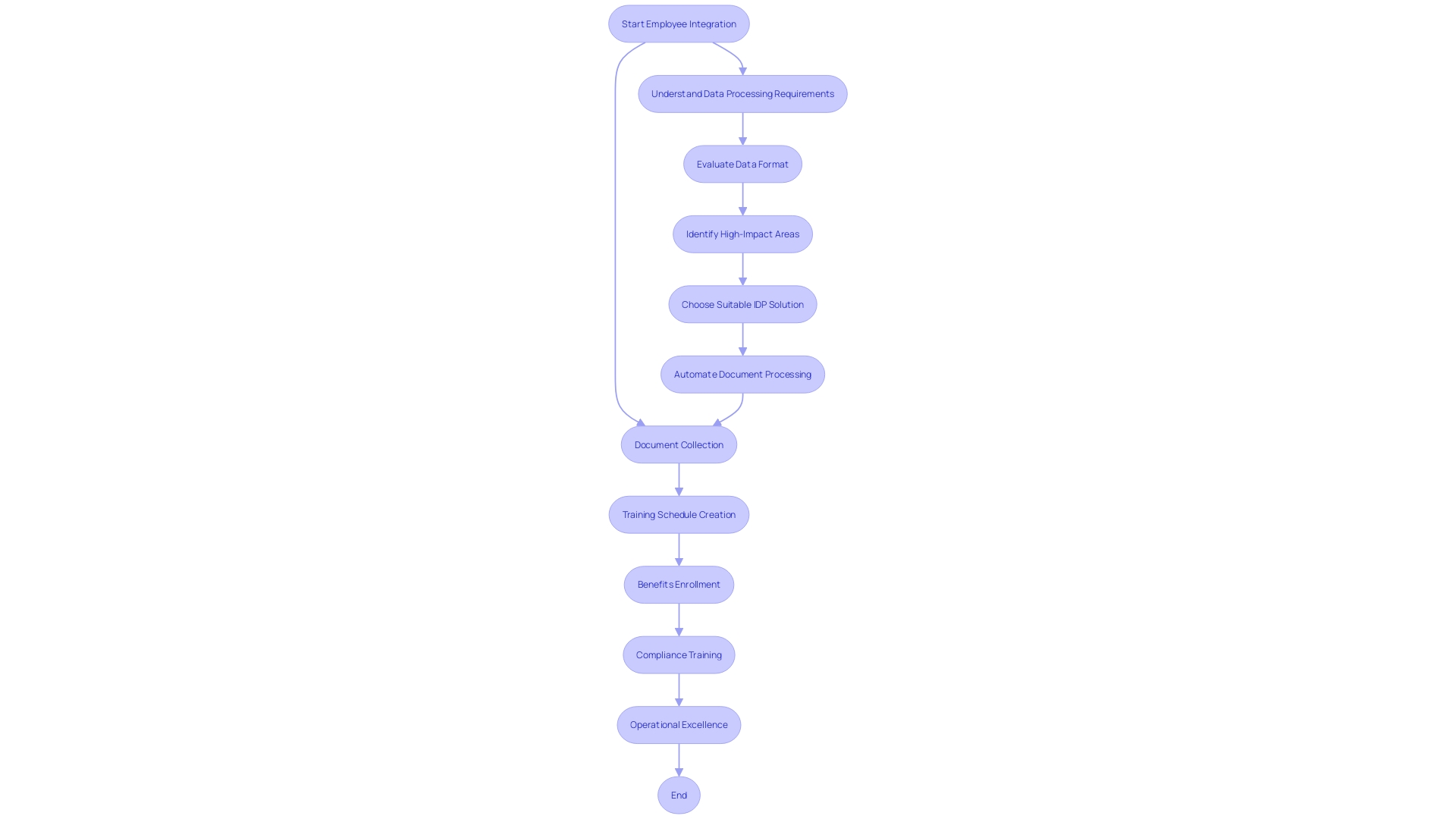
Step-by-Step Guide to Automating Employee Onboarding
Automating employee integration requires a strategic and well-organized approach to maximize efficiency and minimize the burden on HR teams. Begin by pinpointing the specific onboarding tasks that are repetitive and time-intensive. Shared spaces suitable for mechanization encompass familiarizing new employees with the organization’s culture, important policies, and compliance standards, especially in regulated sectors where grasping legal structures is vital.
Once the tasks are identified, select tools for mechanization that align with your organization’s unique needs. Look for platforms that offer personalized eLearning experiences, enabling new employees to engage with onboarding materials tailored to their specific roles and progress. For example, data-driven eLearning systems can adapt content based on individual performance, ensuring that new hires gain the necessary skills and knowledge effectively.
After selecting the right tools, proceed with implementing the automation solution. This phase is crucial: ensure that all stakeholders, from HR personnel to department managers, are adequately trained and informed about the new procedures. By promoting a culture of collaboration and transparency concerning the changes, organizations can reduce resistance and improve the integration experience. As companies maneuver through this shift, it’s vital to acknowledge that the incorporation of AI and mechanization technologies will not only enhance workflows but also generate chances for innovation and increased worker involvement.
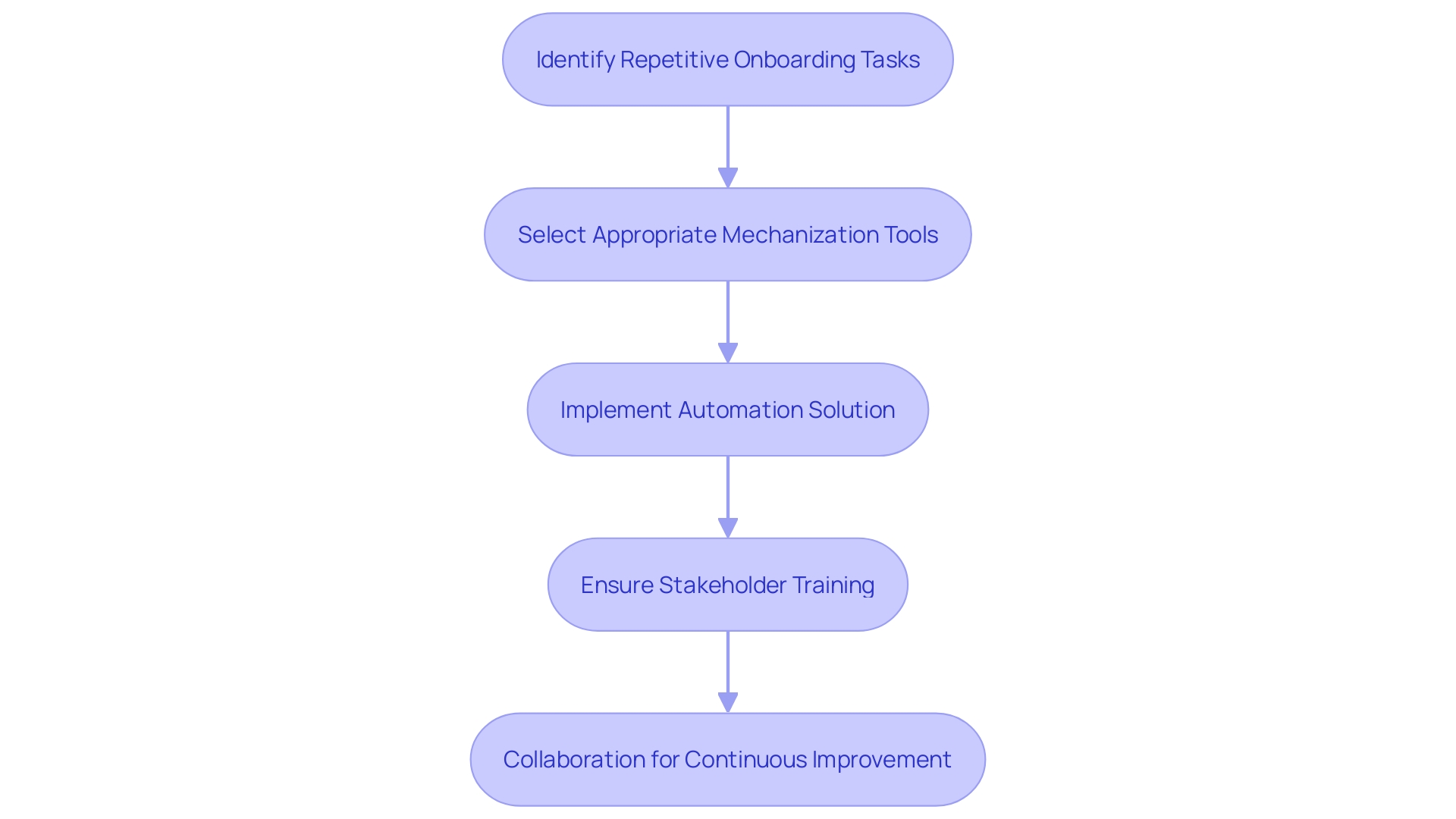
Common Challenges and Solutions in Onboarding Automation
Automating the onboarding procedure presents a wealth of advantages, yet organizations often encounter significant hurdles. Typical obstacles involve staff resistance, challenges in merging new technological tools with current systems, and the intricacies of maintaining adherence to legal standards.
To navigate these challenges effectively, it’s crucial to adopt a comprehensive approach that prioritizes change management. A organized collection of methods, tools, and techniques can reduce opposition and enhance the advantages of automation. Comprehending the effect of changes on staff and addressing potential concerns is essential. Successful change management is not solely about technical implementation; it’s about winning the hearts and minds of your team. For instance, Nets, a provider of digital payment solutions, faced similar obstacles when revamping their onboarding process. They focused on presenting technical data in user-friendly formats, which not only engaged employees but also encouraged them to explore the information independently.
Choosing flexible automation tools can facilitate smoother integration with existing systems. A recent survey revealed that 87% of organizations plan to increase their investments in AI, highlighting the growing recognition of its potential in enhancing operational efficiency. Moreover, staying up-to-date with compliance regulations is critical. Regularly reviewing these regulations ensures that automated processes align with current legal standards, thus mitigating risks associated with non-compliance. By taking these proactive steps, organizations can transform their orientation experience and set the stage for a more engaged and productive workforce.
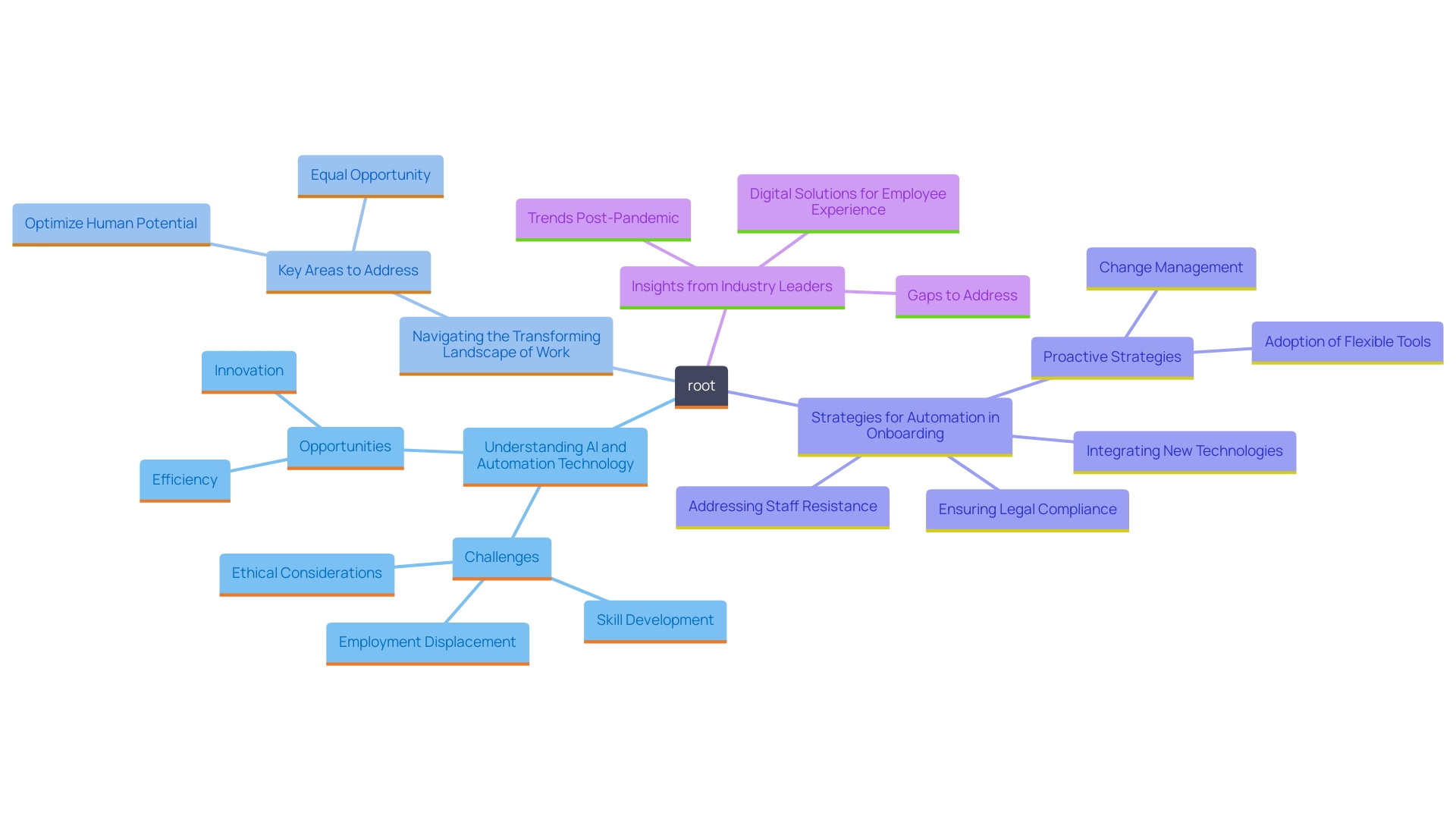
Measuring the Success of Onboarding Automation
Monitoring the efficiency of automation during the initial employee integration necessitates attention to multiple crucial performance metrics (KPIs) that represent the overall acclimatization experience. Organizations should closely monitor metrics such as time-to-productivity, employee satisfaction scores, and retention rates. For instance, research indicates that over 45% of workers leave their jobs within the first year, often due to inadequate training experiences. By consistently examining these metrics, organizations can recognize gaps and opportunities within their onboarding systems.
A case in point is Delivery Hero, which faced significant challenges with staff account access, leading to an average of 800 lockout requests per month. By streamlining their processes and implementing automation, they reduced the time to regain access, allowing staff to return to work promptly, thus enhancing overall productivity. ‘Likewise, Kabannas, the hotel group, intends to enable its visitors by enhancing their digital interactions, which can be reflected in a staff training context.’. This emphasizes the importance of ensuring that new hires feel engaged from the start.
Moreover, the 2024 Workforce Experience Trends Report emphasizes that staff members increasingly anticipate a smooth integration process that meets their personal needs and preferences. Organizations should leverage data from their existing systems to refine the onboarding process continually. This strategic application of automation not only enhances employee engagement but can lead to improved retention and customer satisfaction, ultimately translating into better business results.
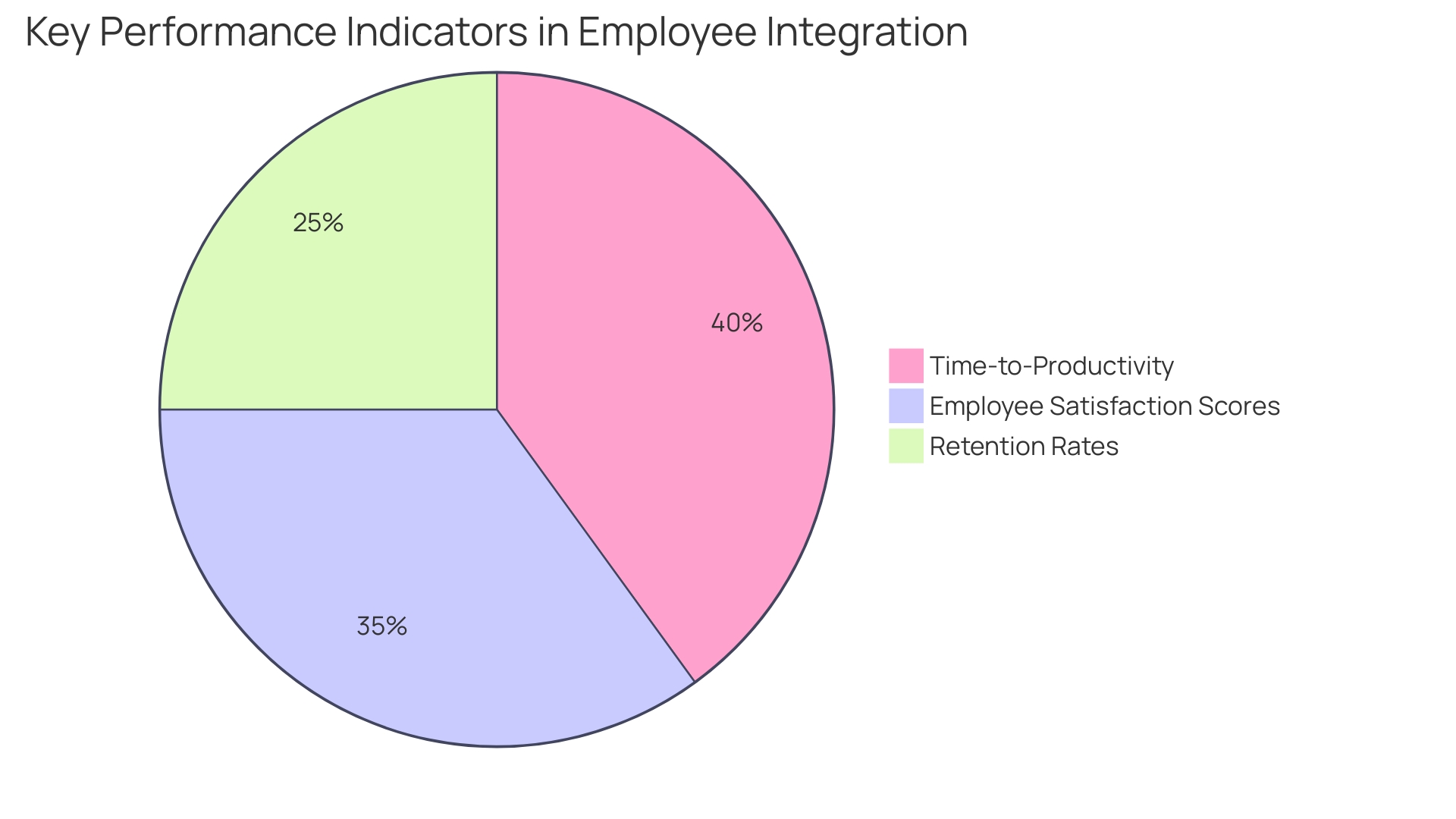
Conclusion
Automating the employee onboarding process offers transformative benefits that extend beyond mere efficiency. By streamlining administrative tasks, organizations can create a welcoming and engaging experience for new hires, which is crucial for enhancing job satisfaction and retention. As highlighted, companies that prioritize efficient onboarding not only comply with regulatory requirements but also foster a culture that values employee contributions from day one.
The automation of critical tasks such as document collection and compliance training significantly reduces human error and accelerates the onboarding timeline. Implementing intelligent document processing can lead to substantial efficiency gains, allowing HR professionals to focus on strategic initiatives rather than getting bogged down in repetitive tasks. By identifying areas ripe for automation and selecting the right tools, organizations can ensure that no detail is overlooked and that new employees are well-prepared for their roles.
While challenges such as employee resistance and system integration may arise, adopting a comprehensive change management strategy can mitigate these issues. Highlighting the importance of user-friendly communication and training can help win employee support and facilitate smoother transitions. Regularly measuring the success of onboarding automation through key performance indicators enables organizations to identify gaps and continuously refine their processes, ensuring they meet the evolving expectations of the workforce.
In summary, the integration of automation in employee onboarding is not just a tactical improvement but a strategic necessity. By embracing this shift, organizations can cultivate a more dynamic, engaged, and productive workforce, ultimately driving long-term success and retention.
Introduction
In a world where efficiency is paramount, organizations are increasingly challenged by the burdens of outdated manual processes that hinder productivity and escalate errors. From manufacturing to healthcare, these inefficiencies not only drain resources but also compromise service quality. As businesses navigate the complexities of modern operations, the transition towards automation emerges as a powerful solution.
This article delves into the multifaceted benefits of embracing automation, showcasing real-world success stories across various sectors. By exploring the steps of digitization, digitalization, and digital transformation, organizations can unlock streamlined processes that enhance operational efficiency and foster a culture of innovation. Discover how tailored automation solutions can empower businesses to thrive in an ever-evolving landscape, ultimately redefining their approach to operational success.
Challenges of Manual Processes
Organizations today confront substantial hurdles stemming from outdated manual processes that not only consume valuable time but are also rife with errors and inefficiencies. For example, in the manufacturing sector, a company grappling with inventory management relied heavily on spreadsheets and manual counts. This approach resulted in significant discrepancies, stockouts, and excess inventory, leading to delays in production and dissatisfaction among customers.
In the healthcare industry, a provider faced similar inefficiencies in managing patient data. The reliance on paper records often led to lost documentation and delays in patient care, undermining the quality of service.
To tackle these challenges, organizations are increasingly recognizing the importance of a structured approach to automation that encompasses three key steps: digitization, digitalization, and digital transformation. Digitization involves converting existing data into a digital format—this initial step ensures that data is accurately represented but does not involve analysis or modification. Following this, digitalization alters processes and organizational structures to enhance data capture and information dissemination, allowing for better decision-making.
Ultimately, digital transformation redefines how organizations utilize data and tools to create additional value for stakeholders. This multifaceted process places advanced systems at the center of operational execution, enabling staff to focus on high-value tasks rather than mundane manual processes.
As noted by a prominent authority in operations management, “the capacity to utilize tools effectively remains an issue,” emphasizing the necessity for clarity in business goals prior to starting automation efforts. Organizations must clearly identify the specific issues they aim to address—whether related to operating costs, service levels, or productivity—and establish guiding principles to select the right tools amidst an increasingly complex landscape.
To illustrate, a recent innovation in retail has emerged with the first checkout-free store in Ireland, powered by Zippin systems. This system allows customers to enter by scanning a payment card, with cameras and weight-sensor shelving detecting purchases, illustrating how technology can streamline processes and enhance customer experience.
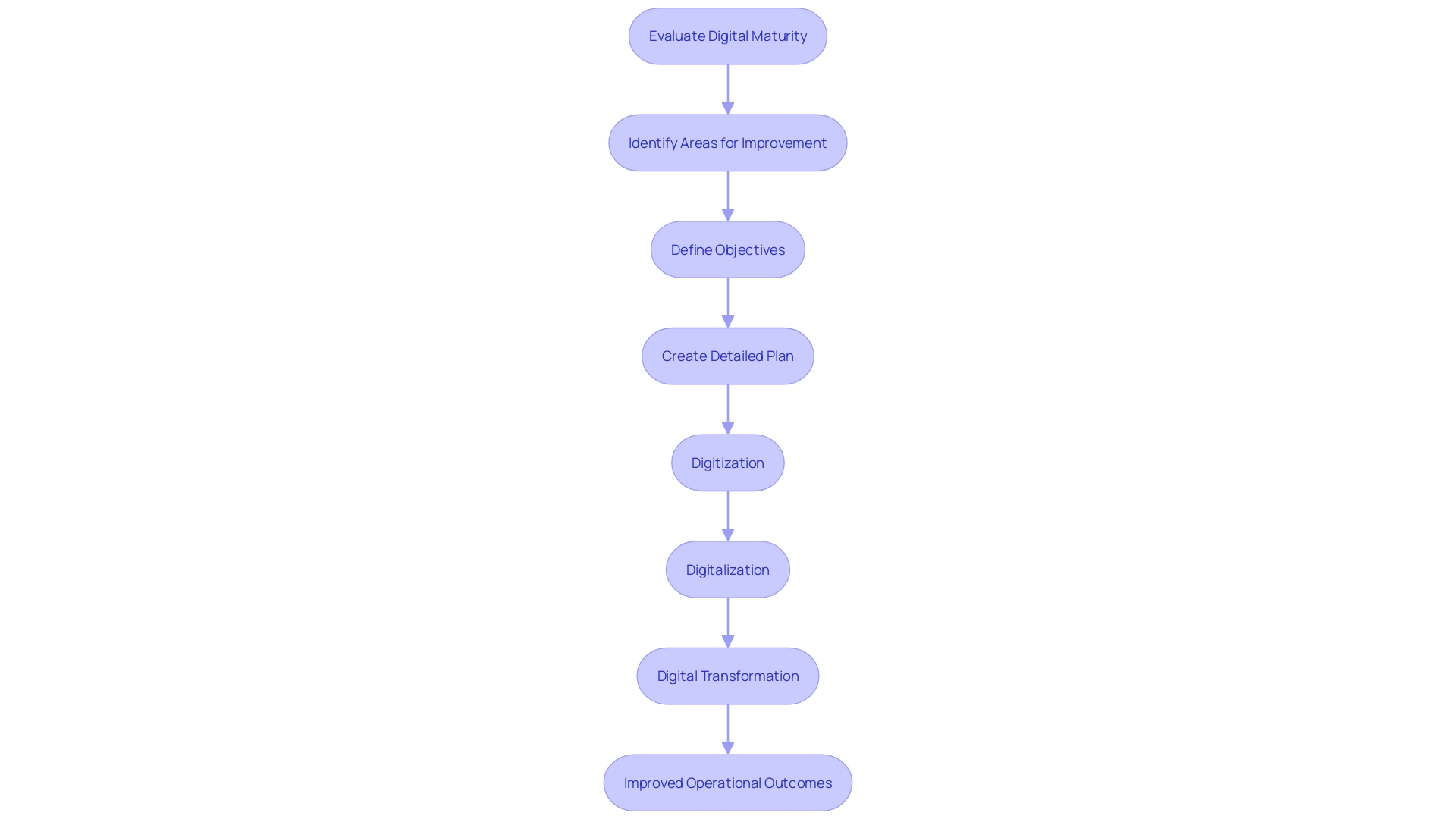
Solutions Through Automation
To address the urgent issues of operational effectiveness, companies from different industries have progressively relied on mechanization instruments tailored to fulfill their specific needs. For instance, in the manufacturing industry, a leading company implemented an advanced automated inventory management system that harnesses real-time data and analytics. This innovation not only streamlined stock tracking but also enabled accurate forecasting and enhanced order management, significantly reducing delays and excess inventory.
In the healthcare sector, the adoption of electronic health record (EHR) systems has transformed patient data management. By integrating information across departments, these systems ensure seamless access to patient records, which minimizes the risk of errors and improves patient care. Dr. McElvania, an advocate for lab mechanization, shared insights from his organization’s experience: “We have five fewer full-time employees than we did before we started, despite our volumes being nearly 50% greater.”. Automation is a huge part of our great culture, why people like to go to work. We are fully staffed, which is very unusual in this environment.” This emphasizes how mechanization not only enhances efficiency but also fosters a positive workplace culture.
Moreover, as organizations begin their journeys of mechanization, it is essential to define their particular business requirements. Comprehending the issues they seek to address, including operating expenses and productivity rates, establishes the foundation for efficient equipment selection. The complexities of contemporary systems necessitate a structured approach to evaluate available technologies and vendor options thoroughly. This guarantees that businesses can make informed choices that align with their performance objectives.
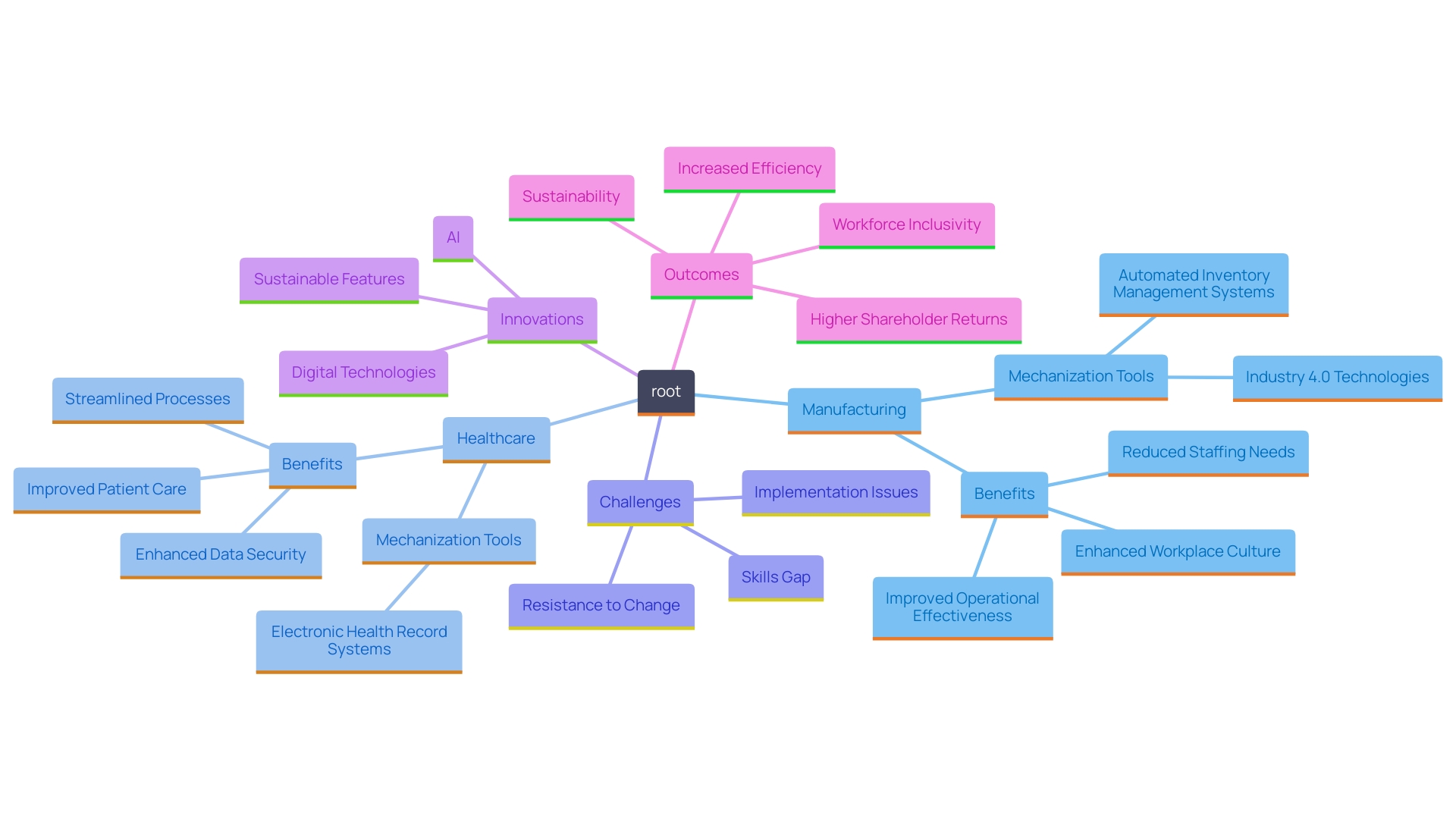
Case Studies: Success Stories in Various Industries
The success narrative of Europris, Norway’s top discount chain, demonstrates the transformative influence of mechanization in supply chain operations. In 2017, Europris partnered with Swisslog to create an automated central warehouse in Moss, with the goal of consolidating six warehouses into one efficient logistics center. This ambitious project unfolded over three phases and aimed to enhance operational efficiency significantly. The initial stage encompassed the building of a mechanized pallet storage facility featuring 65,000 pallet spaces and sophisticated Vectura pallet cranes, representing a crucial milestone in their mechanization journey.
In a similar vein, the financial services sector has also experienced remarkable advancements through mechanization. For instance, a prominent bank implemented an automated loan processing system, slashing the processing time from weeks to mere days. ‘This drastic reduction in time not only boosted operational efficiency but also significantly enhanced customer satisfaction, showcasing how mechanization can streamline operations and improve service delivery.’.
These examples emphasize the significance of precisely outlining business requirements prior to starting a technological transformation. Organizations must identify specific challenges—be it operating costs, service levels, or productivity issues—and understand the tradeoffs involved. By creating guiding principles for choosing tools, organizations can navigate the complexities of mechanization more effectively. This clarity is crucial, especially in an era where the digital transformation process involves digitization, digitalization, and ultimately, digital transformation itself. Each of these sequential steps plays a vital role in leveraging technology to create value and streamline operations, empowering businesses to stay competitive in a rapidly evolving marketplace.
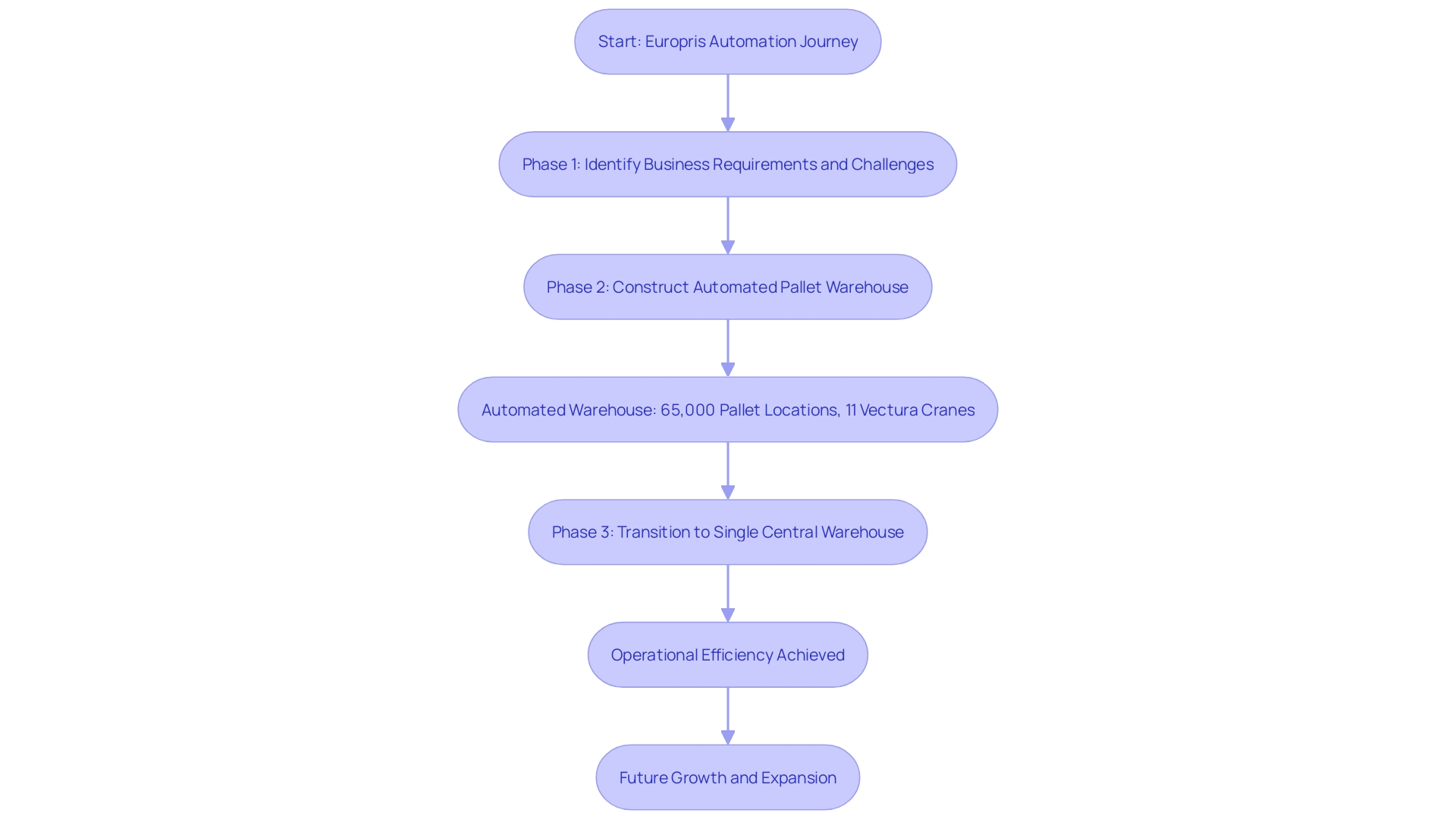
Benefits of Business Process Automation
Organizations that have adopted mechanization have observed significant advantages across different sectors. By improving operational effectiveness and speed, mechanization enables workers to shift their attention to strategic initiatives instead of being hindered by repetitive tasks. For instance, a manufacturing firm reported a remarkable 40% reduction in labor costs associated with inventory management, enabling them to allocate resources more effectively. Likewise, a healthcare provider observed a 25% rise in patient throughput, highlighting the revolutionary effect of mechanization on service delivery.
Along with increasing productivity, mechanization greatly improves data precision, resulting in fewer mistakes and better adherence across sectors. As Dr. McElvania highlighted, “Automation can help improve efficiency and help alleviate healthcare worker shortages. I was very fortunate to be with an organization that introduced laboratory mechanization in 2014 – we have five fewer full-time employees than we did before we started, despite our volumes being nearly 50% greater. Automation is a huge part of our great culture, why people like to go to work. We are fully staffed, which is a very unusual situation in this environment.”
‘The rise of mechanization is not merely a trend but a necessity, particularly when confronted with challenges such as growing demand and constrained resources.’. Statistics show that 94% of corporate executives favor using unified platforms for process management instead of handling various systems. This preference reflects a broader movement toward integrated solutions that streamline operations and enhance productivity. In this swiftly changing environment, organizations that utilize technological tools are better positioned to prosper and uphold their competitive advantage.
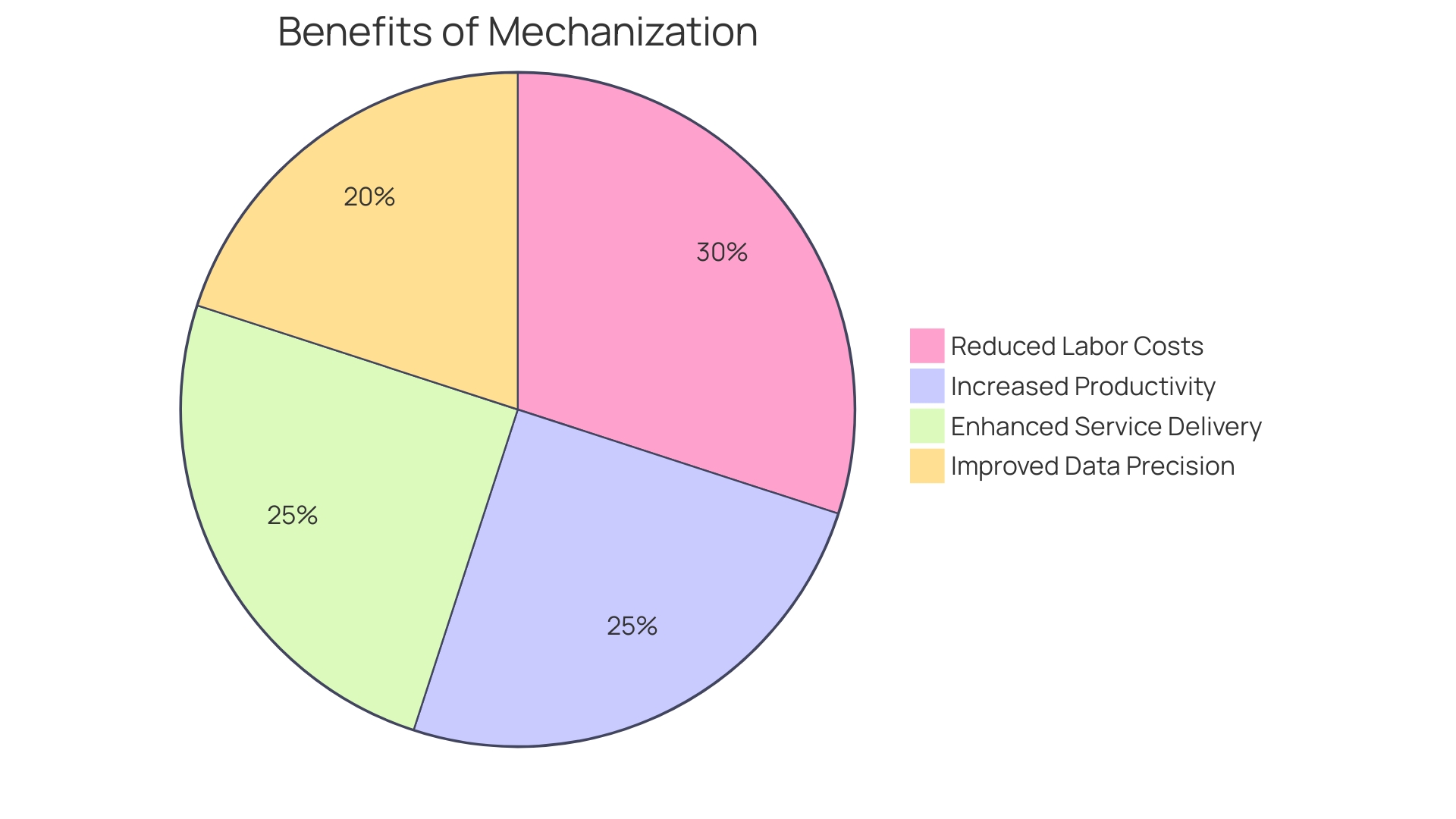
Real-World Examples of Automation
Automation has emerged as a transformative force across various industries, demonstrating its potential to enhance operational efficiency significantly. For instance, Europris, Norway’s leading discount chain, embarked on an ambitious process of mechanization with Swisslog to create a state-of-the-art central warehouse. This initiative aimed to consolidate six warehouses into a single, efficient logistics center. The first phase involved constructing an automated pallet warehouse featuring 65,000 pallet locations and 11 Vectura pallet cranes. This strategic move not only streamlined their operations but also positioned them for future growth in a competitive market.
In the logistics sector, the urgency for mechanization is underscored by the current global shortage of truck drivers, which is projected to worsen. The International Road Transport Union (IRU) states that there are more than 3 million vacant truck driver roles globally, a challenge encouraging companies to investigate mechanization solutions now more than ever. With the growing complexity of logistical operations, businesses are turning to innovative solutions such as autonomous mobile robots and artificial intelligence to optimize product flow and reduce labor dependency.
Moreover, in customer service, the use of chatbots has revolutionized how companies interact with clients. Telecommunications firms have deployed these AI-driven tools to handle thousands of inquiries simultaneously, resulting in improved response times and heightened customer satisfaction. This trend is not just limited to telecommunications; various sectors are leveraging chatbots to enhance service delivery.
These examples illustrate that mechanization is not just a trend but an essential factor for organizations seeking to flourish in today’s ever-changing environment. By clarifying their business needs and establishing guiding principles for technology selection, companies can effectively navigate their processes, ensuring they remain competitive and responsive to market demands.
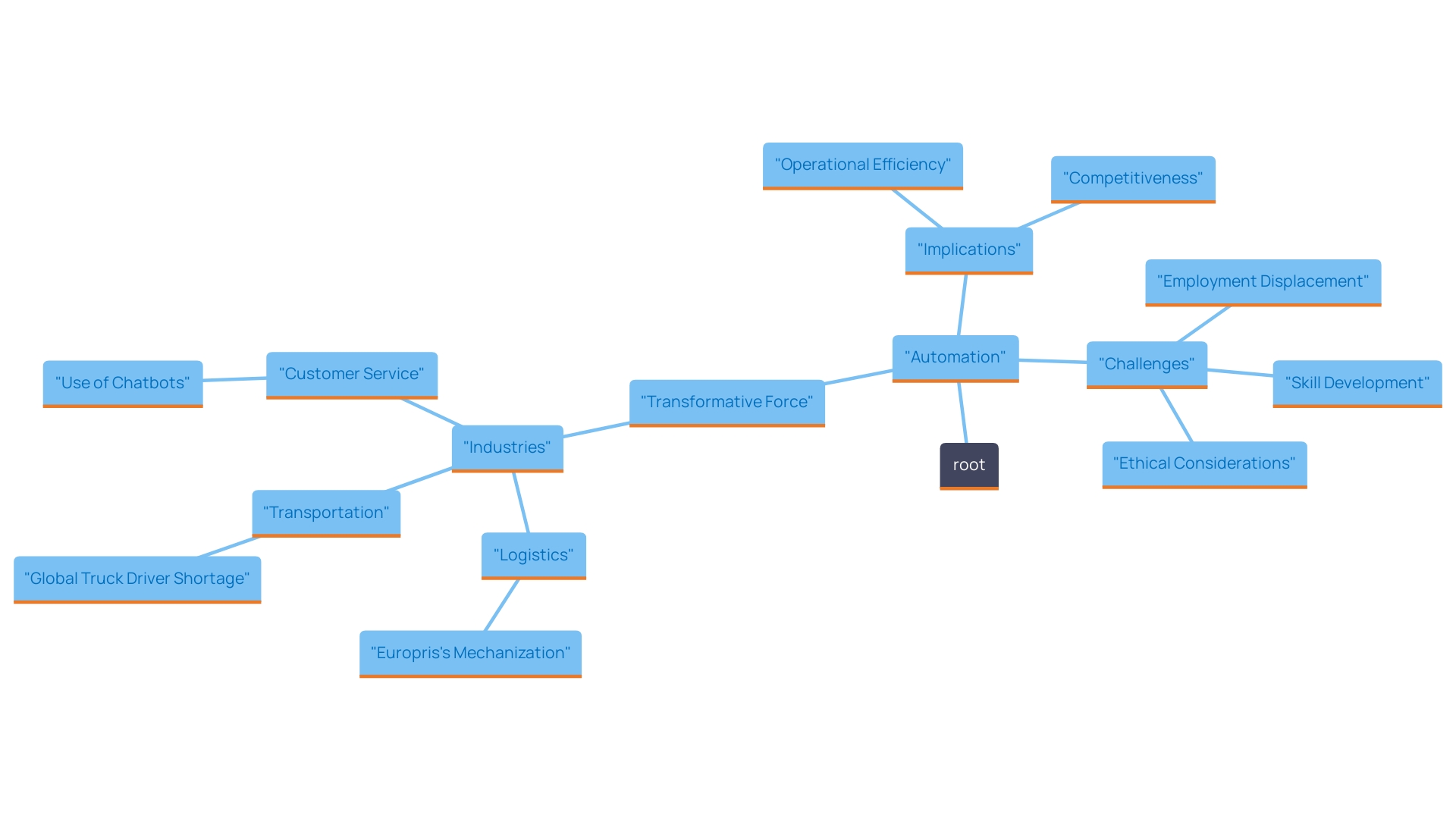
Industry-Specific Automation Solutions
Various sectors display unique mechanization requirements that influence their operational strategies. In manufacturing, the adoption of robotic arms on assembly lines has led to significant enhancements in production efficiency. For example, a recent report emphasized that U.S. industrial firms, utilizing advanced technologies such as AI and robotics, attained total shareholder returns roughly 400 basis points greater than in the prior 15 years, highlighting the financial advantages of mechanization.
In the healthcare sector, mechanization is transforming patient management through advanced scheduling systems and streamlined billing processes. These automated solutions not only reduce administrative burdens but also enhance patient experience by minimizing wait times and errors in billing. A survey indicated that organizations implementing automated dispensing systems in healthcare reported marked improvements in operational accuracy and efficiency.
The retail sector is also undergoing a transition towards mechanization, with systems for self-checkout and advanced inventory tracking becoming widespread. These technologies reduce labor costs and enhance customer satisfaction by providing a seamless shopping experience. Reports indicate that retailers utilizing automated systems have experienced enhanced inventory turnover rates and decreased occurrences of stockouts, further reinforcing the significance of customized mechanization in this sector.
Ultimately, customizing automation solutions to meet the specific demands of each industry is essential for maximizing their impact. As emphasized by industry leaders, the integration of tailored technologies fosters not only operational efficiency but also greater adaptability in the face of emerging challenges, such as supply chain disruptions and evolving consumer expectations.
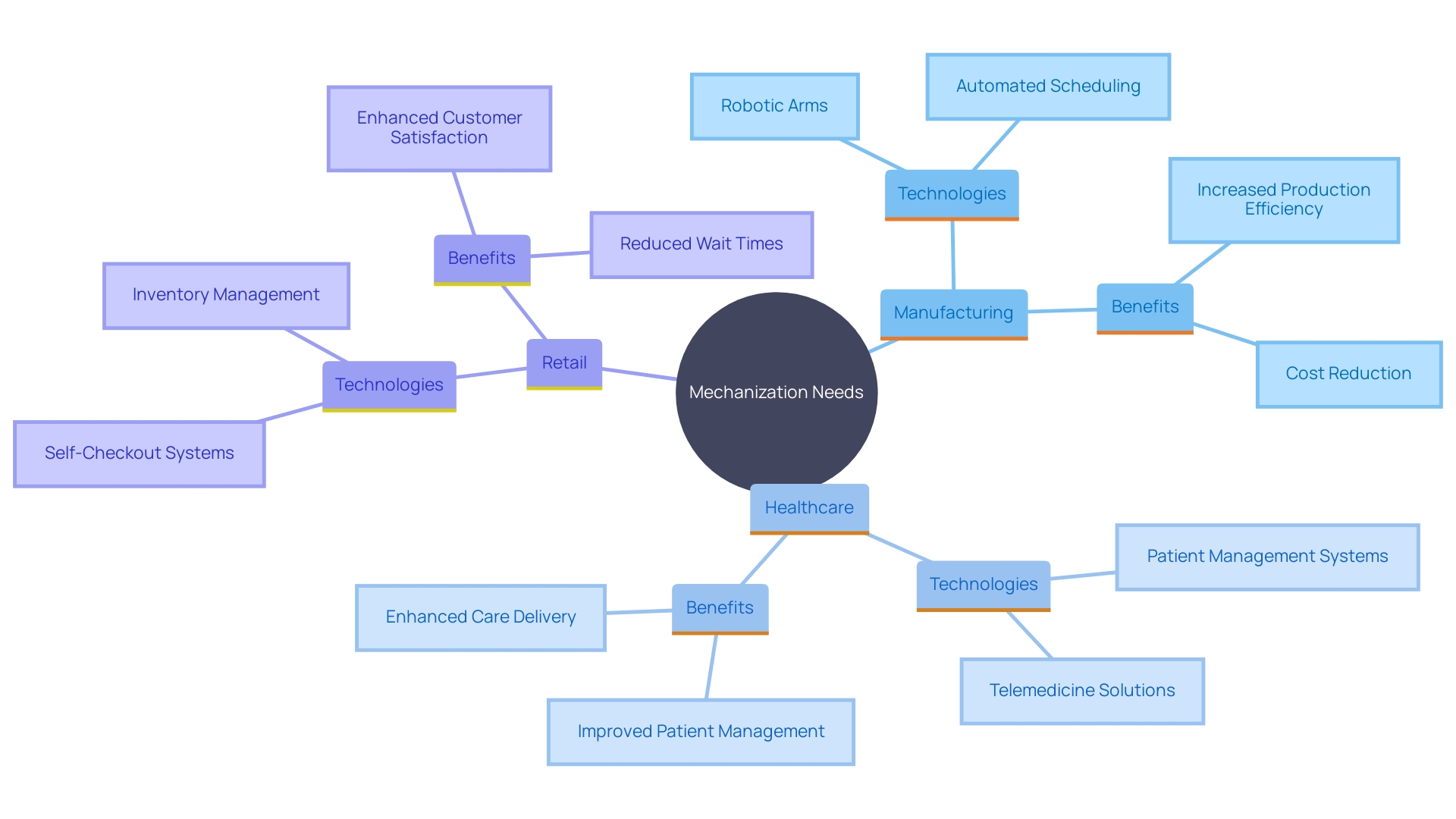
Conclusion
Embracing automation presents a transformative opportunity for organizations across various sectors, addressing the fundamental challenges posed by outdated manual processes. By recognizing the importance of digitization, digitalization, and digital transformation, businesses can effectively streamline their operations and enhance productivity. Success stories from sectors such as manufacturing, healthcare, and retail demonstrate that tailored automation solutions can significantly reduce errors, improve service delivery, and foster a culture of innovation.
The benefits of automation are clear: enhanced operational efficiency, improved data accuracy, and a notable reduction in labor costs. As organizations navigate the complexities of modern operations, it becomes crucial to clearly define their specific needs and challenges. This clarity not only guides the selection of appropriate technologies but also ensures that automation initiatives align with overarching business goals.
Ultimately, the journey toward automation is not just about adopting new technologies; it is about redefining how organizations operate to thrive in an ever-evolving landscape. By harnessing the power of automation, businesses can position themselves for sustained success, remaining competitive and responsive to the demands of the market.
Introduction
In the fast-paced realm of business, operational efficiency has become a critical driver of success. The emergence of robotic process automation (RPA) solutions, particularly through platforms like UiPath, offers a transformative approach to enhance productivity and streamline workflows. With an extensive suite of features designed to accommodate diverse organizational needs, UiPath bots empower teams to automate repetitive tasks, reduce human error, and free up valuable resources for strategic initiatives.
This article delves into the key features and types of UiPath bots, explores the numerous benefits of their implementation, and highlights successful case studies that showcase their impact. Additionally, practical best practices for integrating these automation solutions into business processes will be discussed, along with insights into the future of automation as it converges with artificial intelligence. Embracing these advancements can pave the way for a more efficient, innovative, and responsive work environment, ultimately driving organizations toward greater success.
Key Features of UiPath Bots
The platform offers an extensive suite of features designed to enhance operational efficiency and streamline business processes. Key features include:
-
User-Friendly Interface: The platform features an intuitive drag-and-drop functionality that enables users, regardless of their coding expertise, to easily create workflows. This accessibility facilitates quicker adoption across teams.
-
Scalability: UiPath’s robotic bots are designed to scale, enabling organizations to modify deployment based on changing business requirements without compromising performance. This flexibility ensures that operational demands can be met efficiently at any given time.
-
Integration Capabilities: The platform seamlessly integrates with existing enterprise systems, enabling automation across a variety of applications and processes. This capability enhances workflow continuity and reduces the friction often associated with implementing new tools.
-
Advanced Analytics: The platform offers robust analytics and reporting tools that allow organizations to monitor bot performance closely. This data-driven approach enables teams to identify areas for continuous improvement, supporting ongoing operational enhancements.
-
Robust Security: Security is paramount at this organization, with measures including data encryption and role-based access controls. The platform follows industry compliance standards, ensuring that sensitive data is safeguarded while promoting a secure operational environment.
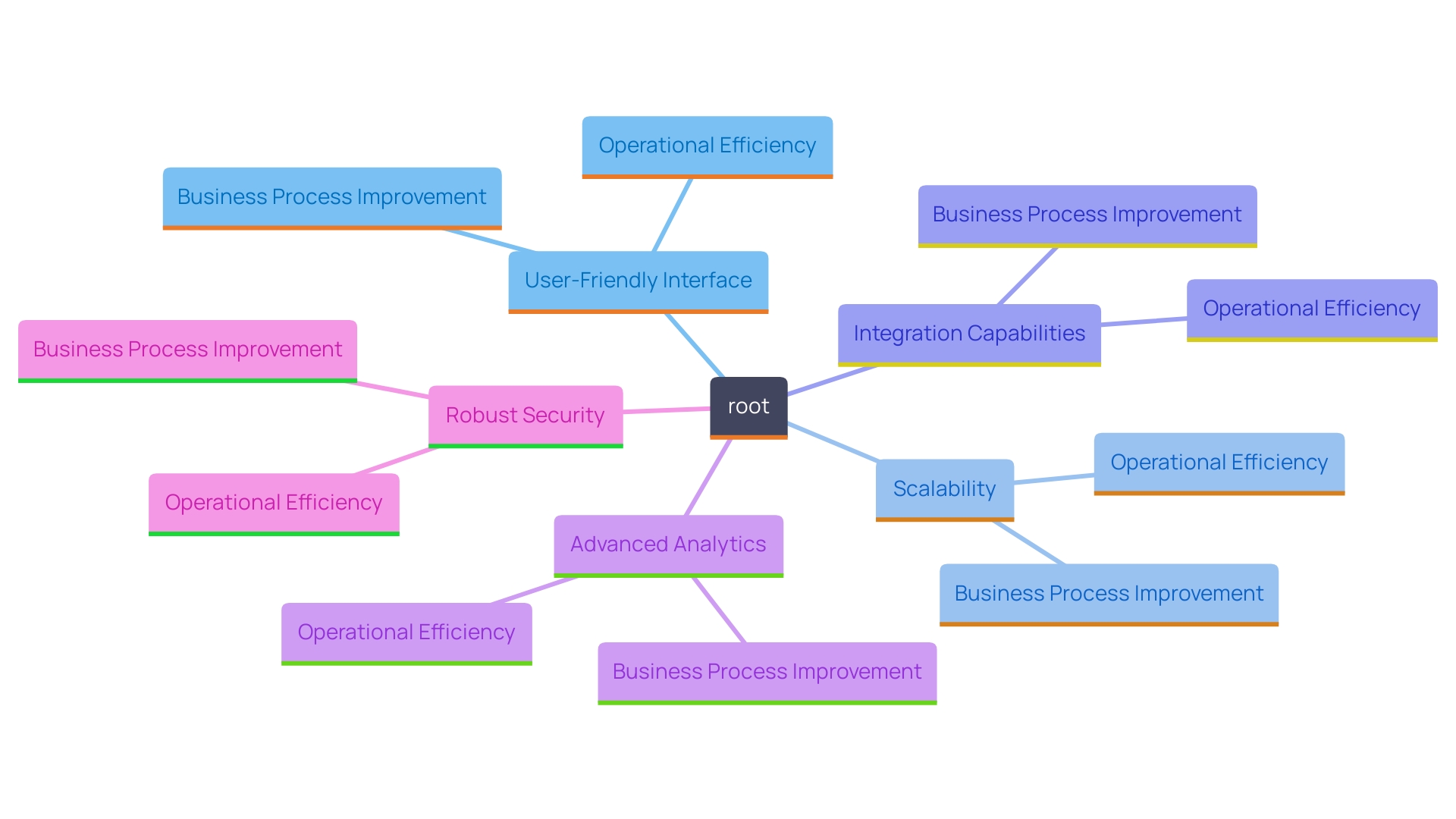
Types of UiPath Bots
UiPath offers a versatile suite of robotic process automation (RPA) solutions categorized into three primary types of bots, each tailored to meet distinct automation requirements within organizations:
-
Attended Automations: These systems collaborate with human staff, streamlining repetitive tasks in real-time. By handling mundane activities, they enhance productivity and free up staff to concentrate on more strategic, value-added tasks. ‘This direct collaboration not only enhances efficiency in operations but also improves job satisfaction by reducing the burden of monotonous work.’.
-
Unattended Automated Systems: Operating independently, unattended automated systems are engineered to autonomously manage back-office operations. They execute high-volume and frequent tasks without any human intervention, making them ideal for processes that demand consistent output and speed. By automating these processes, organizations can significantly lower costs and minimize mistakes, leading to improved overall efficiency.
-
Hybrid Bots: These innovative bots merge the functionalities of attended and unattended bots. They allow for user interactions while simultaneously executing tasks automatically. This flexibility allows organizations to streamline workflows and adjust to differing work demands without sacrificing the human touch when necessary.
In an era where automation is pivotal, implementing these bot types can transform operational landscapes. As noted by industry experts, “Organizations can’t just plug RPA in and let it go.” Continuous monitoring and management remain crucial to harnessing the full potential of RPA technologies. The proper integration of these automated systems can lead to a more efficient, productive, and responsive work environment.
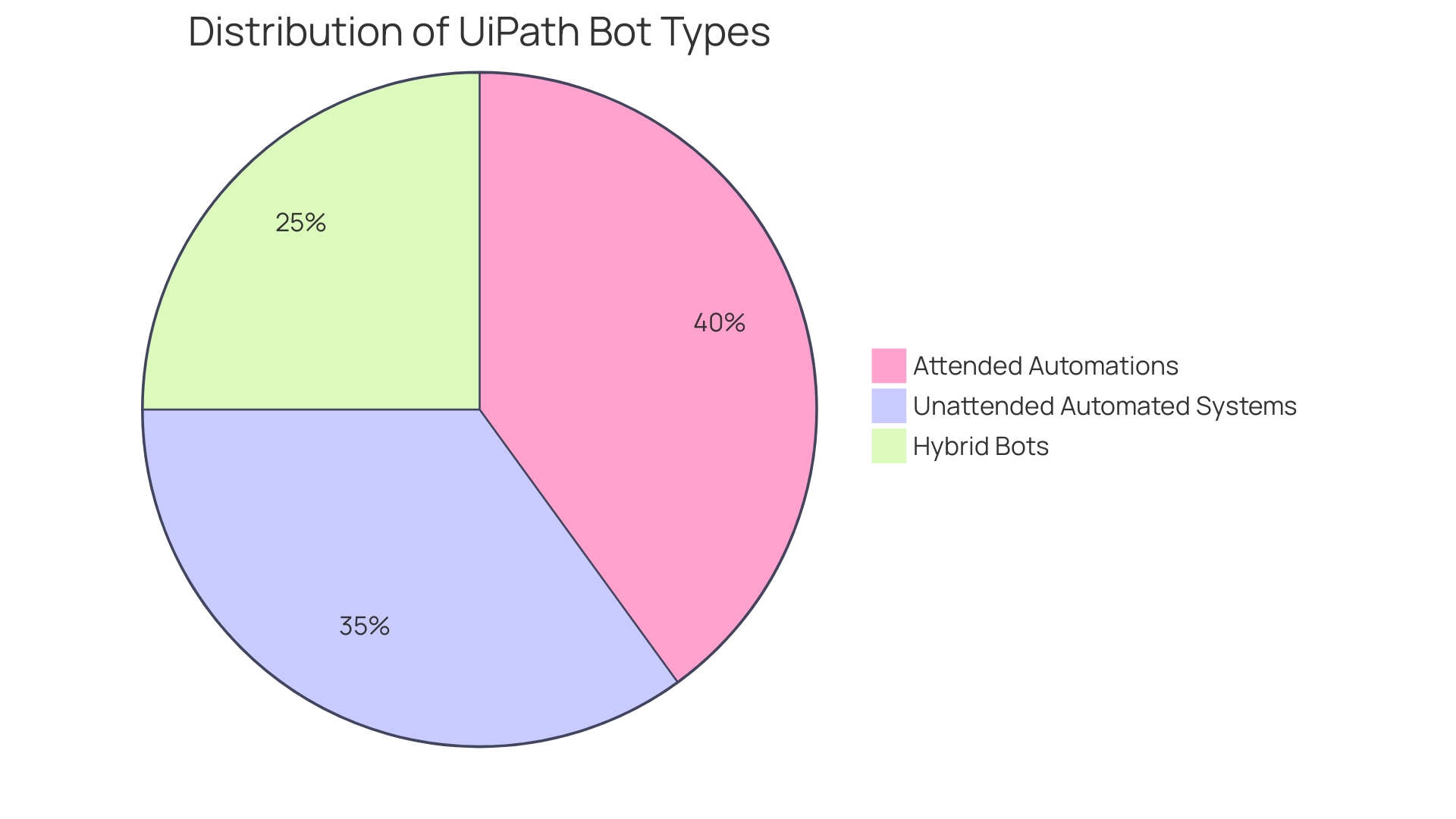
Benefits of Implementing UiPath Bots
Implementing UiPath bots can yield transformative benefits across multiple facets of an organization:
-
Increased Efficiency: Automation of routine and repetitive tasks can drastically reduce processing times and minimize errors. For instance, businesses that previously took hours to build forms now complete the task in under a minute, realizing significant time savings. This enhancement in efficiency not only streamlines operations but also allows teams to focus on higher-value activities, fostering a more productive work environment.
-
Cost Savings: By decreasing dependence on manual labor, mechanization can result in significant operational cost reductions. Organizations can redirect resources—whether financial or human—towards strategic initiatives that drive growth. A relevant example is OnCall Health, where streamlining form creation saved hundreds of hours and effectively corresponded to the salary of a whole employee, emphasizing the financial effect of such improvements.
-
Improved Employee Satisfaction: Employees freed from monotonous tasks tend to report higher levels of job satisfaction. This shift enables them to engage in more meaningful work, which not only enhances morale but also increases retention rates. Reports indicate that professionals dedicated to automation projects experience enhanced job satisfaction and are more engaged in their roles, which is crucial in maintaining a motivated workforce.
-
Enhanced Compliance: Automation tools guarantee that processes are carried out uniformly, following regulatory standards and minimizing the chance of non-adherence. By following predefined rules and instructions, these bots facilitate a structured approach to compliance, allowing organizations to navigate complex regulatory landscapes with greater confidence. The growing emphasis on compliance in data-heavy industries underscores the necessity of such automated solutions.
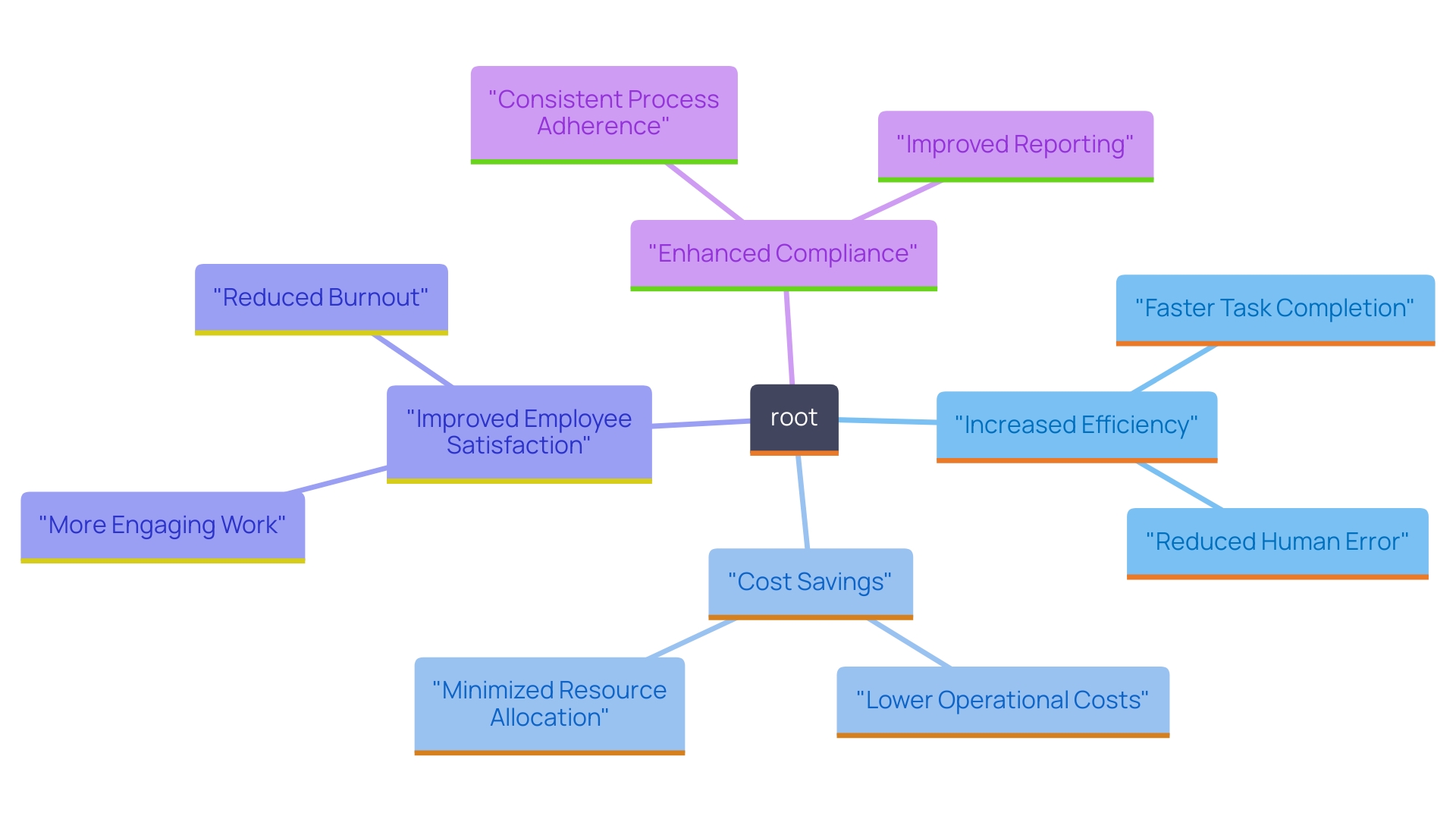
Case Studies: Successful Automation with UiPath
Organizations are increasingly turning to UiPath for automation solutions, and the results speak volumes:
1. Deloitte: By utilizing automation technology to streamline its financial processes, Deloitte achieved a remarkable 70% reduction in processing time, all while enhancing accuracy. This transformation not only streamlined their operations but also allowed employees to focus on more strategic tasks.
2. Siemens: This industrial giant employed automation technology to optimize its procurement processes, resulting in a 50% decrease in manual effort. The effect on efficiency was significant, enabling Siemens to allocate resources more effectively and enhance overall productivity.
3. Cognizant: By utilizing automation, Cognizant transformed its client onboarding processes, slashing onboarding time by 80%. This impressive acceleration not only enhanced operational efficiency but also greatly improved client satisfaction, allowing Cognizant to deliver services faster and more effectively.
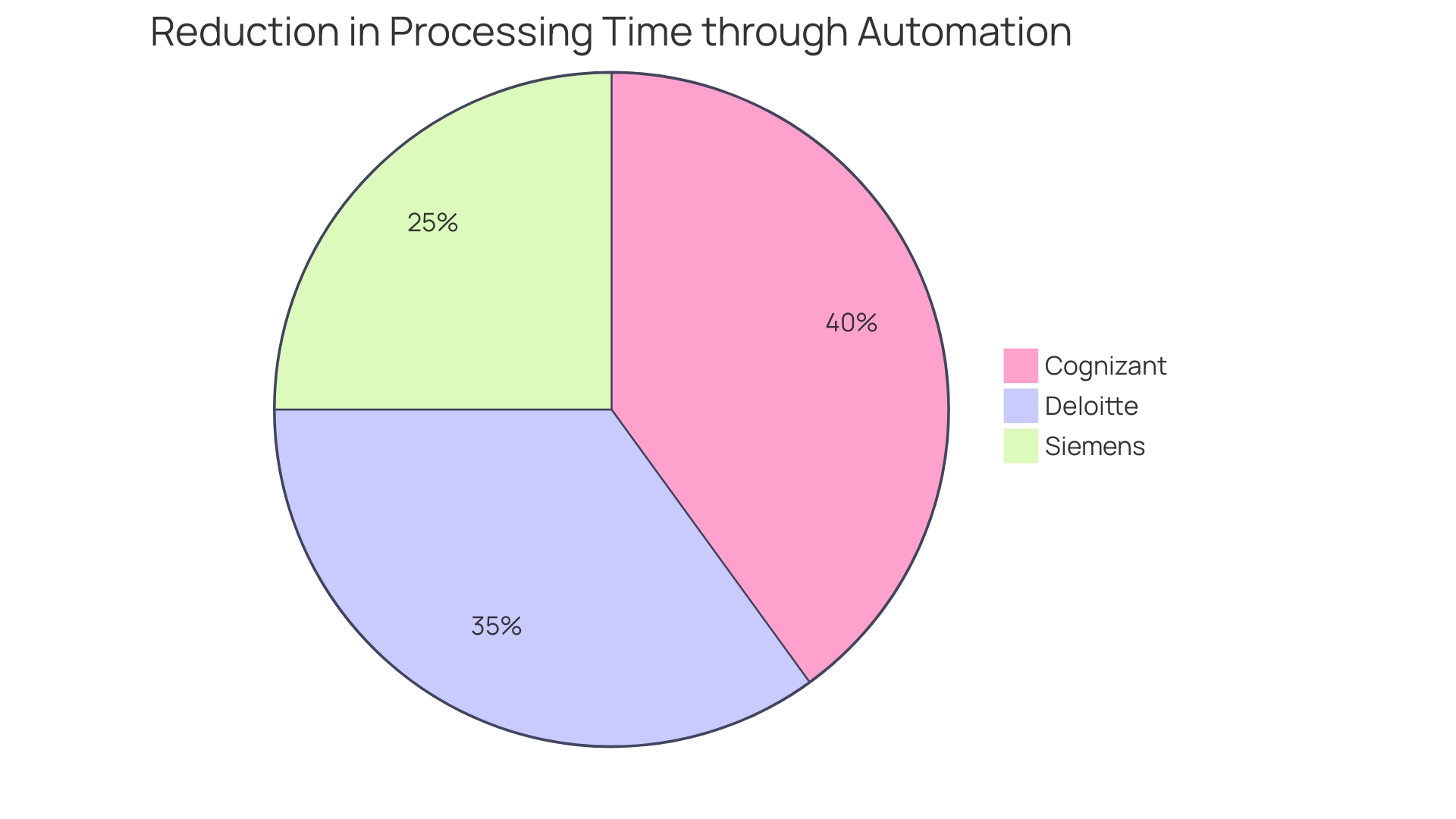
Best Practices for Implementing UiPath Bots in Business Processes
To harness the full potential of UiPath bots, it’s essential to adopt a series of strategic best practices:
-
Identify High-Impact Processes: Prioritize automating processes that are repetitive and time-consuming. This approach not only enhances efficiency but also delivers immediate value to the organization.
-
Engage Stakeholders: Involving pertinent stakeholders during the process of mechanization is essential. Their insights can guide decisions and ensure alignment across departments, fostering a collaborative atmosphere that can facilitate the shift to mechanization.
-
Monitor and Optimize: Continuous monitoring of bot performance is vital. Gathering opinions and examining information enables organizations to improve procedures and boost efficiency over time.
-
Train and Upskill Employees: Providing comprehensive training on how to collaborate effectively with bots empowers employees. This investment in skill development ensures that the workforce is well-equipped to utilize technology, thereby maximizing productivity.
Applying these practices can greatly enhance process efficiency, making this platform a powerful partner in the journey toward digital transformation.
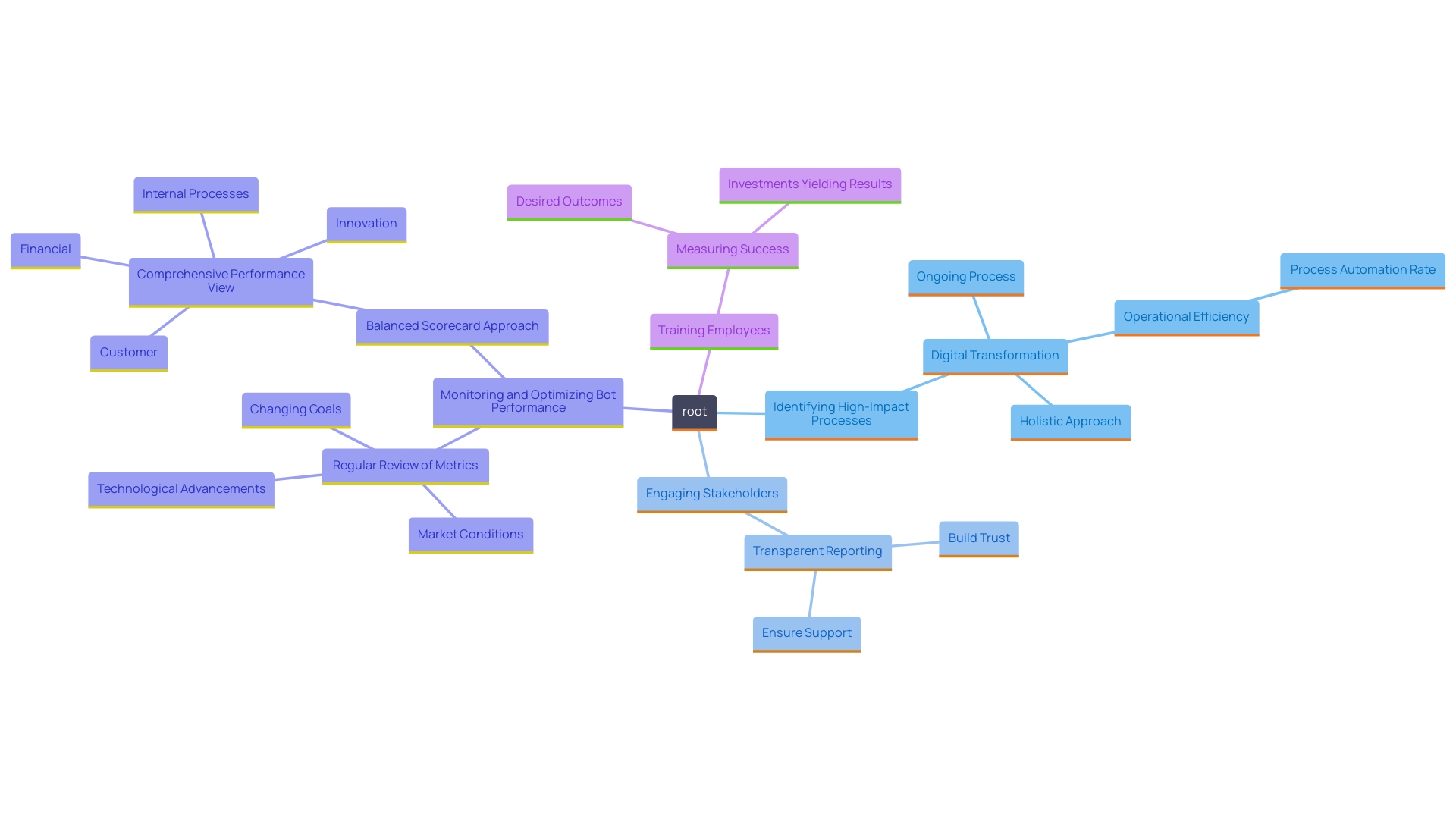
Future of Business Automation with UiPath and AI
The terrain of business mechanization is rapidly evolving, particularly with the seamless integration of AI technologies into platforms like UiPath. This convergence empowers organizations to leverage AI-driven insights, enabling bots to undertake increasingly complex tasks, uncover data patterns, and make real-time, informed decisions that enhance operational efficiency.
As businesses navigate the challenges of existing systems, which may be intricate and longstanding, the potential of integrating AI without a complete overhaul becomes a crucial asset. A simulated case study illustrates how a company successfully incorporated AI into its workflows, demonstrating that significant system changes are not always necessary for innovation.
The results of this integration are compelling. Businesses have shared life-changing experiences where mechanization serves as the limbs, while AI operates as the brain, offering significant context for important decisions. This synergy not only streamlines processes but also fosters innovative business models that elevate customer experiences.
Moreover, UiPath’s recognition as a leader in the IDC MarketScape for Intelligent Document Processing highlights its pivotal role in the automation sphere, solidifying its status as a trusted partner in this technological evolution. As organizations increasingly embrace these advancements, the ability to integrate AI effectively without disrupting established workflows will be a game-changer, setting the stage for future growth and efficiency.
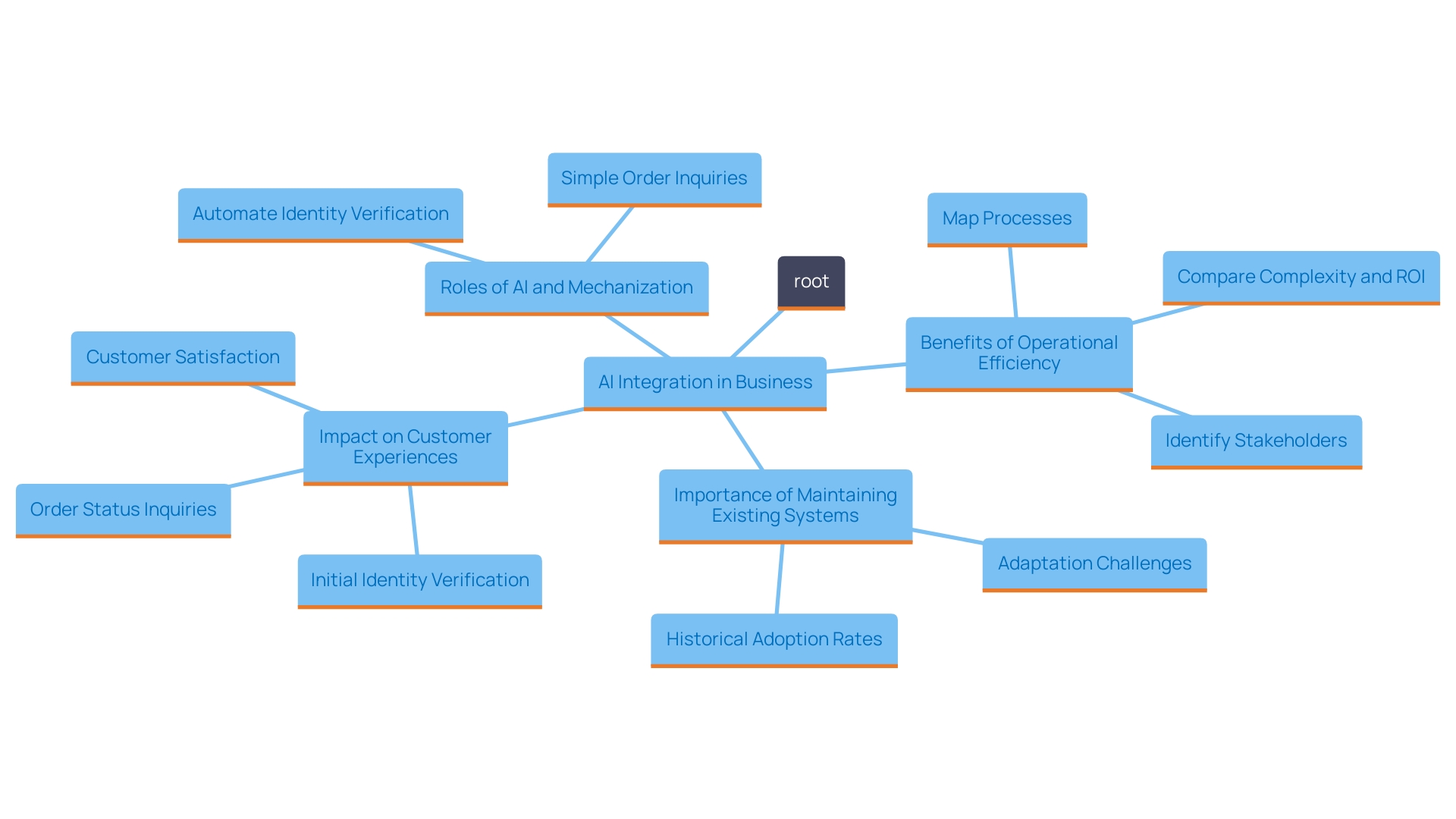
Conclusion
Operational efficiency is increasingly vital in today’s business landscape, and the implementation of UiPath bots presents a powerful solution to enhance productivity and streamline processes. Key features such as a user-friendly interface, scalability, and robust security enable organizations to adopt automation with confidence. The diverse types of bots—attended, unattended, and hybrid—cater to various needs, ensuring that businesses can optimize their operations effectively.
The benefits of integrating UiPath bots are substantial. Increased efficiency and significant cost savings allow teams to focus on strategic initiatives, while improved employee satisfaction and enhanced compliance reinforce the overall value of automation. Successful case studies from industry leaders like Deloitte, Siemens, and Cognizant illustrate the tangible impact of these solutions, showcasing remarkable improvements in processing times and operational effectiveness.
To maximize the potential of UiPath bots, best practices such as identifying high-impact processes, involving stakeholders, and continuously monitoring performance should be prioritized. As the integration of AI into automation solutions continues to evolve, organizations are well-positioned to leverage these advancements without overhauling existing systems. This synergy between automation and AI not only streamlines workflows but also fosters innovative business models.
Embracing UiPath bots and their capabilities paves the way for a more efficient, responsive, and innovative work environment. As organizations navigate the complexities of modern business, the strategic implementation of automation solutions will be a crucial driver of success, ultimately leading to sustainable growth and enhanced competitiveness.
Introduction
In the rapidly evolving landscape of banking, automation is not just a trend but a necessity that drives operational efficiency and enhances customer experience. By streamlining repetitive tasks, reducing human error, and accelerating transaction processing, automation is transforming the way banks operate. This transformation is backed by technological advancements and changing consumer habits, pushing banks to adopt new technologies that ensure high levels of security and compliance.
Institutions like M&T Bank and Capital One exemplify the benefits of automation. M&T Bank’s implementation of Clean Code standards has significantly reduced application maintenance time, while Capital One’s transition to the cloud has fostered a culture of collaboration and innovation. These examples highlight how automation can lead to substantial productivity improvements, as evidenced by Accenture’s analysis, which indicates that 73% of time spent by US bank employees could be impacted by generative AI.
Moreover, the deployment of industrial robots and automation tools extends beyond efficiency, contributing to cost reduction and optimal resource allocation. As the financial sector continues to embrace these advancements, the potential for automation to enhance profitability and competitive positioning becomes increasingly evident.
Benefits of Automation in Banking
Automation in banking significantly reshapes operational efficiency by streamlining repetitive tasks, reducing human error, and accelerating transaction processing. This rapid transformation is driven by changing consumer habits, competitive pressures, and technological advancements. The trend towards an all-digital customer experience is causing rapid adoption of new technologies, ensuring the highest levels of security and compliance with stringent regulatory requirements.
Take, for instance, M&T Bank, a 165-year-old institution that has embraced automation to support maintainability and performance of its software. By establishing Clean Code standards across its development teams, the financial institution minimized application maintenance time and costs while ensuring software efficiency, reliability, and security. This approach not only enhances service delivery but also allows the institution to respond promptly to customer needs.
Likewise, Capital One’s full shift to the cloud shows how mechanization can promote a cooperative company culture. Over 50,000 employees utilize Slack each week to streamline tasks and encourage change throughout all divisions, highlighting the organization’s dedication to innovation and operational excellence.
The effect of mechanization is considerable, with Accenture’s analysis suggesting that 73% of time utilized by US bank employees could be influenced by generative AI—39% via mechanization and 34% through enhancement. This potential for productivity enhancement highlights the significance of mechanization in competitive market settings.
Moreover, as highlighted by the International Federation of Robotics, the deployment of industrial robots has surged, with around 3.5 million units worldwide. This trend is mirrored in the banking sector, where automation’s role extends beyond efficiency to include cost reduction by minimizing manual labor and optimizing resource allocation. Ultimately, this enhances profitability and positions banks to thrive in a competitive market.
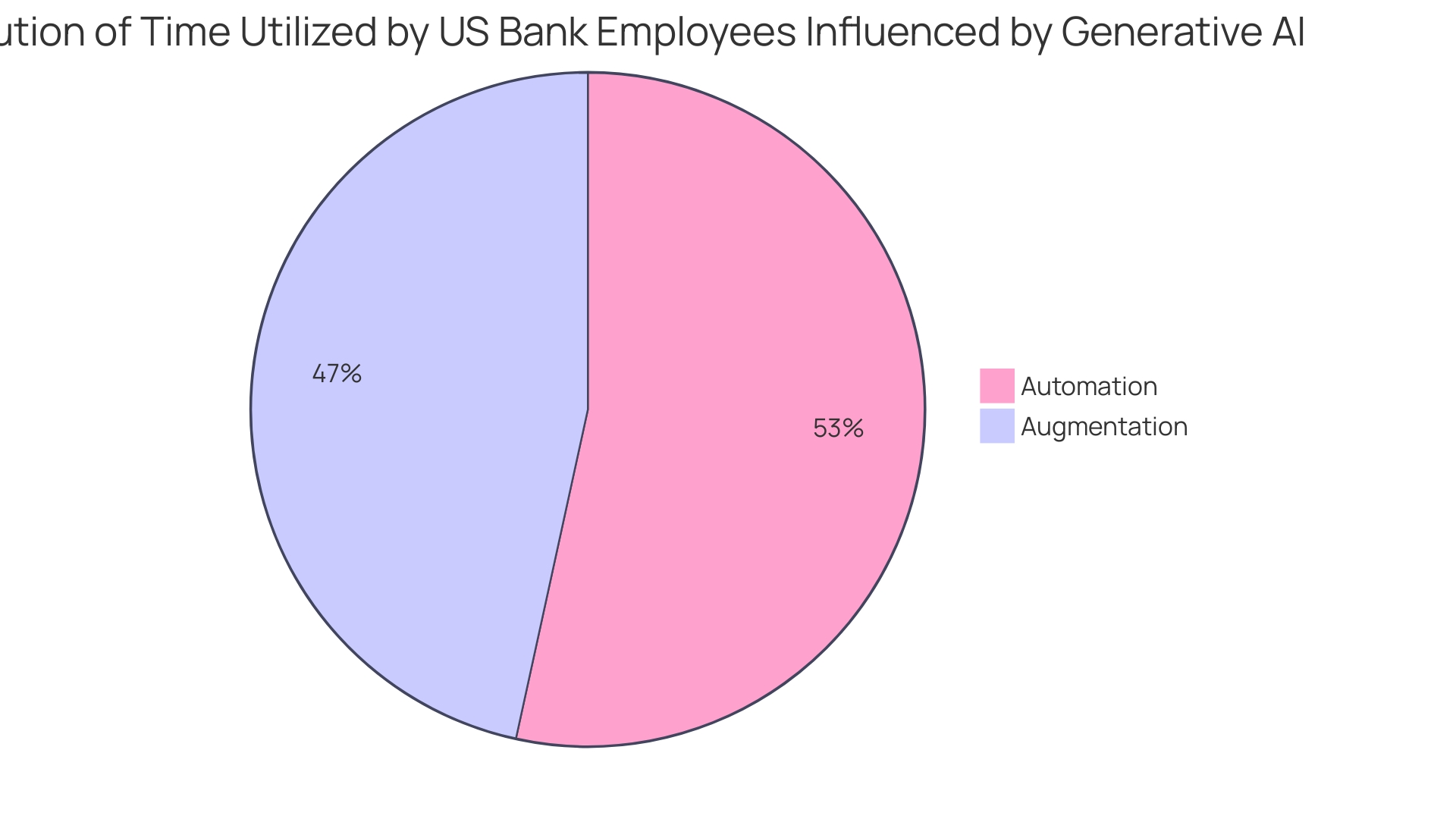
Key Automation Techniques in Banking
Automation in the banking sector has significantly evolved with the implementation of various sophisticated technologies. Robotic Process Automation (RPA) stands out by handling high-volume tasks such as data entry, transaction processing, and account reconciliation. These software robots replicate human actions across different systems, streamlining operations and reducing manual effort.
Intelligent Document Processing (IDP) leverages artificial intelligence (AI) and machine learning (ML) to manage unstructured data efficiently. It includes key functionalities like Optical Character Recognition (OCR) for converting images to text, and data extraction for retrieving specific information from documents. This technology is invaluable in processing loan applications, insurance claims, and other document-heavy workflows, enhancing accuracy and speed.
Automated Relationship Management (CRM) systems also play a crucial role by refining interactions with clients. By utilizing AI, these systems offer tailored assistance and prompt follow-ups, resulting in enhanced client satisfaction and loyalty. As one industry expert noted, integrating tools like Tungsten solutions into mobile apps allows users to access necessary services anytime and anywhere, thereby boosting engagement and retention.
These advancements highlight the transformative effect of mechanization in the financial sector, offering streamlined processes, enhanced accuracy, and superior customer experiences.
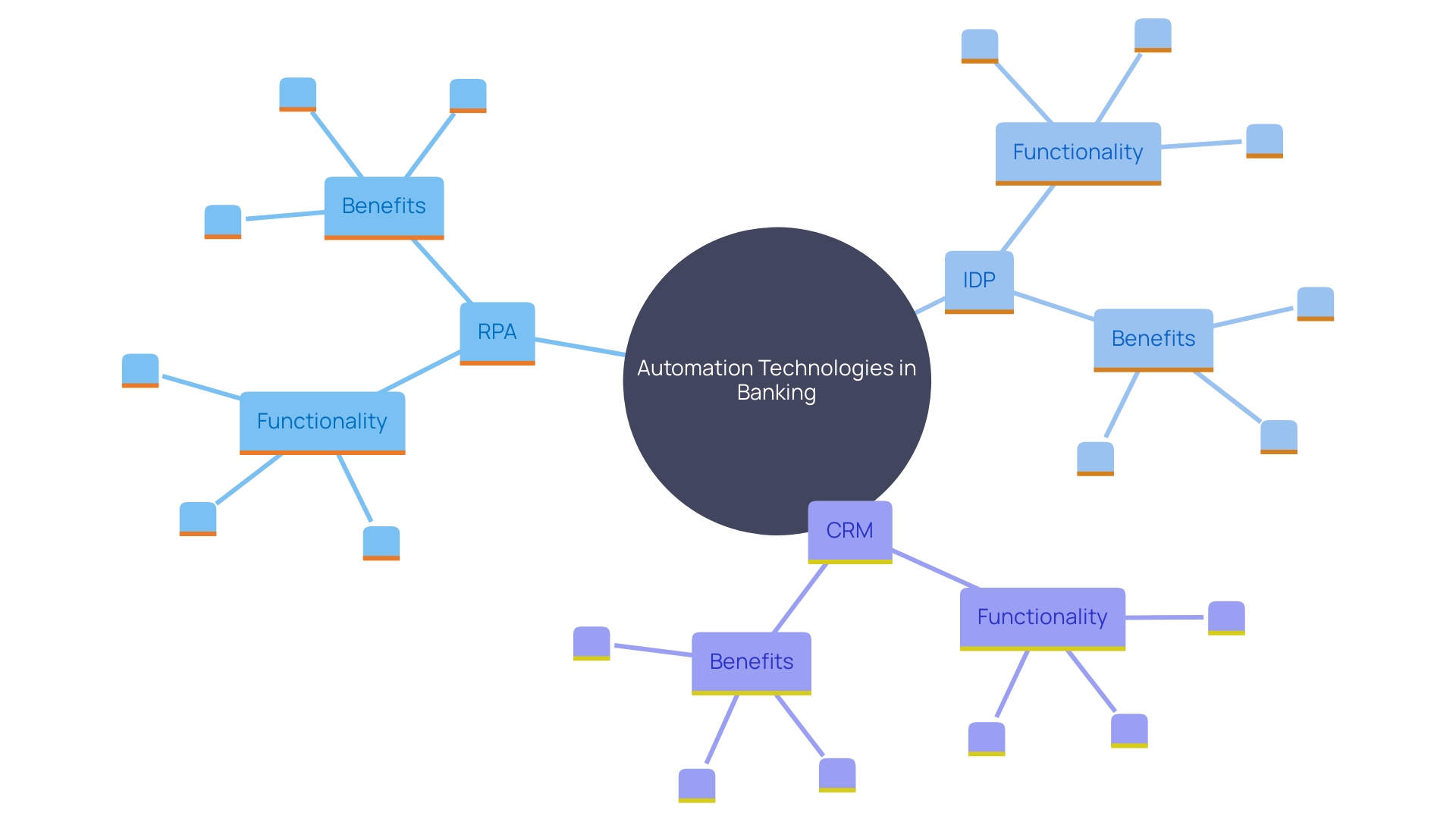
Streamlining Financial Processes with Automation
Automation is revolutionizing financial processes such as loan approvals, account management, and compliance reporting, leading to significant efficiency gains. By integrating automated workflows, banks can drastically cut down processing times and enhance accuracy. For instance, TBC Bank in Georgia, which aims to improve its time-to-market for digital products, leverages automation to provide an extraordinary banking experience. Automated loan processing systems can assess creditworthiness in real-time, expediting approvals and boosting customer satisfaction. M&T Bank, a major U.S. commercial bank, highlights the importance of maintaining stringent regulatory compliance through automated reporting, significantly reducing the risk of human error and ensuring data security. As AI and machine learning become more pervasive, the potential for automation in financial operations is vast, with up to 80% of these tasks being automatable. This not only frees up employee time for strategic initiatives but also enhances overall operational efficiency.
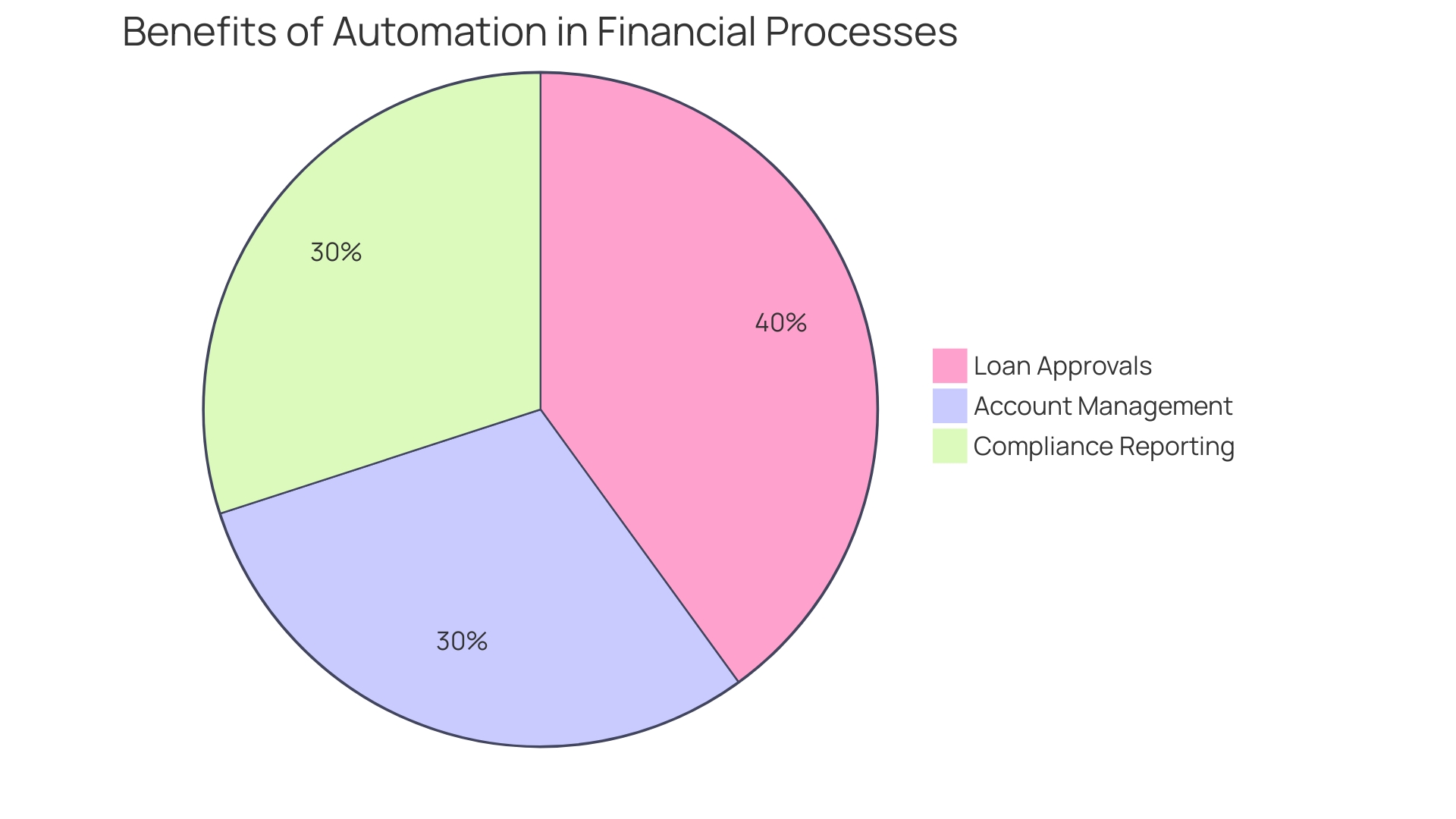
Enhancing Customer Service through Automation
Automation in customer support within the banking sector is transforming the manner in which financial institutions engage with their clients. By leveraging advanced tools such as chatbots and virtual assistants, banks can offer round-the-clock support, addressing queries and resolving issues without the need for human intervention. This not only improves response times but also guarantees a consistent level of support.
For instance, Capital One’s digital transformation efforts, including their use of Slack to streamline and automate workflows, have set a benchmark in the industry. ‘With more than 50,000 staff members working together on this platform, Capital One has nurtured a culture of innovation that reaches its client support operations.’. Their chatbot, Eno, demonstrates how automation can provide personalized interactions by analyzing data and customizing offerings to individual preferences.
Similarly, ING’s partnership with McKinsey to develop a generative AI-driven chatbot has shown significant results. In the Netherlands, ING’s chatbot handles 40-45% of inquiries, significantly reducing the need for live agent intervention. This method not only fulfills client requirements more effectively but also enables the bank to expand its assistance capabilities across various markets.
The incorporation of AI in client support is becoming increasingly common. A report by 8×8 shows that contact centers are on the verge of a new era with conversational AI, which promises to provide the convenience and consistency that clients require. More than 63% of retail firms have already incorporated AI into their support strategies, with many seeing enhanced efficiency and savings in expenses.
However, it’s important to recognize the challenges that come with implementing AI, such as high initial costs and data privacy concerns. Regardless of these obstacles, the possible advantages of AI in improving client support are undeniable. As JPMorgan Chase’s recent introduction of their LLM Suite demonstrates, AI can significantly augment traditional roles, providing faster and more precise responses to client needs.
Ultimately, the push towards automation in banking is driven by the need to meet growing client expectations for immediate and reliable service. As more financial institutions utilize AI-driven tools, the sector is set to provide more effective, tailored, and high-caliber customer interactions.
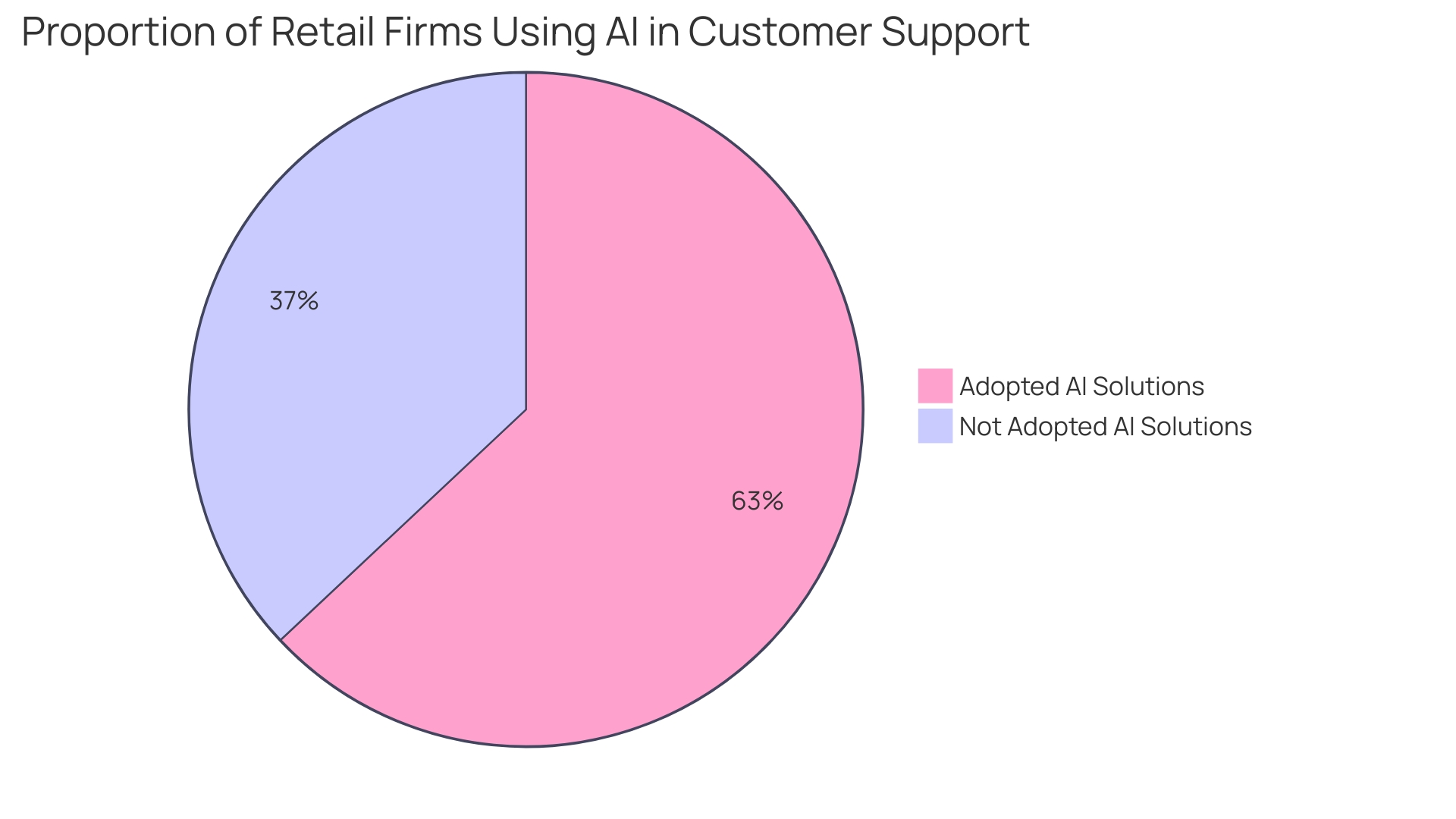
Improving Operational Efficiency and Compliance
Operational efficiency in banking is crucial for maintaining competitiveness. Automation not only streamlines processes but also integrates compliance checks into workflows, ensuring adherence to regulatory standards. By automating compliance processes, financial institutions can mitigate risks associated with manual oversight and maintain accurate records, which are essential for audits and regulatory reporting.
A prime example of this is TBC Bank in Georgia, which has successfully utilized technology to enhance its operational efficiency and improve its digital product time-to-market. This move aligns with the institution’s mission to make people’s lives easier and provide an extraordinary financial experience.
Similarly, M&T Bank has recognized the need for stringent regulatory compliance in the face of rapid digital transformation. By implementing Clean Code standards, M&T Bank ensures that its software maintains high quality and compliance, thereby reducing the risk of security breaches and financial losses.
The importance of mechanization in the financial sector is highlighted by the potential productivity enhancement for early adopters. Accenture’s analysis indicates that 73% of the time spent by US financial institution employees could be influenced by generative AI, with 39% impacted by mechanization and 34% by enhancement. This underscores the extensive advantages of mechanization across different banking positions, from the C-suite to frontline service.
Moreover, the recent MoveIt breaches impacting 60 financial institutions, including Flagstar, underscore the importance of robust automated compliance systems. These breaches have prompted banks to take immediate action to address vulnerabilities and safeguard sensitive information, demonstrating the essential role of technology in enhancing operational resilience.
In conclusion, as the global financial sector grows more intricate and linked, the implementation of automated processes is crucial for ensuring compliance, reducing risks, and enhancing overall operational efficiency.
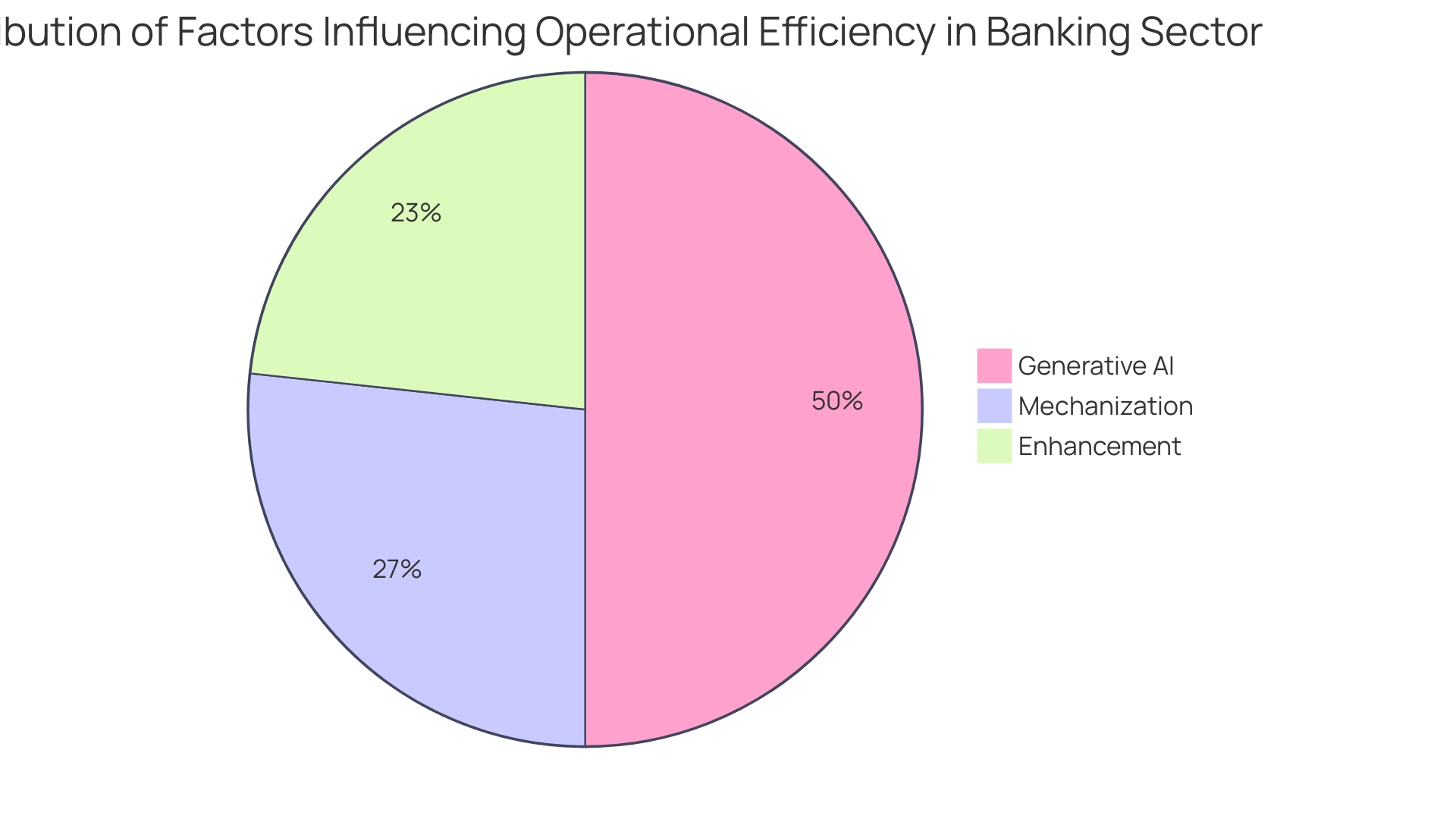
Best Practices for Implementing Banking Automation
Attaining effective mechanization in banking requires a carefully planned approach. The journey starts with a thorough evaluation of existing procedures to identify opportunities for mechanization. Engaging stakeholders throughout the implementation phase ensures buy-in and smooth transitions. Training staff is crucial, as they need to adapt to new technologies and workflows effectively.
Choosing the right technology partners is equally important. For instance, TBC Bank in Georgia has significantly enhanced its digital product offerings and customer experience by partnering with cutting-edge technology providers. This collaboration has allowed them to innovate continuously and maintain a competitive edge.
Moreover, continuous monitoring and evaluation of automated solutions are vital. M&T Bank, a leading U.S. financial institution, exemplifies this by adhering to stringent Clean Code standards. This practice not only ensures high-quality software but also maintains compliance, thereby mitigating risks associated with digital transformation.
Based on Accenture’s findings, mechanization has the capacity to influence 73% of duties carried out by financial institution staff, with 39% being entirely mechanized. This highlights the transformative power of mechanization in enhancing productivity and operational efficiency. By adhering to these optimal methods, banks can maneuver through the intricacies of mechanization and reveal significant benefits for both their clients and staff.

Future of Banking Automation and Its Impact
The future of banking automation is set for unprecedented growth with the incorporation of artificial intelligence (AI), machine learning, and blockchain technologies. These advancements are not just enhancing operational efficiency but also transforming customer experience. Banks like Capital One have already demonstrated the potential of going all-in on cloud technology, fostering a culture of innovation and digital transformation across various departments. This move has enabled them to offer more sophisticated services and maintain a competitive edge.
Additionally, initiatives like Appli are revolutionizing the lending process by integrating AI models that provide real-time feedback and Educational Insights to consumers. This helps both underbanked individuals and financial institutions make informed decisions, reducing application fears and streamlining processes.
The banking sector must ensure the highest quality and compliance of the software it deploys to avoid security breaches and financial losses. M&T Bank’s establishment of organization-wide Clean Code standards exemplifies the industry’s commitment to maintaining robust and reliable operations.
With the rapid industrialization and technological advancements in regions like Asia-Pacific, the integration of AI and blockchain is expected to grow swiftly, driven by supportive government policies and a large pool of skilled labor. This global trend underscores the urgency for traditional financial institutions to adapt and innovate to stay relevant in this evolving landscape.
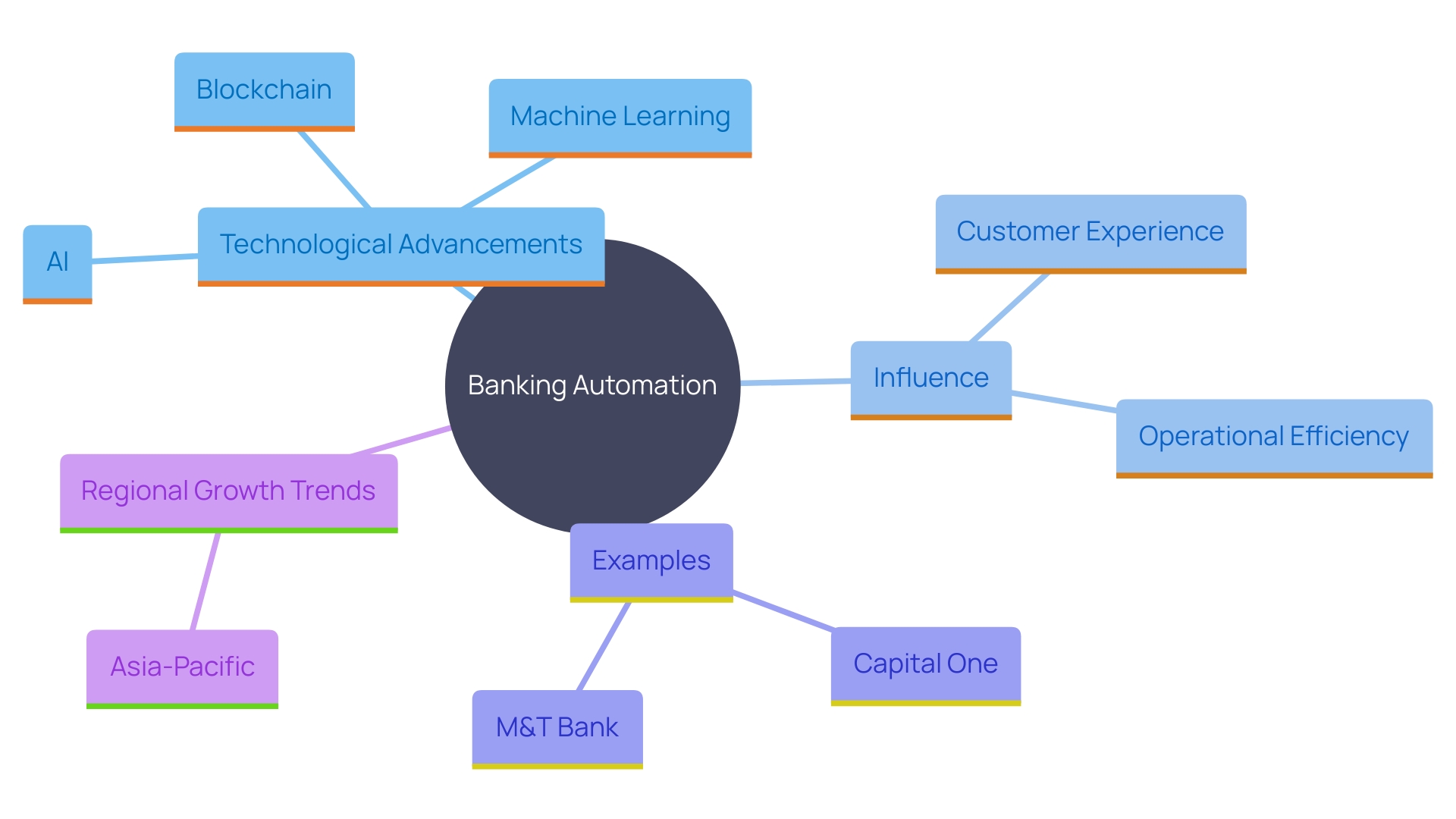
Conclusion
The adoption of automation in banking represents a significant shift towards enhanced operational efficiency and improved customer experiences. By streamlining repetitive tasks and minimizing human error, banks can not only accelerate transaction processing but also respond more effectively to the evolving needs of their customers. Institutions like M&T Bank and Capital One serve as prime examples, demonstrating how automation can lead to substantial productivity improvements and foster a culture of innovation.
Moreover, the integration of advanced technologies such as Robotic Process Automation (RPA) and Intelligent Document Processing (IDP) showcases the transformative impact of automation on financial workflows. These tools not only enhance accuracy but also free up valuable employee time for strategic initiatives, ultimately driving profitability and competitive positioning in a rapidly changing market.
As banks continue to embrace automation, it is crucial to implement best practices that ensure successful integration. Engaging stakeholders, continuous training, and choosing the right technology partners are essential steps in this journey. Additionally, the ongoing evaluation of automated solutions is vital for maintaining high standards of quality and compliance, safeguarding against potential risks.
Looking ahead, the future of banking automation is poised for remarkable growth, fueled by advancements in AI, machine learning, and blockchain technologies. As institutions adapt to these innovations, the potential for delivering exceptional customer service and operational excellence will only expand. Embracing automation is not merely an option; it is a necessity for banks aiming to thrive in an increasingly competitive landscape.
Introduction
Robotic Process Automation (RPA) Business Analysts are pivotal in bridging the gap between technology and business, playing a crucial role in deploying and managing RPA systems. These professionals ensure that automation initiatives align seamlessly with an organization’s strategic objectives by meticulously analyzing workflows and identifying automation opportunities. This leads to streamlined processes, reduced operational costs, and enhanced efficiency.
As highlighted in the Global State of Business Analysis Report, the evolving role of RPA Business Analysts underscores the growing importance and maturity of this profession. Companies like Transcom exemplify the successful integration of RPA Business Analysts in driving innovation and operational excellence through automation. As businesses navigate the complexities of modern environments, the expertise of RPA Business Analysts remains essential for sustainable growth and competitive advantage.
Understanding the Role of RPA Business Analysts
‘RPA Business Analysts are essential in the implementation and oversight of robotic workflow systems.’. They serve as the essential link between technical teams and organizational stakeholders, ensuring that RPA initiatives are perfectly aligned with the entity’s strategic goals. By meticulously analyzing workflows, they pinpoint opportunities for automation, which leads to streamlined operations, reduced operational costs, and enhanced efficiency.
‘Their expertise in understanding organizational requirements and process intricacies is vital for developing effective RPA strategies.’. ‘According to the Global State of Analysis Report, which surveyed over 4,400 professionals from 165 countries, the role of analysts is evolving, with a significant shift in the predominant age group of respondents from 25-35 to 36-45, highlighting the growing importance and maturity of the profession.’.
For instance, companies like Transcom have effectively utilized RPA Business Analysts to incorporate digital tools and platforms, applied insights, and operational excellence through automation. This approach not only improves efficiency but also fosters innovation by transforming custom technology incubations into commercial solutions.
As the sector continues to evolve, the role of RPA Analysts will remain critical in navigating the complexities of contemporary environments and driving sustainable growth. ‘Their ability to bridge the gap between technology and commerce is not just a necessity but a strategic advantage.’.
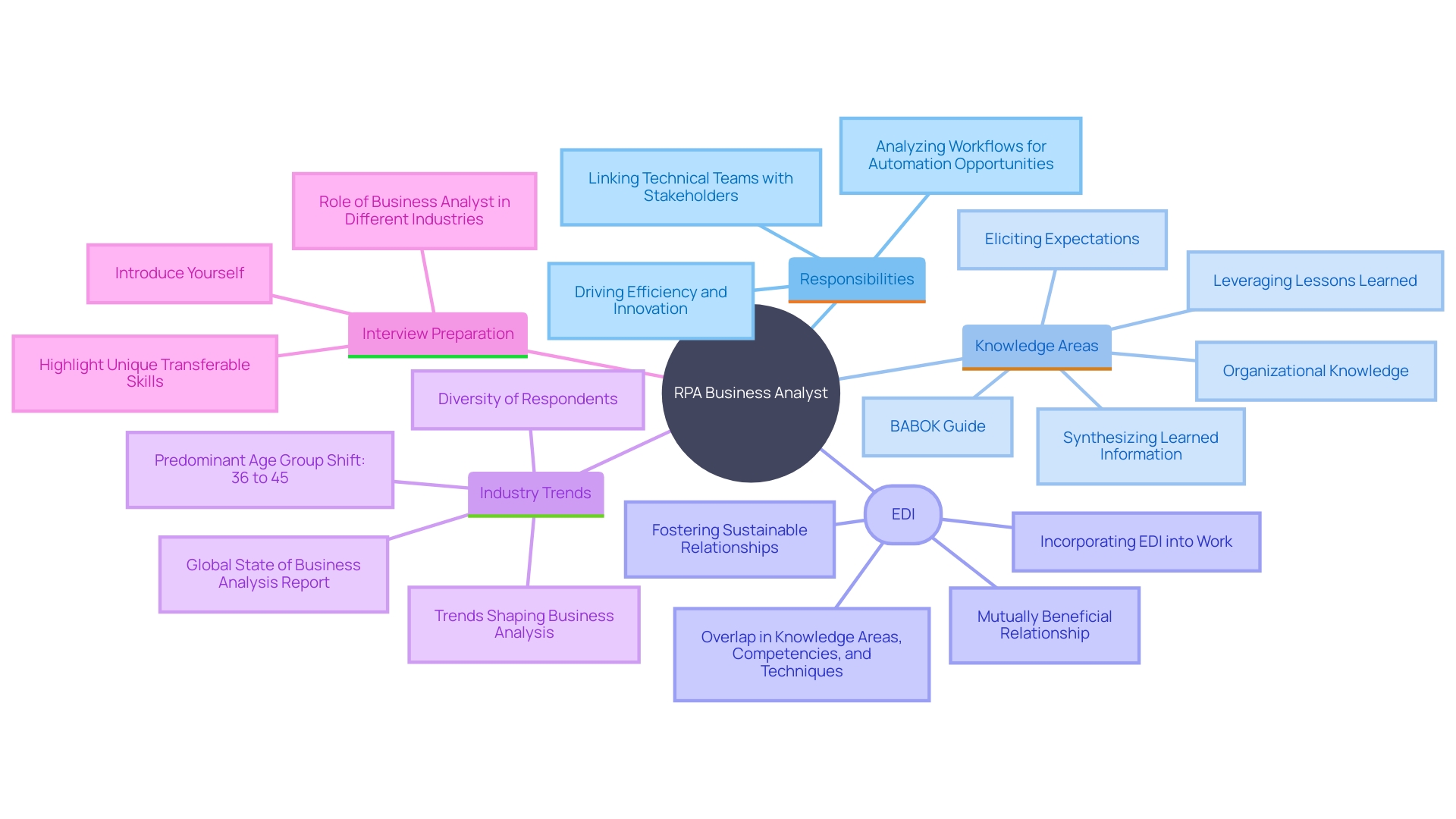
Key Benefits of RPA in Business Efficiency
Robotic Process Automation (RPA) offers transformative benefits that drastically elevate business efficiency. Leveraging RPA, companies can automate repetitive and rule-based tasks such as data entry and document processing, significantly reducing the time required to complete these tasks. This shift allows employees to redirect their focus towards higher-value activities, boosting productivity and enhancing job satisfaction.
The impact of RPA on operational accuracy and compliance cannot be overstated. By minimizing human errors typically associated with manual processes, RPA ensures a higher level of precision and adherence to regulatory standards. For instance, RobosizeME’s collaboration with Louvre Hotels Group exemplifies the potential of RPA; the mechanization of rate code maintenance saved the hotel chain an impressive 574 hours monthly, showcasing the immense efficiency gains achievable through mechanized processes.
Moreover, mechanization speeds up turnaround times, thereby enhancing customer satisfaction and competitive edge. A McKinsey study emphasizes this by forecasting that companies will dedicate over 25% of their capital to mechanization solutions in the coming years. This trend highlights the strategic importance of RPA in maintaining a competitive edge in the market.
RPA’s benefits extend beyond large enterprises to small and medium-sized enterprises (SMEs), which often hesitate to adopt automation due to perceived high costs and complexity. However, the real-world successes in various industries illustrate that RPA can be a game-changer, promoting operational efficiency and resource optimization across the board. As companies continue to embrace RPA, they stand to achieve not only improved efficiency but also substantial gains in productivity and customer satisfaction.
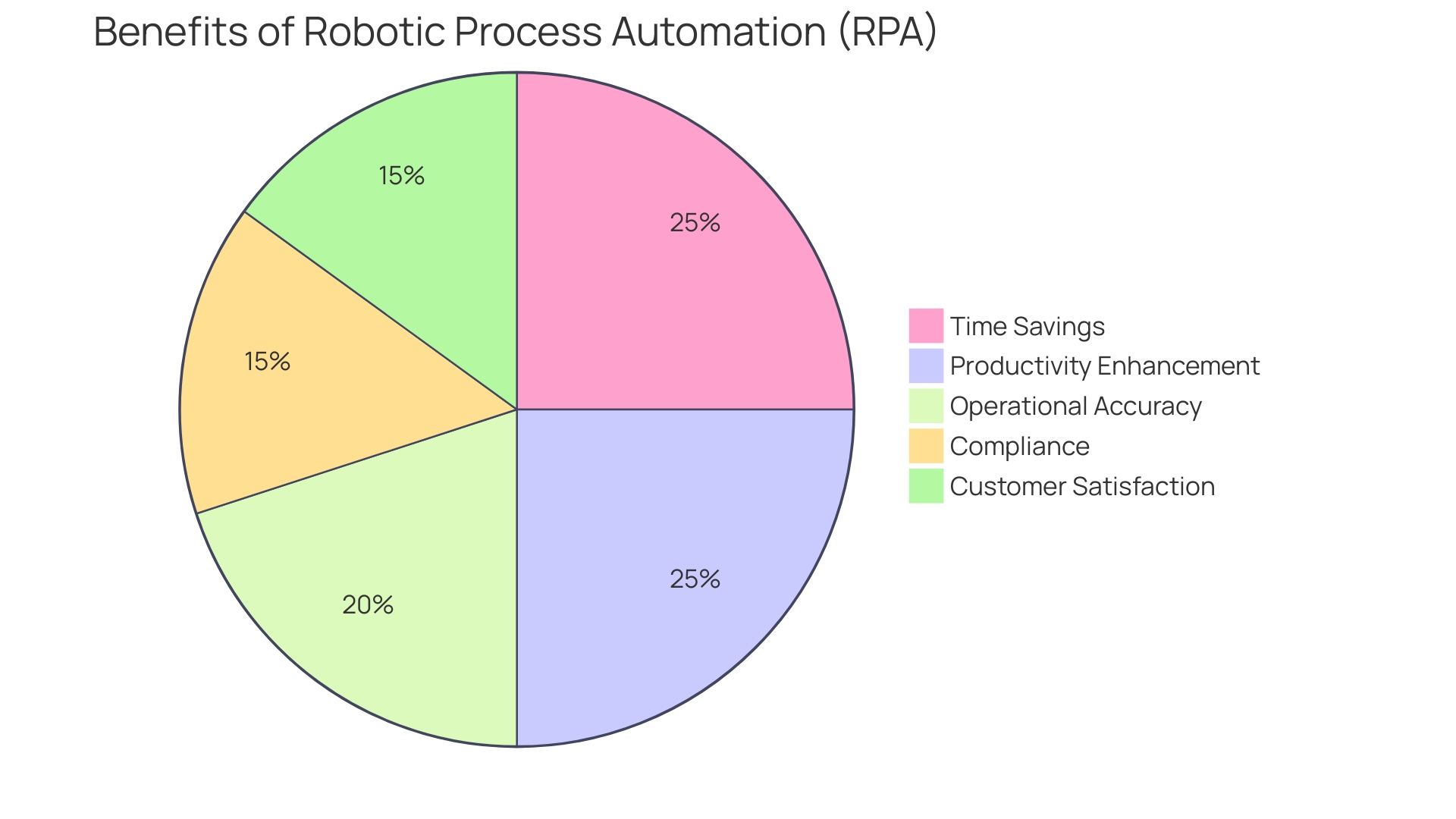
Challenges and Considerations in RPA Implementation
Implementing RPA offers substantial benefits but can also introduce several challenges. A significant obstacle is the resistance from employees who fear job displacement, underscoring the necessity for robust change management strategies. Clear communication and proper training are vital to ease these concerns. For instance, integrating RPA with existing systems can be complex, requiring a thorough assessment to ensure the technology is secure, appropriate, and compliant with necessary approvals.
A case study from the healthcare sector illustrates this well. The Digital Service Team conducts an initial assessment to determine if a new digital technology is already in use or if it meets security and compliance standards. This approach helps mitigate technical hurdles and ensures that the infrastructure supports RPA initiatives.
Moreover, insights from industry specialists such as David Truloff highlight the significance of risk evaluation in preserving the quality and safety of operations and systems. Organizations need to categorize, review, and monitor their operations consistently. This foundational step is crucial before adopting any advanced technologies, including RPA.
Statistics show that businesses using automated technologies can monitor more workers more of the time, expanding the scope of data collection and informed decision-making. While this can lead to higher productivity, it also highlights the need for balancing technological advancements with ethical considerations and employee collaboration.
In conclusion, overcoming these challenges requires a strategic approach that combines technical assessments, risk management, and strong communication to ensure a smooth and effective RPA implementation.
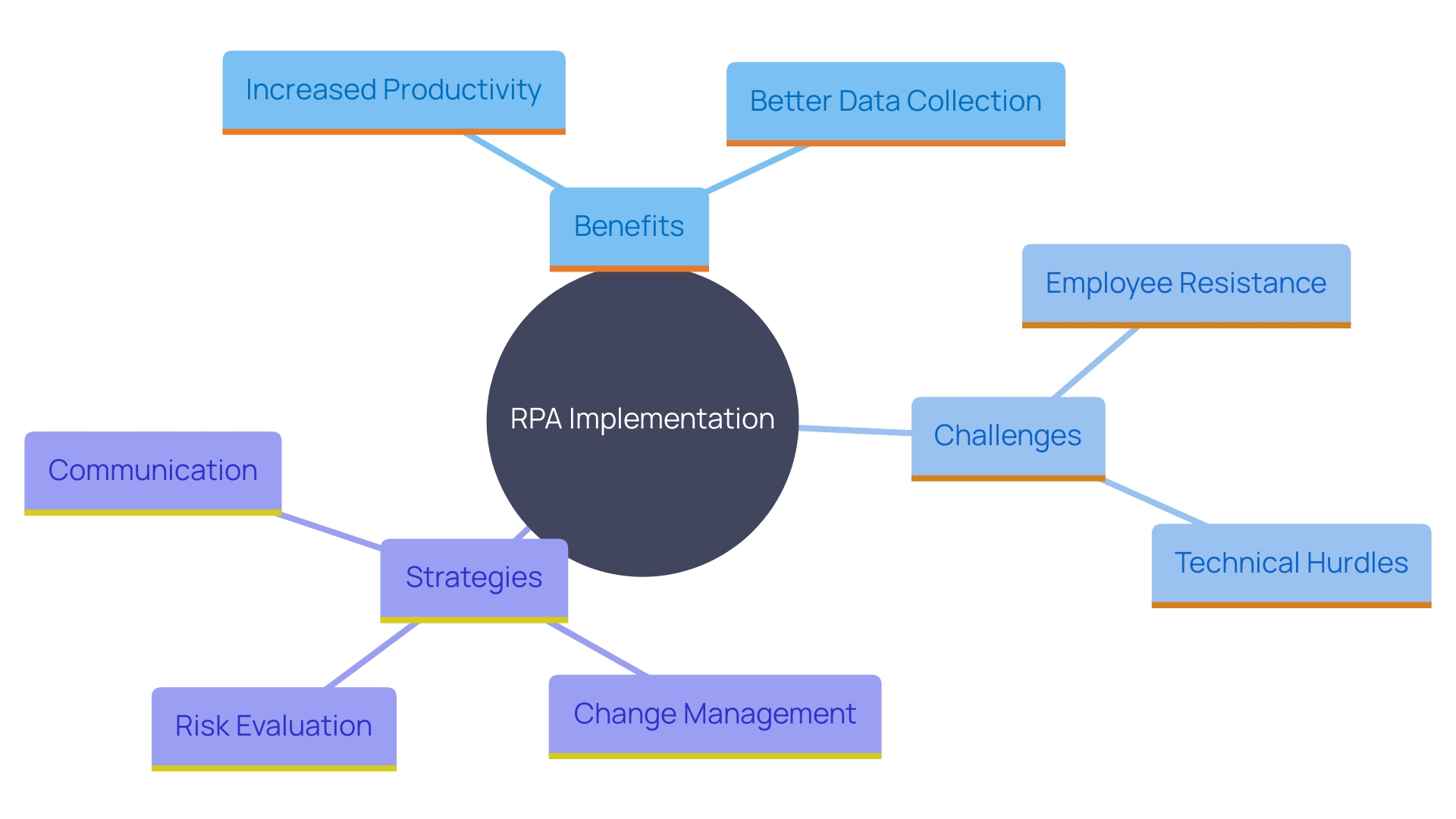
Strategies for Successful RPA Integration
Effective incorporation of RPA demands a strategic method, starting with a clear comprehension of goals and specific tasks for automation. Recognizing systems based on complexity and potential ROI is essential. For instance, automating manual, repetitive tasks often yields the most significant quick wins. As one expert notes, “Map the procedure and identify the stakeholders and systems involved.”. Once you have a list of possible candidates, compare complexity and estimated ROI.” This evaluation should encompass standards such as frequency of automated executions, potential monetary value, and peak demand periods.
Continuous monitoring and optimization are essential to maintain efficiency. For example, by assessing the time saved through mechanization compared to the manual process, organizations can quantify the benefits effectively. ‘Real-world applications, like the checkout-free store powered by Zippin technology in Dublin Airport, highlight the practical benefits of automated systems, such as eliminating queues and enhancing customer convenience.’.
Furthermore, promoting a culture of teamwork between IT and operational units is essential. This collaborative approach not only drives innovation but also helps in identifying new opportunities for automation. As the landscape of RPA and Intelligent Automation evolves, staying ahead requires a commitment to continuous improvement and strategic alignment with business goals.
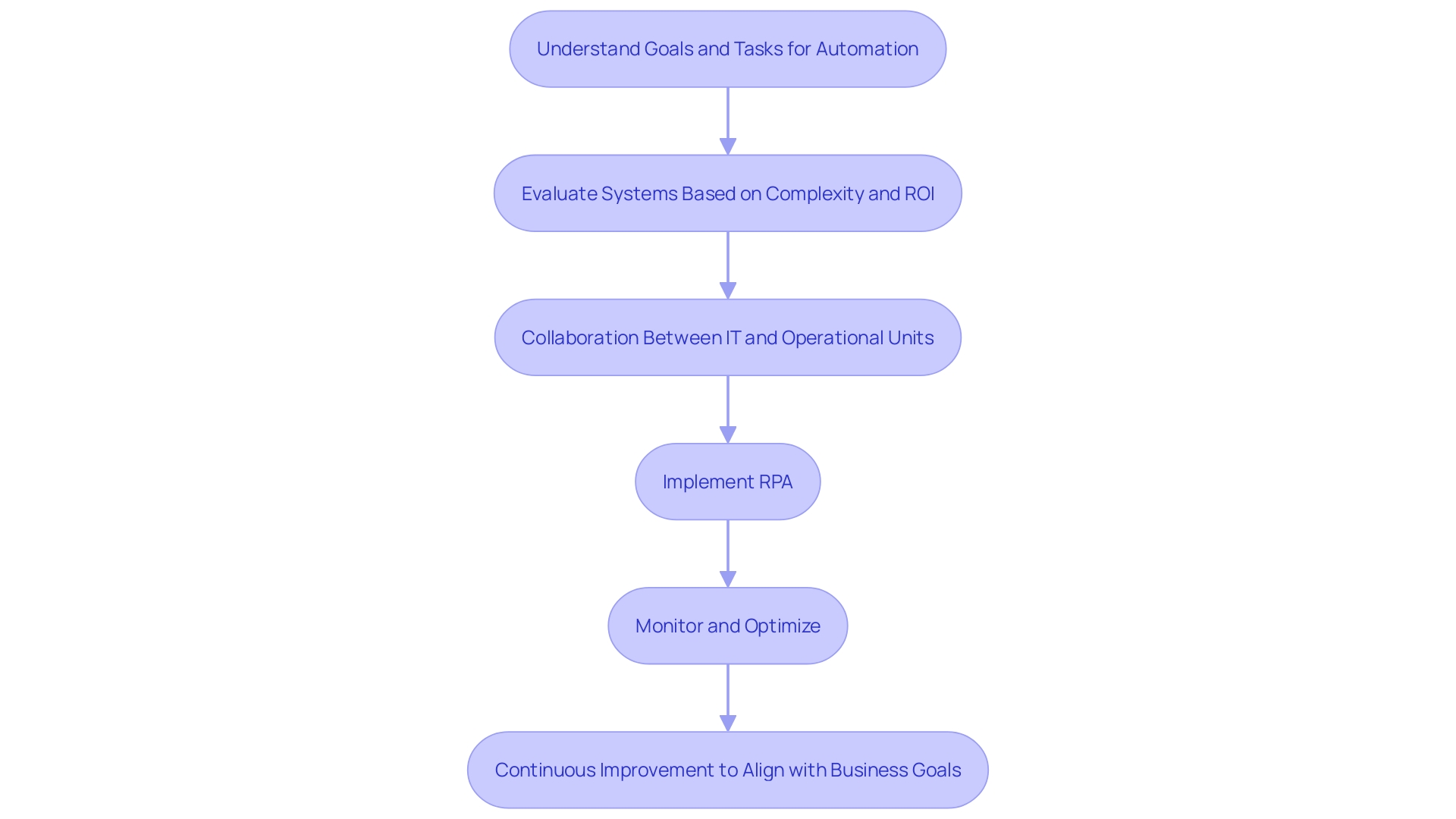
Conclusion
RPA Business Analysts play a crucial role in the successful deployment and management of robotic process automation systems, acting as a vital link between technology and business. Their ability to analyze workflows and identify automation opportunities leads to improved efficiency, reduced costs, and strategic alignment with organizational goals. As highlighted by industry trends, the importance of these professionals is only set to grow, emphasizing the need for businesses to leverage their expertise in navigating modern complexities.
The transformative benefits of RPA cannot be overstated. By automating repetitive tasks, organizations can significantly enhance productivity and accuracy while minimizing human error. This not only leads to better compliance with regulatory standards but also fosters a more satisfied workforce, as employees can concentrate on higher-value activities.
The successful implementation of RPA, as illustrated by various case studies, showcases its potential to deliver substantial efficiency gains across all types of enterprises.
However, the journey toward successful RPA integration is not without challenges. Resistance from employees, technical complexities, and the necessity for robust change management strategies must be addressed to ensure a smooth transition. Organizations are encouraged to adopt a strategic approach that involves thorough assessments, consistent monitoring, and fostering collaboration between IT and business units.
This proactive mindset is essential for overcoming obstacles and reaping the full benefits of RPA.
In summary, the integration of RPA is not merely a technological upgrade; it represents a fundamental shift in how businesses operate. By embracing the insights and strategies outlined, organizations can position themselves for sustainable growth and a competitive edge in an increasingly automated future.
